The Royal Palace in Phnom Penh is a 500x800 meter walled complex serving as the residence of King Norodom Sihamoni and former King Sihanouk. The grounds also house the 'Silver Pagoda' compound, open to the public except during official functions, with admission at 25,000 Riel (US$6.25). In contrast, Choeung Ek, a 17 km south site known as "The Killing Fields", marks the mass graves of over one million Khmer Rouge victims.
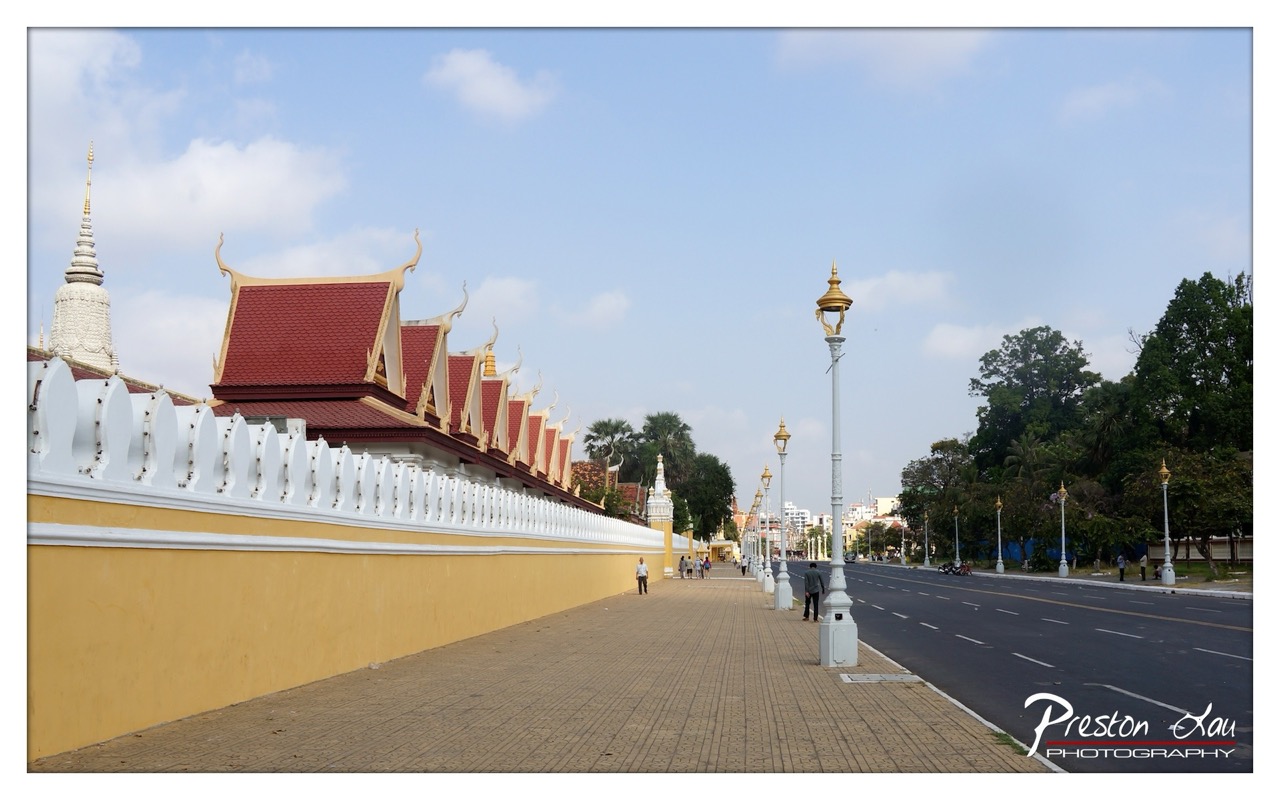

Error: HTTP 400 — {
"error": {
"message": "Failed to load model \\"qwen/qwen3-vl-30b\\". Error: Operation canceled.",
"type": "invalid_request_error",
"param": "model",
"code": null
}
}
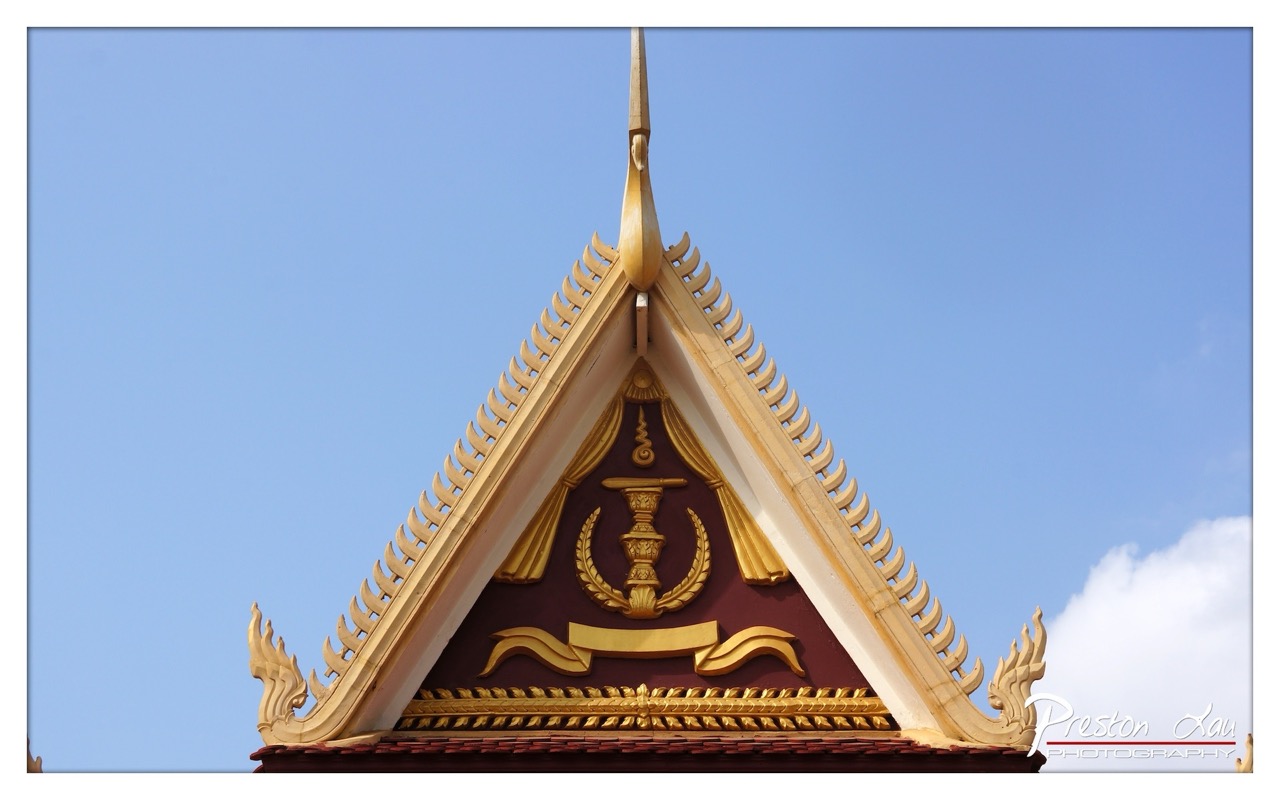

Error: HTTP 400 — {
"error": {
"message": "Failed to load model \\"qwen/qwen3-vl-30b\\". Error: Operation canceled.",
"type": "invalid_request_error",
"param": "model",
"code": null
}
}
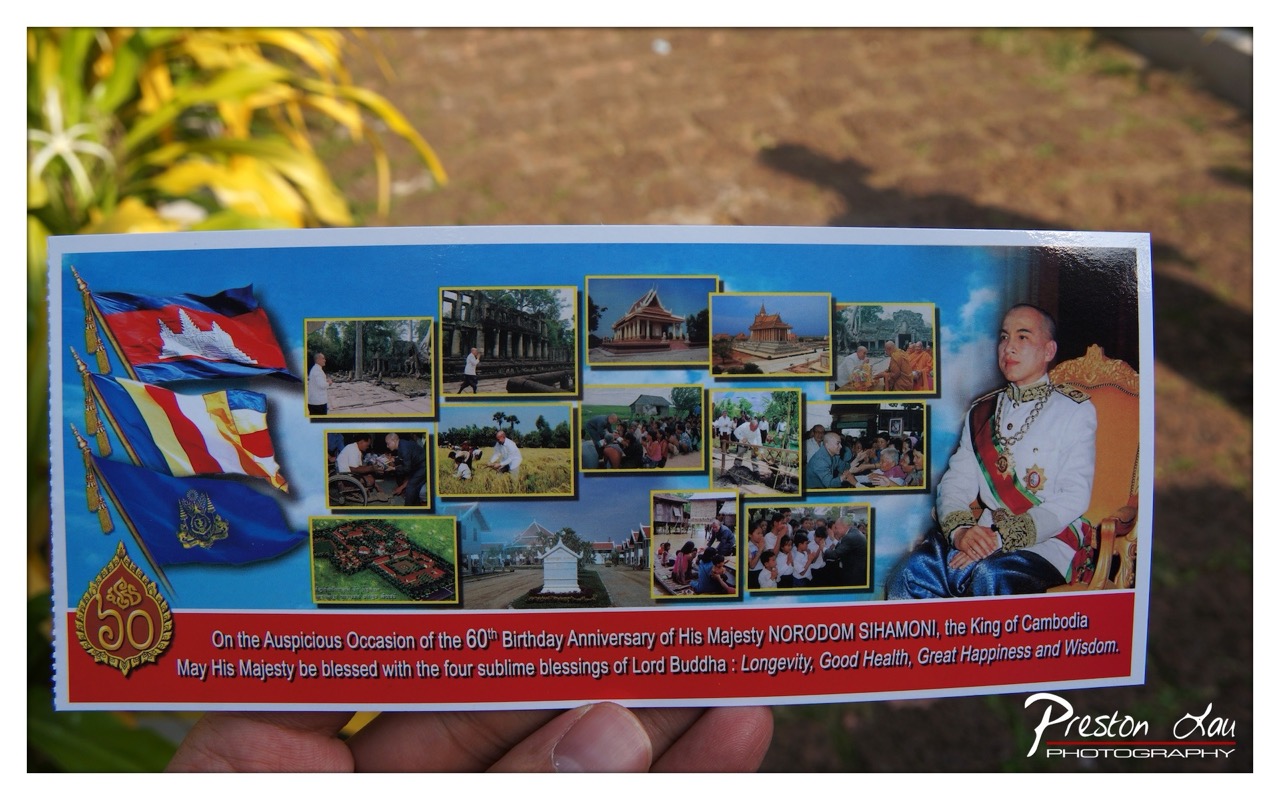

Error: HTTP 400 — {
"error": {
"message": "Failed to load model \\"qwen/qwen3-vl-30b\\". Error: Operation canceled.",
"type": "invalid_request_error",
"param": "model",
"code": null
}
}
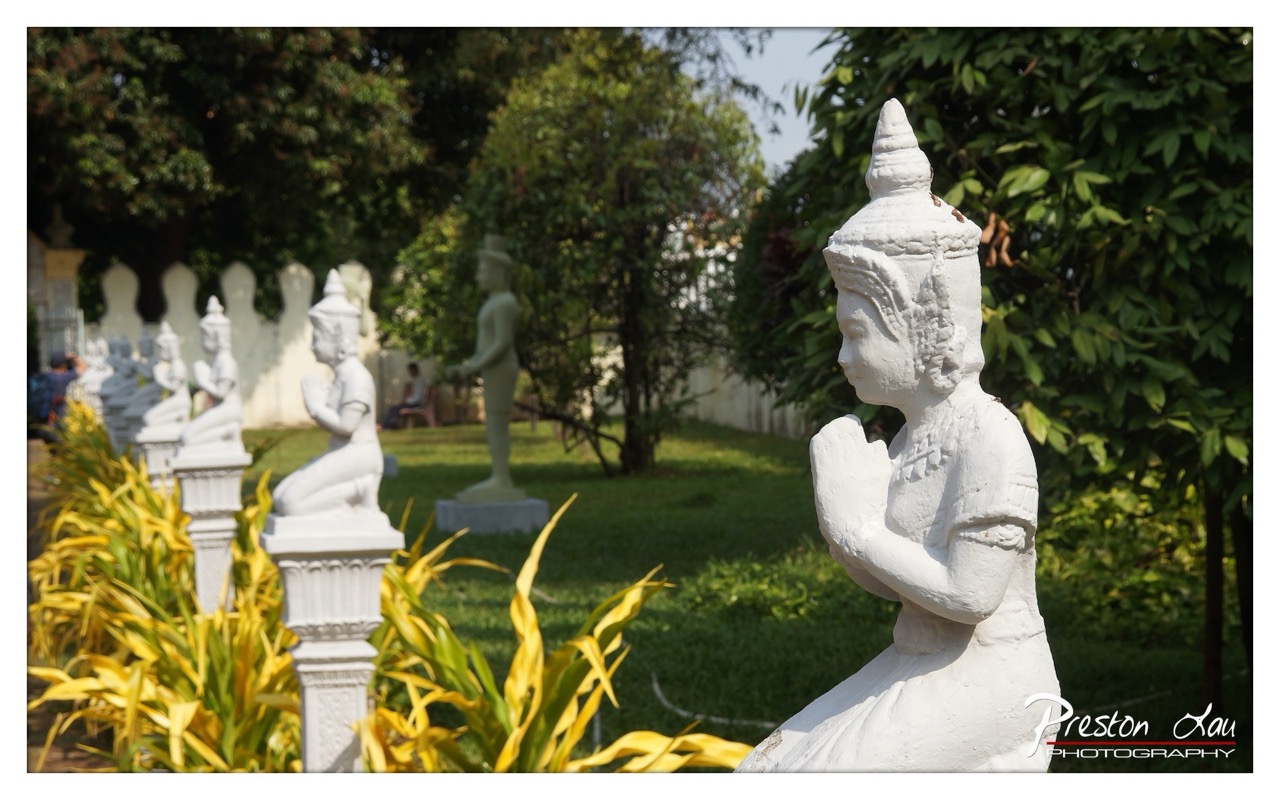

Error: HTTP 400 — {"error":"Model unloaded."}
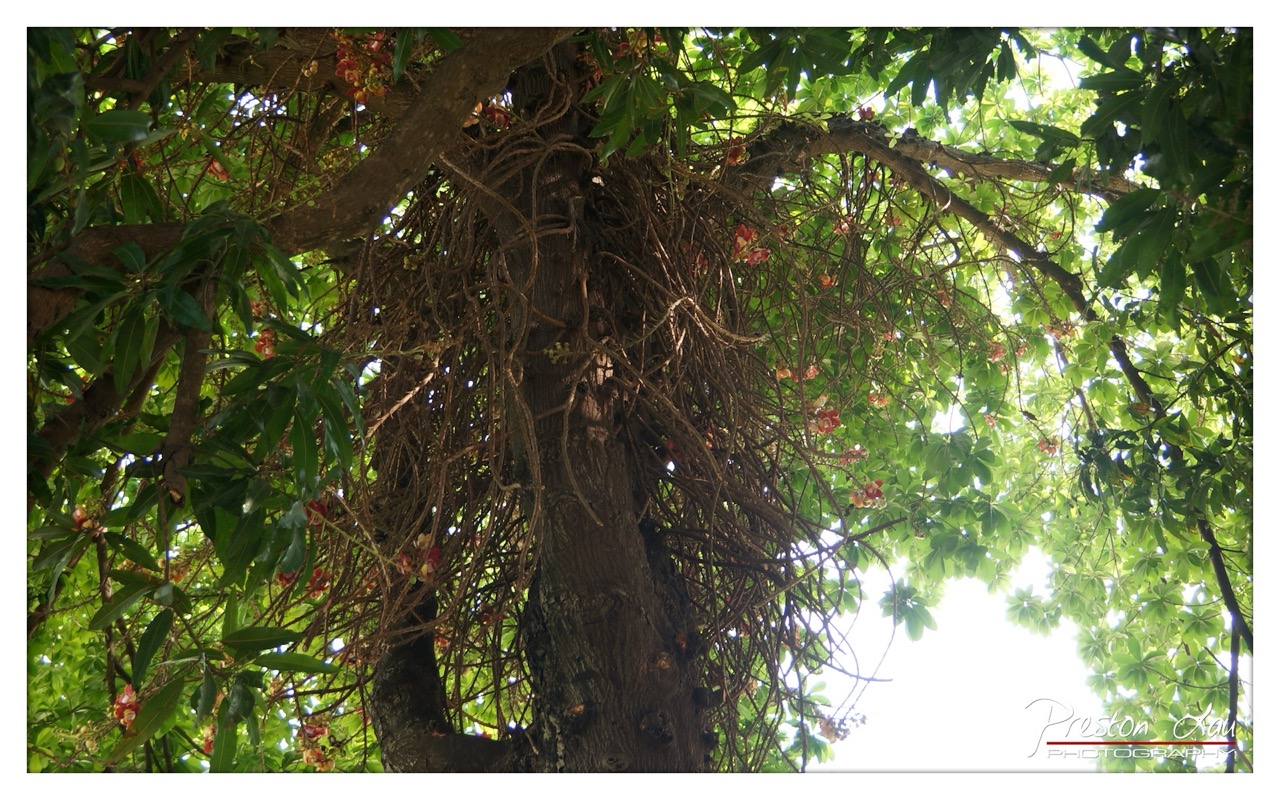

1. Overall Rating (0–10) — 7.5
This photograph captures the intricate beauty of a tree entwined with aerial roots and vibrant blossoms, evoking a sense of wild, untamed nature. The upward angle immerses the viewer in the canopy, emphasizing the organic complexity of the scene. While the image is rich in texture and detail, the overexposed sky slightly diminishes the visual harmony, pulling focus from the natural elegance of the subject.
2. Composition (0–10) — 7.0
The low-angle perspective creates a dynamic sense of scale and immersion, with the tree’s trunk anchoring the frame and the vines and leaves radiating outward. The natural asymmetry works well, guiding the eye through the dense foliage, though the right side feels slightly unbalanced due to the bright sky.
3. Lighting (0–10) — 6.5
Natural daylight illuminates the scene effectively, highlighting the textures of the bark and vines. However, the intense backlighting causes the sky to blow out, losing detail and creating a stark contrast that flattens the upper portion of the image.
4. Color & Tone (0–10) — 7.0
The palette is rich with deep greens and earthy browns, punctuated by the warm reds of the blossoms. The contrast between the dark foliage and the bright sky adds visual interest, though the overexposed area slightly reduces tonal depth in the highlights.
5. Creativity (0–10) — 7.5
The choice to capture the tree from below with a focus on the interplay between roots and blossoms demonstrates a thoughtful approach to natural form. The image feels both documentary and poetic, celebrating the quiet drama of growth in the wild.
6. Technical Quality (0–10) — 7.5
Sharp focus on the central trunk and vines enhances detail, and the clarity of the foliage is impressive. The slight overexposure in the sky is the primary technical flaw, but the overall image remains crisp and well-executed.
7. Emotional Impact (0–10) — 7.0
The photograph evokes a sense of awe and connection to nature’s resilience and complexity. The viewer is drawn into a quiet, almost sacred space within the tree’s canopy, where life thrives in intricate, layered abundance.
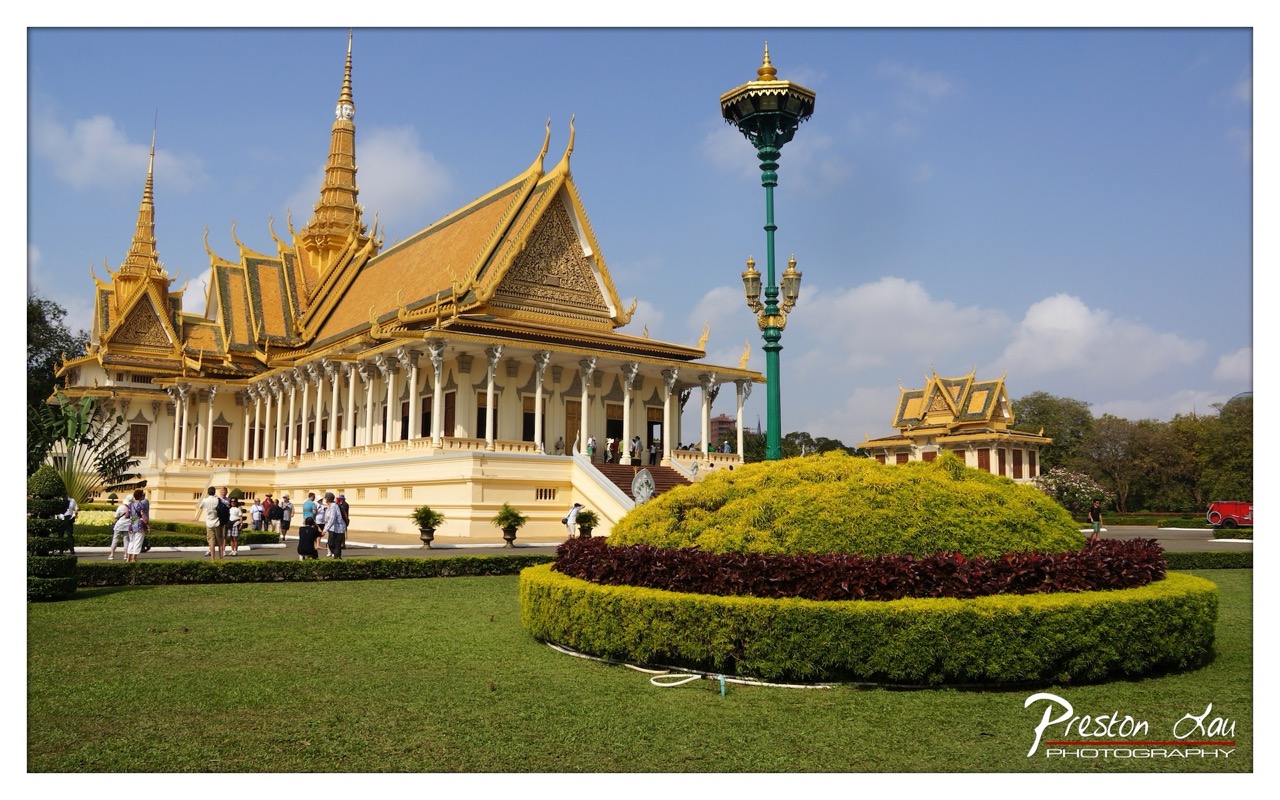

1. Overall Rating (0–10) — 8.0
This photograph captures the grandeur of the Royal Palace in Phnom Penh with a striking balance of cultural richness and visual harmony. The golden spires of the temple rise majestically against a clear blue sky, while the lush greenery and manicured gardens add a sense of order and tranquility. The inclusion of visitors grounds the image in reality, offering a sense of scale and human connection to the sacred space. While the composition is strong, a slightly more dynamic angle or tighter framing could elevate its artistic impact.
2. Composition (0–10) — 8.0
The image employs a balanced, wide-angle perspective that emphasizes the symmetry of the palace and the layered depth of the landscape. The circular hedge in the foreground acts as a natural frame, guiding the eye toward the central structure, while the lamppost on the right introduces a vertical counterpoint to the horizontal lines of the building. The placement of people along the walkway adds scale and narrative without distracting from the main subject.
3. Lighting (0–10) — 9.0
The bright, even daylight enhances the golden hues of the temple’s roof and highlights the intricate architectural details. The soft shadows beneath the eaves add dimension without obscuring key features, and the clear blue sky provides a clean, vibrant backdrop that contrasts beautifully with the warm tones of the structure.
4. Color & Tone (0–10) — 9.0
The palette is rich and harmonious, with the radiant gold of the temple contrasting elegantly against the deep green of the manicured hedges and the azure sky. The tones are vibrant yet natural, with a pleasing balance of warm and cool colors that contribute to the image’s regal and serene atmosphere.
5. Creativity (0–10) — 7.5
The photograph is grounded in a strong documentary style, capturing the site with clarity and respect. While the composition is conventional, the thoughtful arrangement of elements—especially the use of the hedge as a framing device—demonstrates a clear artistic intent. The image tells a story of cultural pride and spiritual significance, though it stops short of bold creative experimentation.
6. Technical Quality (0–10) — 9.0
The image is sharp and well-focused throughout, with excellent detail in both the foreground and background. The exposure is well-managed, with no blown-out highlights or lost shadows. The clarity of the textures—especially the ornate carvings and the lush foliage—reflects a high level of technical precision.
7. Emotional Impact (0–10) — 8.5
The photograph evokes a sense of awe and reverence, capturing the spiritual and cultural weight of the palace. The combination of architectural magnificence and human presence creates a feeling of shared heritage and quiet contemplation. The viewer is invited to appreciate not just the beauty of the scene, but also the deep cultural significance it represents.
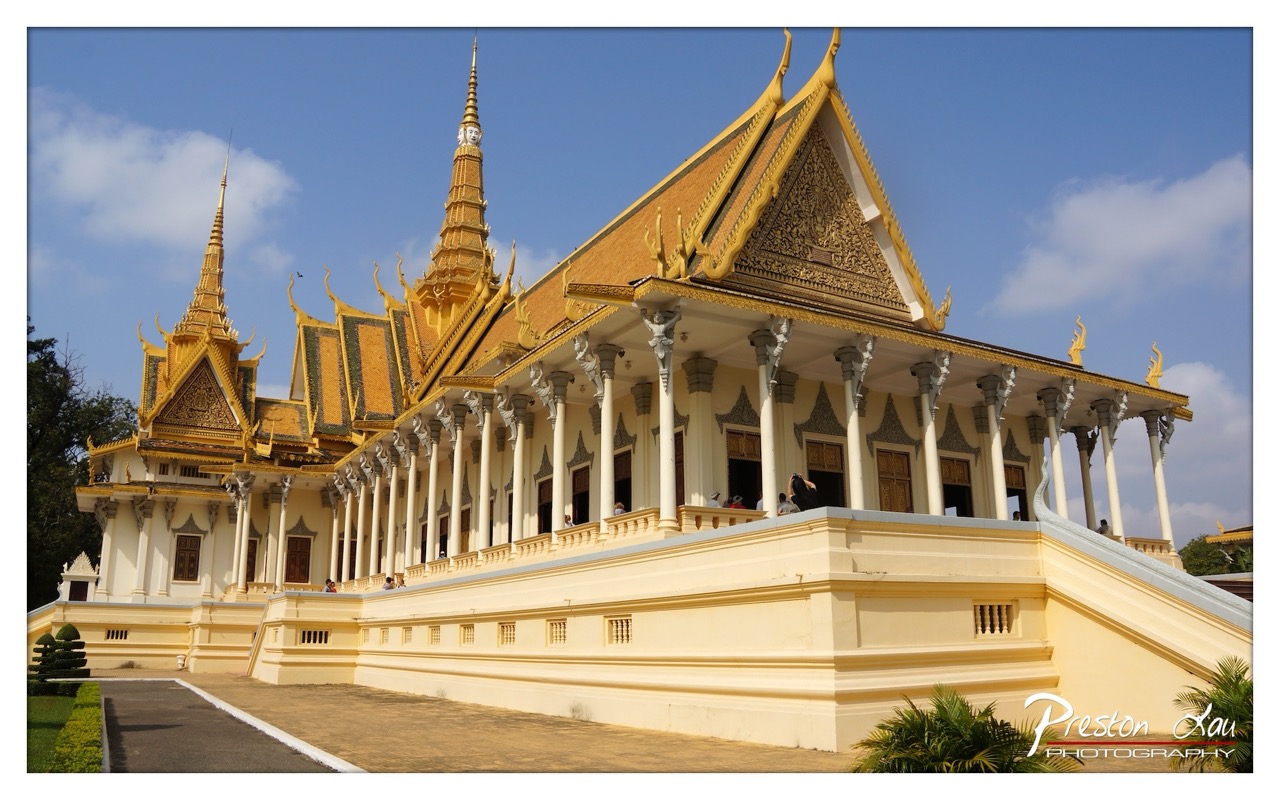

1. Overall Rating (0–10) — 8.0
This photograph captures the majestic splendor of a traditional Cambodian temple under a vibrant blue sky, where golden spires and ornate details gleam with cultural reverence. The composition balances architectural grandeur with a sense of openness, allowing the viewer to appreciate both the intricate craftsmanship and the scale of the structure. While the image is rich in visual detail, the slightly overexposed highlights on the golden roofs slightly diminish the subtlety of the textures.
2. Composition (0–10) — 8.0
The low-angle perspective emphasizes the temple’s verticality and dominance, while the diagonal sweep of the pathway draws the eye into the frame. The symmetry of the colonnade and tiered roofs creates a strong sense of order and rhythm.
3. Lighting (0–10) — 8.5
Bright, direct sunlight enhances the brilliance of the gold and highlights the architectural details, casting sharp shadows that add depth. The clear sky provides a clean backdrop, allowing the temple to stand out with striking clarity.
4. Color & Tone (0–10) — 8.5
The warm golden tones of the roof contrast beautifully with the cool blue sky, creating a visually harmonious and striking palette. The cream-colored walls provide a neutral canvas that allows the gold to shine without overwhelming the scene.
5. Creativity (0–10) — 7.5
The image is a strong, respectful representation of the temple’s cultural and architectural significance. While not radically innovative in approach, it effectively communicates the awe-inspiring nature of the site through thoughtful composition and lighting.
6. Technical Quality (0–10) — 9.0
The photograph is sharp and detailed, with excellent clarity in both the foreground and background. The exposure is well-managed, though the highlights on the gold elements show slight overexposure, indicating a minor technical limitation.
7. Emotional Impact (0–10) — 8.0
The image evokes a sense of reverence and wonder, capturing the spiritual and historical weight of the temple. The grandeur of the architecture, combined with the bright, open atmosphere, invites contemplation and admiration.
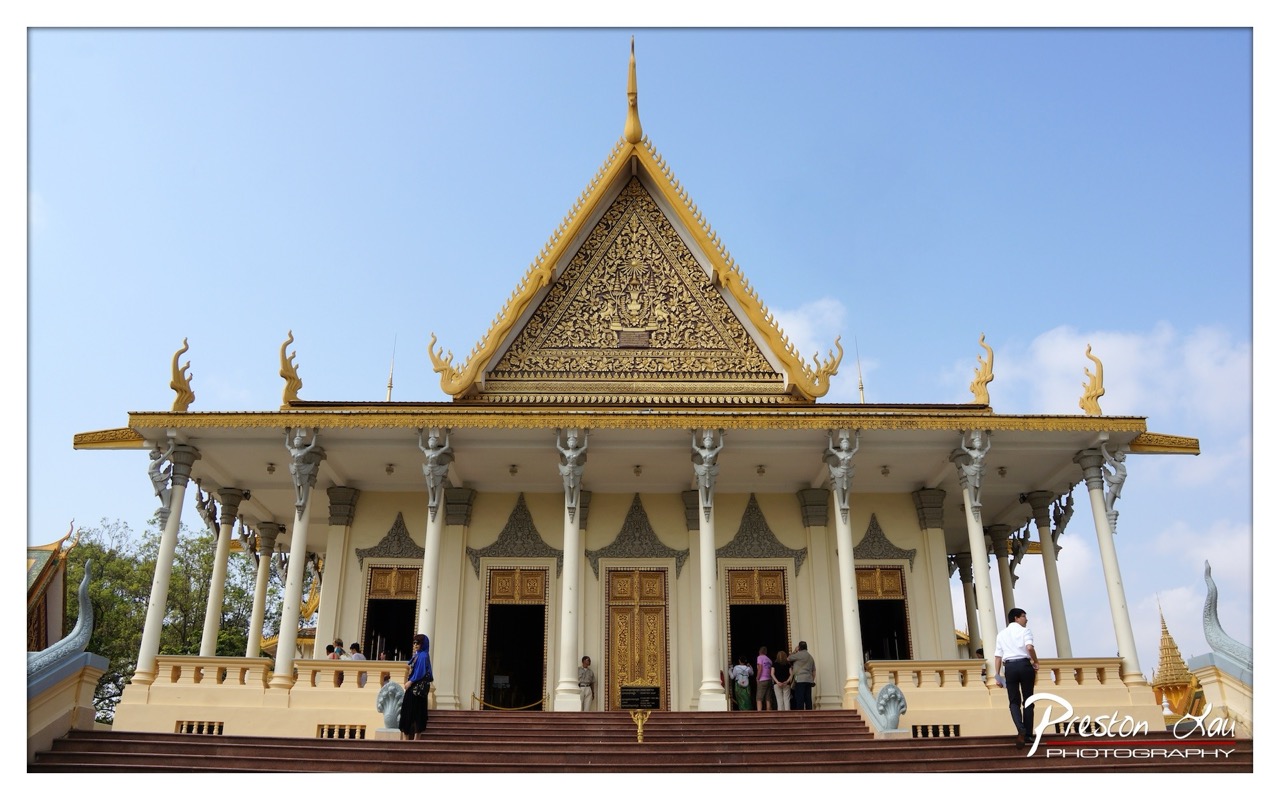

1. Overall Rating (0–10) — 8.0
This photograph captures the regal grandeur of a Cambodian temple with striking clarity and reverence, where architecture and culture converge in a single frame. The golden spires and intricate carvings stand out against the clear blue sky, evoking a sense of awe and timelessness. While the presence of visitors grounds the image in reality, the composition remains balanced and visually compelling, making it both a cultural document and an artistic statement.
2. Composition (0–10) — 8.5
The low-angle perspective emphasizes the temple’s verticality and dominance, drawing the eye upward toward the ornate roof. The symmetry of the structure is well-framed, with the central entrance acting as a natural focal point, while the surrounding figures add scale and narrative context without disrupting harmony.
3. Lighting (0–10) — 8.0
Bright, even daylight enhances the richness of the gold accents and the cream-colored façade, creating a warm, inviting glow. The clear sky provides a clean backdrop, allowing the architectural details to stand out with minimal distraction.
4. Color & Tone (0–10) — 8.5
The palette is harmonious, with the radiant golds and soft creams contrasting beautifully against the serene blue of the sky. The warm tones evoke a sense of spiritual elevation, while the subtle variations in shade add depth and texture to the image.
5. Creativity (0–10) — 8.0
The photograph successfully blends architectural grandeur with human presence, transforming a simple travel shot into a story of cultural reverence. The choice to include visitors adds life and relatability, while the composition elevates the temple beyond mere spectacle.
6. Technical Quality (0–10) — 9.0
Sharp focus, accurate exposure, and clean detail throughout the image reflect strong technical execution. The clarity of the intricate carvings and the crispness of the sky indicate a high level of photographic precision.
7. Emotional Impact (0–10) — 8.5
The image conveys a deep sense of reverence and wonder, inviting the viewer to pause and reflect on the beauty and history of the temple. The interplay of light, scale, and human interaction fosters a quiet emotional connection, evoking both admiration and curiosity.
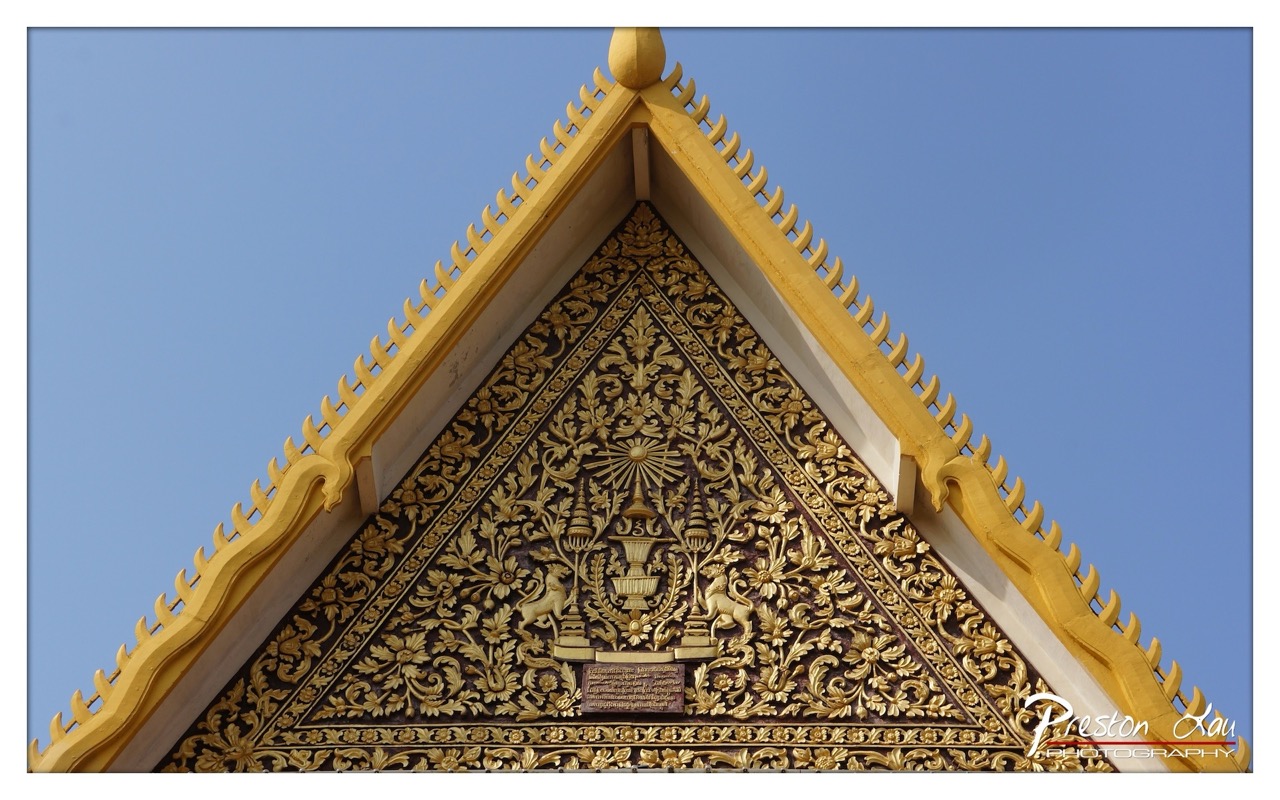

1. Overall Rating (0–10) — 8.5
This photograph captures the ornate grandeur of a traditional Southeast Asian temple gable with striking clarity and reverence. The contrast between the radiant gold carvings and the deep blue sky elevates the structure into a symbol of cultural and spiritual significance. While the image is visually commanding, the tight framing and lack of human presence keep it from fully conveying the sacred atmosphere of the site.
2. Composition (0–10) — 9.0
The symmetrical triangular framing centers the intricate carvings perfectly, emphasizing the architectural harmony and balance. The upward angle reinforces the monumentality of the structure, drawing the viewer’s eye toward the apex with intention and focus.
3. Lighting (0–10) — 9.0
Bright, direct sunlight enhances the texture and depth of the gilded relief, creating sharp highlights and shadows that accentuate the three-dimensional craftsmanship. The clear sky provides a clean, uncluttered backdrop that allows the details to stand out vividly.
4. Color & Tone (0–10) — 9.0
The rich golden hues of the carvings contrast beautifully with the deep azure of the sky, creating a vibrant and harmonious palette. The tonal range is well-balanced, with the dark recesses of the carving adding depth and contrast to the luminous gold.
5. Creativity (0–10) — 8.0
The image is a strong visual celebration of cultural artistry, using composition and light to highlight the sacred geometry of the design. While the approach is straightforward, the choice to isolate the gable from its surroundings allows the viewer to appreciate the craftsmanship as a standalone work of art.
6. Technical Quality (0–10) — 9.0
The sharp focus and fine detail throughout the image reveal the intricate craftsmanship with precision. The exposure is well-managed, capturing both the brightness of the gold and the clarity of the sky without overexposure or loss of detail.
7. Emotional Impact (0–10) — 8.0
The photograph evokes a sense of awe and reverence, inviting the viewer to contemplate the devotion and skill embedded in the architecture. The stillness of the image and the majesty of the design create a meditative quality, suggesting quiet spiritual significance.
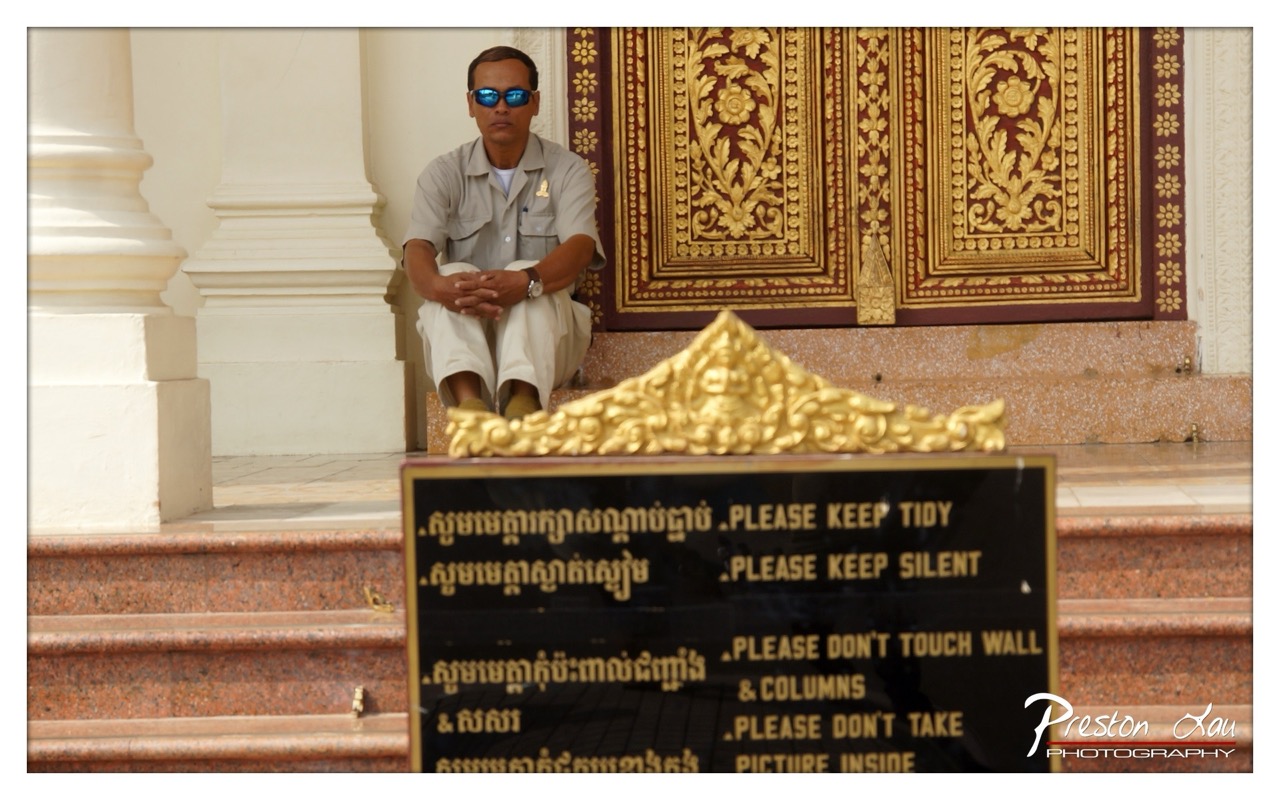

1. Overall Rating (0–10) — 7.0
This photograph captures a striking juxtaposition between tradition and modernity, with a security guard seated solemnly before ornate temple doors. The rich gold detailing and cultural signage create a sense of reverence, while the man’s sunglasses and casual posture introduce a contemporary, almost anachronistic element. The image balances documentary realism with subtle storytelling, though the slightly cluttered foreground and flat lighting prevent it from achieving greater visual depth.
2. Composition (0–10) — 6.5
The subject is centered and framed by architectural elements, creating a balanced, symmetrical composition. However, the large sign in the foreground disrupts the visual flow and partially obscures the lower half of the figure, reducing compositional harmony.
3. Lighting (0–10) — 6.0
The lighting is bright and even, likely midday, which clearly illuminates the scene but flattens the shadows and diminishes the richness of the golden details. The reflective sunglasses further obscure the subject’s expression, limiting emotional engagement.
4. Color & Tone (0–10) — 7.5
The warm golds of the doors and crown-like ornamentation contrast effectively with the neutral tones of the man’s uniform and the red granite steps. The color palette is cohesive and culturally evocative, though slightly muted by the bright, overexposed light.
5. Creativity (0–10) — 7.0
The image succeeds in capturing a moment of quiet contrast between duty and devotion, using the juxtaposition of modern attire and sacred surroundings to suggest a deeper narrative. The inclusion of the bilingual signage adds layers of cultural context and global awareness.
6. Technical Quality (0–10) — 7.5
The image is sharp and well-focused, particularly on the central figure and the sign. The depth of field is adequate, though the foreground sign slightly softens the overall clarity.
7. Emotional Impact (0–10) — 6.5
The photograph conveys a sense of quiet dignity and solemnity, but the subject’s impassive expression and the intrusive sign keep the viewer at a distance. The emotional resonance is present but restrained, leaving room for interpretation rather than direct connection.
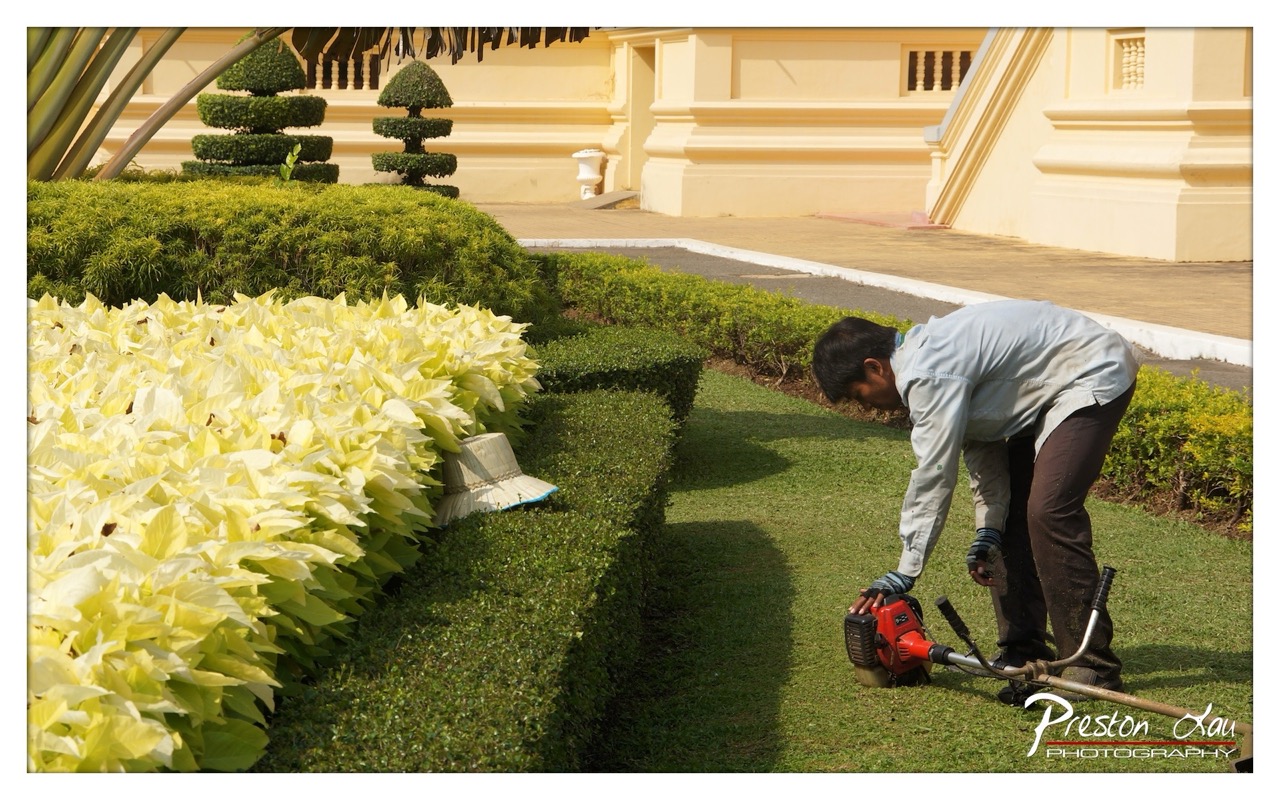

1. Overall Rating (0–10) — 7.0
This photograph captures a moment of quiet labor within a meticulously maintained garden, where the contrast between human effort and natural beauty creates a compelling narrative. The warm sunlight enhances the textures of the foliage and the man’s focused posture, lending the scene a sense of dignity and purpose. While the composition is strong, a more dynamic perspective could elevate the image from a snapshot to a fully realized statement on craftsmanship and care.
2. Composition (0–10) — 7.0
The diagonal line of the hedge guides the eye from the vibrant yellow flowers toward the gardener, creating a natural flow. The subject is placed off-center, offering balance while emphasizing the expansive green space. The inclusion of the yellow building in the background adds depth without overwhelming the scene.
3. Lighting (0–10) — 8.0
The bright, directional sunlight casts soft shadows that accentuate the texture of the grass, flowers, and trimmed hedges. The warm golden hour light enhances the colors and gives the image a serene, almost painterly quality.
4. Color & Tone (0–10) — 7.5
The vivid yellow of the flowers contrasts beautifully with the lush greenery and the pale yellow of the building, creating a harmonious and inviting palette. The tones are rich but not oversaturated, with a subtle warmth that supports the tranquil mood.
5. Creativity (0–10) — 7.0
The image captures an everyday moment with artistic sensitivity, highlighting the harmony between human activity and nature. The inclusion of the ornate topiary and the clean lines of the landscape suggest a deeper cultural context, adding layers to the visual narrative.
6. Technical Quality (0–10) — 8.0
The image is sharp, with clear detail in both the foreground and background. The focus is well-placed on the gardener, and the exposure is balanced, preserving detail in both highlights and shadows.
7. Emotional Impact (0–10) — 7.5
There is a quiet dignity in the gardener’s concentration, evoking respect for the unseen labor that maintains such beauty. The scene feels peaceful and grounded, inviting the viewer to reflect on the care and precision behind cultivated landscapes.
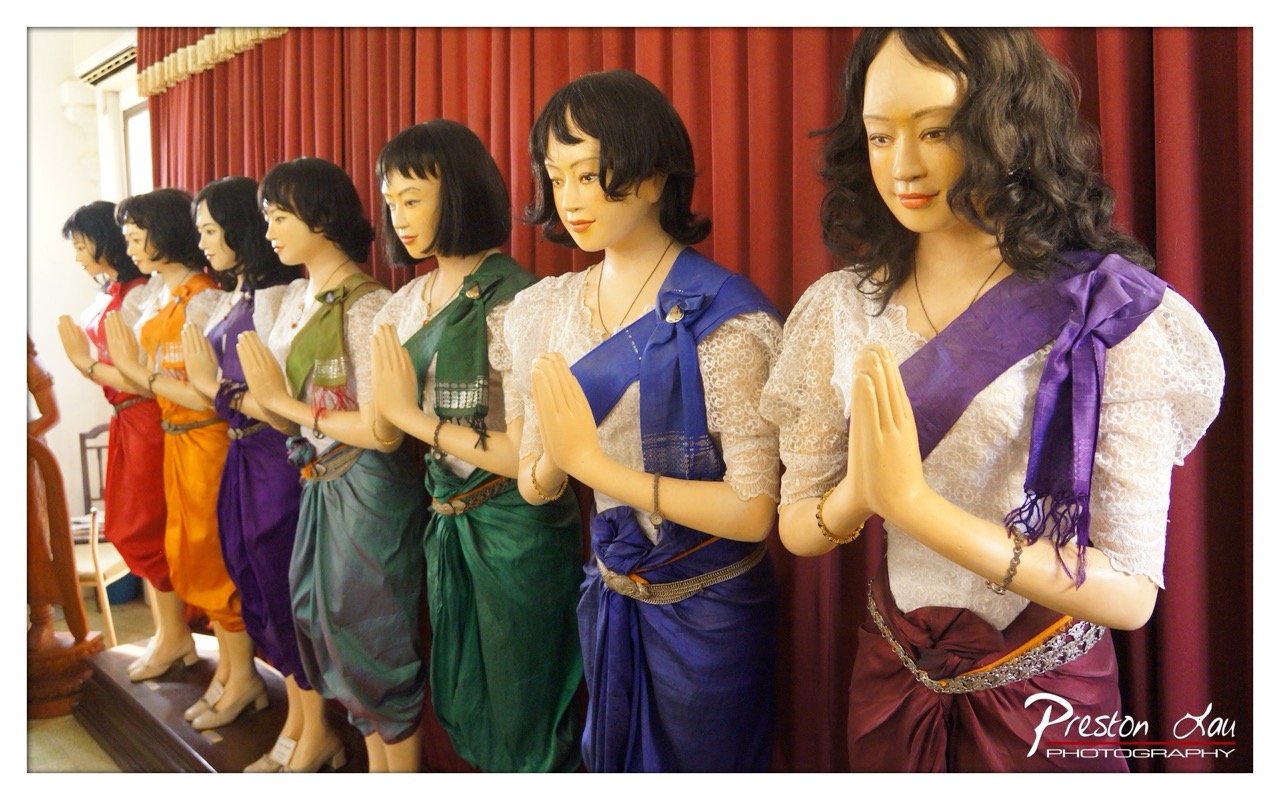

1. Overall Rating (0–10) — 7.0
This photograph captures a striking and culturally rich display of mannequins dressed in traditional Southeast Asian attire, arranged in a line with hands pressed together in a respectful greeting. The vibrant colors and ceremonial pose evoke a sense of tradition and reverence, while the uniformity of the figures creates a rhythmic visual flow. Though the image is compelling in its subject and composition, the slightly awkward framing and flat lighting prevent it from achieving greater emotional resonance or artistic polish.
2. Composition (0–10) — 7.0
The diagonal line of figures creates a strong sense of depth and movement, guiding the eye from the foreground to the background. The alignment of the mannequins enhances symmetry and rhythm, though the slight imbalance in framing and the visible edge of the platform on the left introduce a minor compositional distraction.
3. Lighting (0–10) — 5.5
The lighting is even and functional, likely from an indoor source, but lacks directional quality or dynamic contrast. While it clearly illuminates the subjects, the flatness of the light diminishes texture and depth, giving the image a slightly sterile feel that undercuts the richness of the fabrics and expressions.
4. Color & Tone (0–10) — 8.0
The rich, saturated hues of the traditional garments—deep purples, emerald greens, and royal blues—stand out vividly against the red curtain backdrop. The color palette is harmonious and culturally evocative, with a warm overall tone that enhances the ceremonial mood of the scene.
5. Creativity (0–10) — 7.5
The choice to photograph mannequins in traditional dress presents a unique juxtaposition of cultural representation and artificiality. The image invites contemplation on identity, performance, and heritage, offering a layered narrative that goes beyond a simple documentation of costume.
6. Technical Quality (0–10) — 7.5
The image is sharp and detailed, with clear focus across the line of figures. The watermark is discreet, and the exposure is well-balanced, though the image lacks the refinement of professional lighting or post-processing that could enhance its visual impact.
7. Emotional Impact (0–10) — 6.5
The image conveys a sense of quiet dignity and cultural pride, but the artificiality of the mannequins creates a subtle emotional distance. The viewer is invited to appreciate the beauty of the attire and gesture, yet the lack of human presence limits the depth of emotional connection.
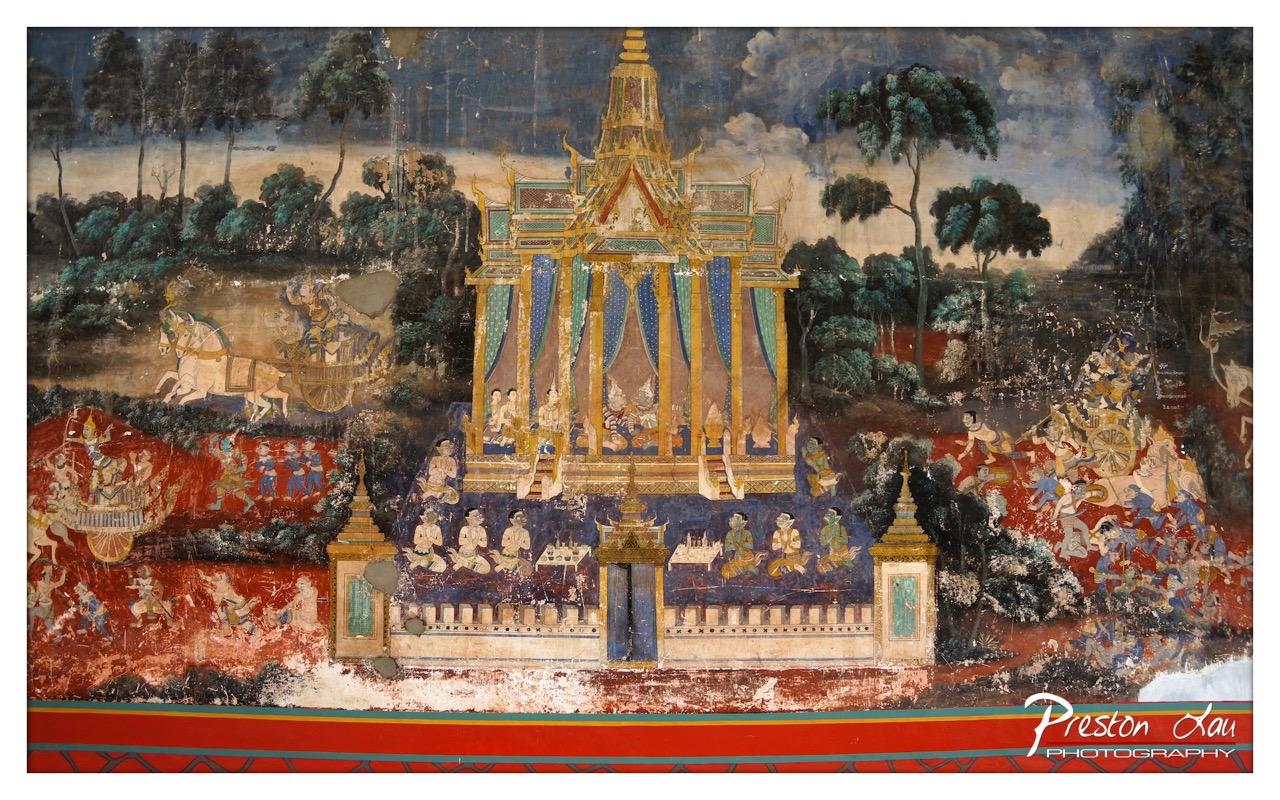

1. Overall Rating (0–10) — 7.5
This photograph captures the rich narrative and vibrant detail of a traditional Thai mural, showcasing a scene of royal or religious significance with an almost cinematic depth. The composition draws the eye into the layered storytelling, while the aged texture of the paint adds a palpable sense of history and authenticity. Though the image is slightly dark and the colors muted, the sheer complexity of the scene compensates, offering a visually dense and culturally resonant experience.
2. Composition (0–10) — 8.0
The central temple structure anchors the image, creating a strong focal point, while the surrounding figures and scenes unfold symmetrically on either side, guiding the viewer’s gaze across the mural’s narrative. The inclusion of the red border at the bottom grounds the composition and enhances the sense of ritual framing.
3. Lighting (0–10) — 6.0
The lighting is flat and somewhat dim, likely due to indoor conditions, which dulls the vibrancy of the colors and obscures subtle details. A more direct light source would have revealed greater texture and depth in the paint.
4. Color & Tone (0–10) — 7.0
The palette is rich with deep blues, golds, and reds, typical of traditional Thai temple art. While the colors are somewhat subdued due to lighting, the tonal contrast between the dark background and the bright golden accents enhances the visual hierarchy and cultural authenticity.
5. Creativity (0–10) — 8.0
The photograph captures a living piece of cultural heritage with respect and attention to detail. The framing emphasizes the mural’s narrative complexity, and the inclusion of the photographer’s watermark subtly asserts authorship without disrupting the image’s historical integrity.
6. Technical Quality (0–10) — 7.5
The image is sharp and clear, allowing viewers to discern fine details in the painted figures and architectural elements. The focus is consistent across the frame, though slight underexposure limits the richness of the color reproduction.
7. Emotional Impact (0–10) — 7.0
The mural evokes a sense of reverence and timelessness, inviting contemplation of the stories and beliefs embedded in its layers. The viewer is drawn into a world of myth and tradition, where every figure and gesture carries meaning, even if not immediately apparent.
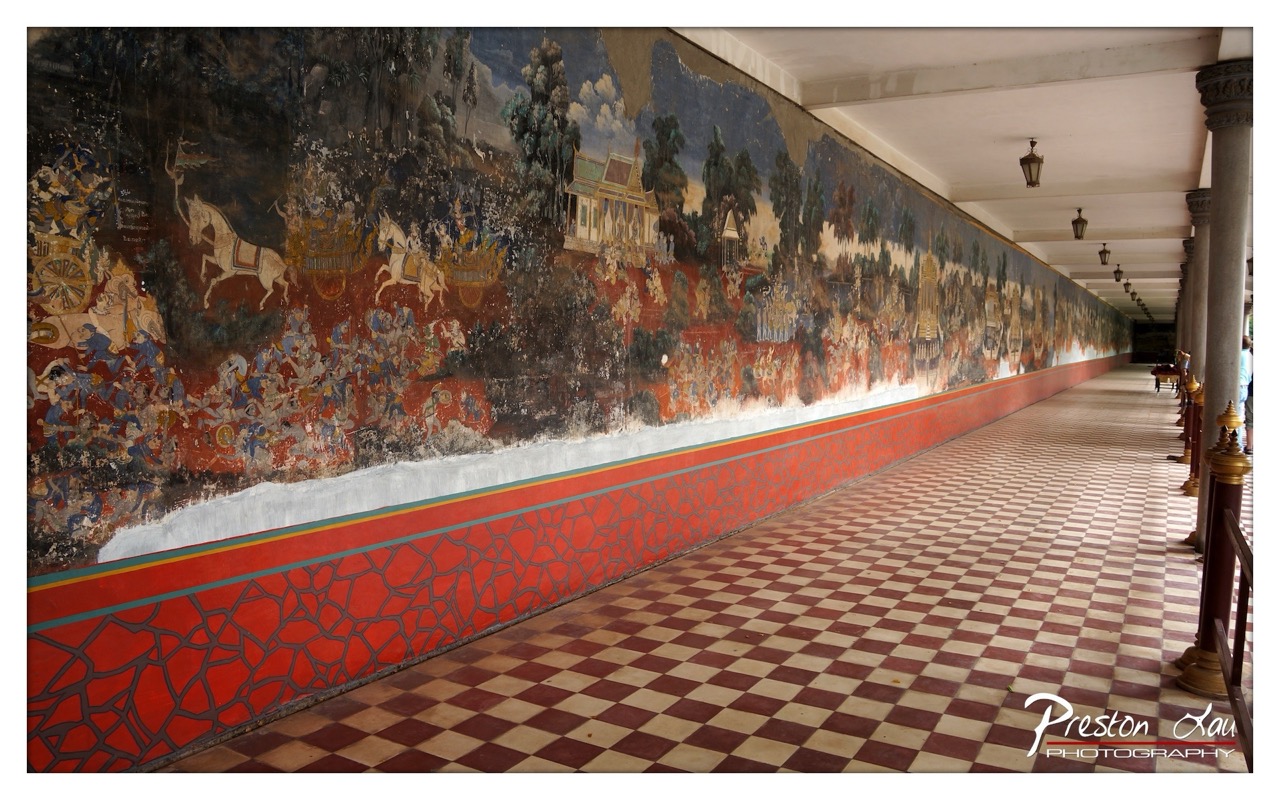

1. Overall Rating (0–10) — 7.5
This photograph captures the grandeur and historical weight of a long, painted mural corridor, where tradition and time converge in a single, sweeping view. The composition draws the eye down the hall, emphasizing the scale and detail of the artwork, while the checkered floor adds rhythm and depth. Though the murals show signs of age, their vibrant storytelling and cultural richness lend the scene a quiet dignity, though the image could benefit from stronger contrast to elevate the colors and details.
2. Composition (0–10) — 8.0
The use of leading lines from the checkered floor and the long wall guides the viewer’s eye naturally through the space, creating a sense of depth and continuity. The mural is framed well, with the colonnade on the right balancing the visual weight of the artwork, though the slight tilt of the horizon subtly disrupts perfect symmetry.
3. Lighting (0–10) — 6.5
The ambient light is soft and even, likely from natural sources and supplemented by hanging lanterns, which cast a warm, subdued glow. While adequate for capturing the scene, the lighting lacks dramatic contrast, muting some of the mural’s textures and color variations.
4. Color & Tone (0–10) — 7.0
The palette balances deep reds, earthy browns, and muted golds with the neutral tones of the floor and columns, creating a harmonious, traditional aesthetic. The red mosaic border provides a strong visual anchor, though the overall tone is slightly flat, dampening the vibrancy of the mural’s more vivid elements.
5. Creativity (0–10) — 7.5
The photograph succeeds in capturing not just the physical space but also the narrative weight of the mural’s imagery—likely depicting a historical or religious epic. The choice to photograph the corridor in its entirety emphasizes the cultural significance of the artwork, presenting it as both a visual and historical document.
6. Technical Quality (0–10) — 7.5
The image is sharp and clear, with well-defined details in the mural and floor tiles. The focus is consistent across the frame, and there are no noticeable technical flaws such as blur or noise, though the slightly overexposed ceiling and shadows in the recesses suggest room for improved exposure control.
7. Emotional Impact (0–10) — 7.0
The image evokes a sense of reverence and contemplation, inviting the viewer to reflect on the passage of time and the endurance of cultural storytelling. The quiet, almost meditative atmosphere of the corridor resonates emotionally, though the lack of human presence keeps the mood somewhat detached and observational.
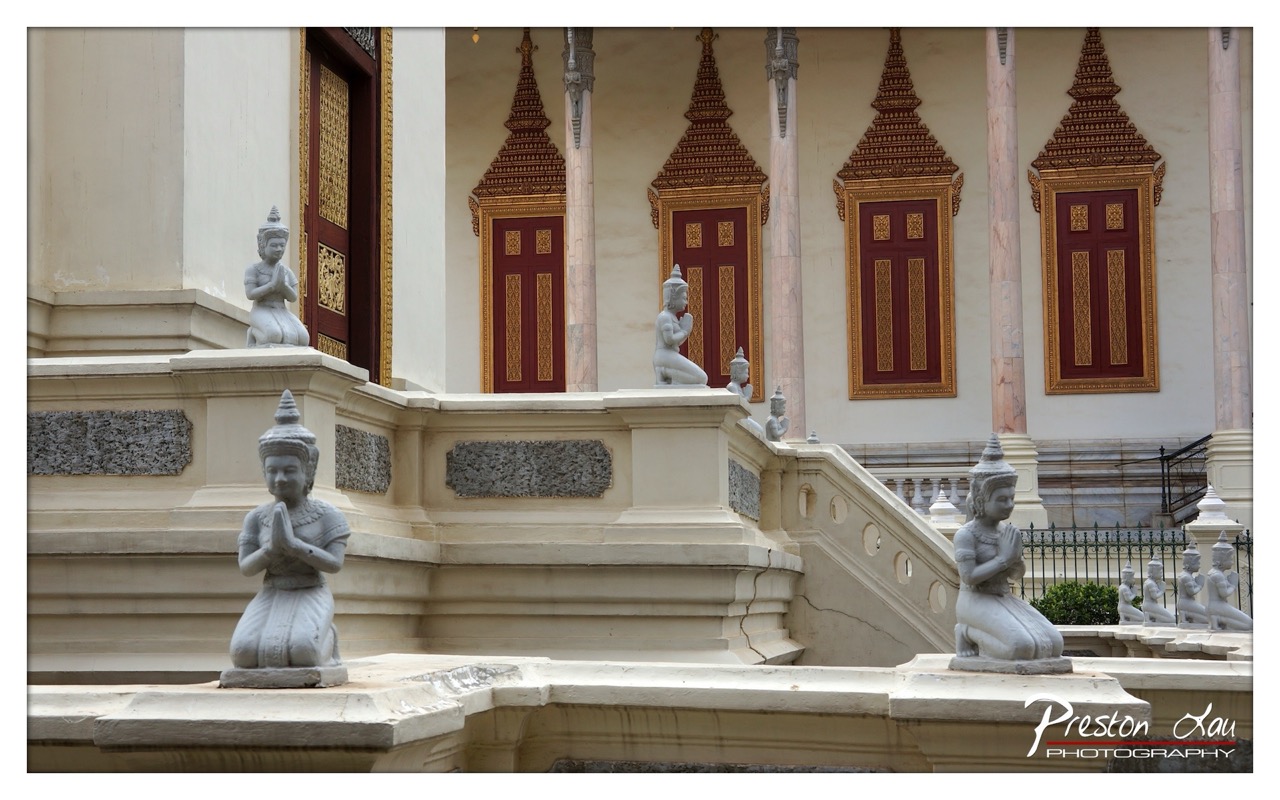

1. Overall Rating (0–10) — 7.0
This photograph captures the serene reverence of a Thai temple complex, where traditional architecture and devotional statues converge in quiet harmony. The repetition of kneeling figures and ornate doors creates a rhythm that draws the eye through the layered composition, while the soft daylight enhances the spiritual stillness. While the image is rich in cultural detail, a more dynamic perspective or tighter framing could elevate its visual impact beyond mere documentation.
2. Composition (0–10) — 7.0
The symmetrical arrangement of statues and doors creates a balanced, almost ceremonial rhythm. The staggered placement of figures across the steps adds depth and guides the viewer’s gaze upward, though the wide framing slightly dilutes the focus on the central elements.
3. Lighting (0–10) — 7.0
Soft, diffused daylight evenly illuminates the scene, preserving the delicate textures of the stone and gold accents without harsh shadows. The even exposure enhances the calm, contemplative mood appropriate to the subject.
4. Color & Tone (0–10) — 7.0
The palette of cream, gold, and deep red is rich yet harmonious, with the muted stone tones providing a neutral contrast that allows the architectural details to stand out. The overall tone is warm and inviting, reinforcing the cultural gravitas of the setting.
5. Creativity (0–10) — 6.5
The image is conceptually strong, emphasizing cultural continuity and devotion through repetition and symmetry. While visually compelling, it leans more toward documentation than imaginative interpretation, limiting its artistic risk.
6. Technical Quality (0–10) — 8.0
Sharp focus and clean detail are evident throughout, with excellent control over exposure and depth of field. The crisp rendering of textures and fine carvings demonstrates strong technical execution.
7. Emotional Impact (0–10) — 7.5
The image evokes a sense of peace and reverence, inviting the viewer to pause and reflect. The kneeling figures, in prayerful pose, create a quiet emotional resonance, suggesting devotion and spiritual continuity across time.
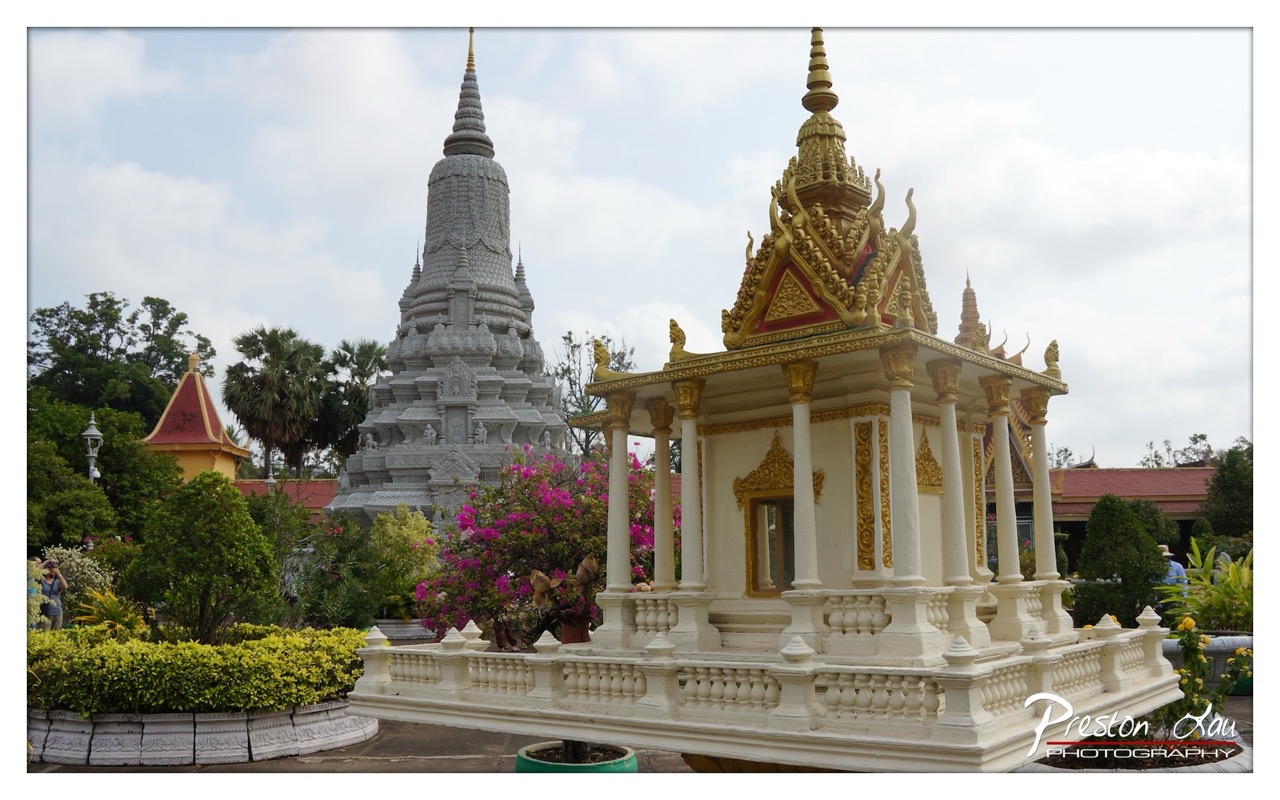

1. Overall Rating (0–10) — 7.5
This photograph captures the serene grandeur of a Cambodian temple complex, where tradition and nature coexist in quiet harmony. The juxtaposition of the ornate golden shrine in the foreground with the towering stone stupa in the background creates a compelling sense of depth and cultural richness. While the image is visually strong, the slightly overcast sky tempers the vibrancy of the scene, holding back its full emotional resonance.
2. Composition (0–10) — 8.0
The framing effectively balances the two key architectural elements, using the foreground shrine as a visual anchor. The diagonal placement of the stupa adds dynamism, while the surrounding foliage and flowers provide natural framing, guiding the eye toward the central structures.
3. Lighting (0–10) — 6.5
Diffused daylight from the overcast sky softens shadows and evenly illuminates the scene, preserving detail in both highlights and shadows. However, the lack of direct sunlight diminishes the golden glow on the shrine’s embellishments, slightly dulling the intended warmth and radiance.
4. Color & Tone (0–10) — 7.0
The palette is rich and harmonious, with the gold and white of the shrine contrasting beautifully against the gray stupa and the lush green and magenta foliage. The overall tone is balanced, though the muted sky lends a slightly cool cast that slightly dampens the warmth of the cultural elements.
5. Creativity (0–10) — 7.5
The photographer skillfully captures a layered narrative of spirituality and architecture, using the contrast between the ornate foreground and the solemn stupa to suggest a journey through time and devotion. The inclusion of blooming flowers adds a touch of life and vitality, enhancing the scene’s storytelling.
6. Technical Quality (0–10) — 8.0
The image is sharp and well-focused, with clear details visible in the intricate carvings of the shrine and the stupa. The exposure is balanced, and the depth of field is appropriate, keeping both the foreground and background in focus.
7. Emotional Impact (0–10) — 7.0
The photograph evokes a sense of reverence and tranquility, inviting the viewer to pause and reflect on the enduring beauty of religious heritage. While the overcast conditions temper the emotional intensity, the composition and cultural richness still manage to convey a deep sense of peace and awe.
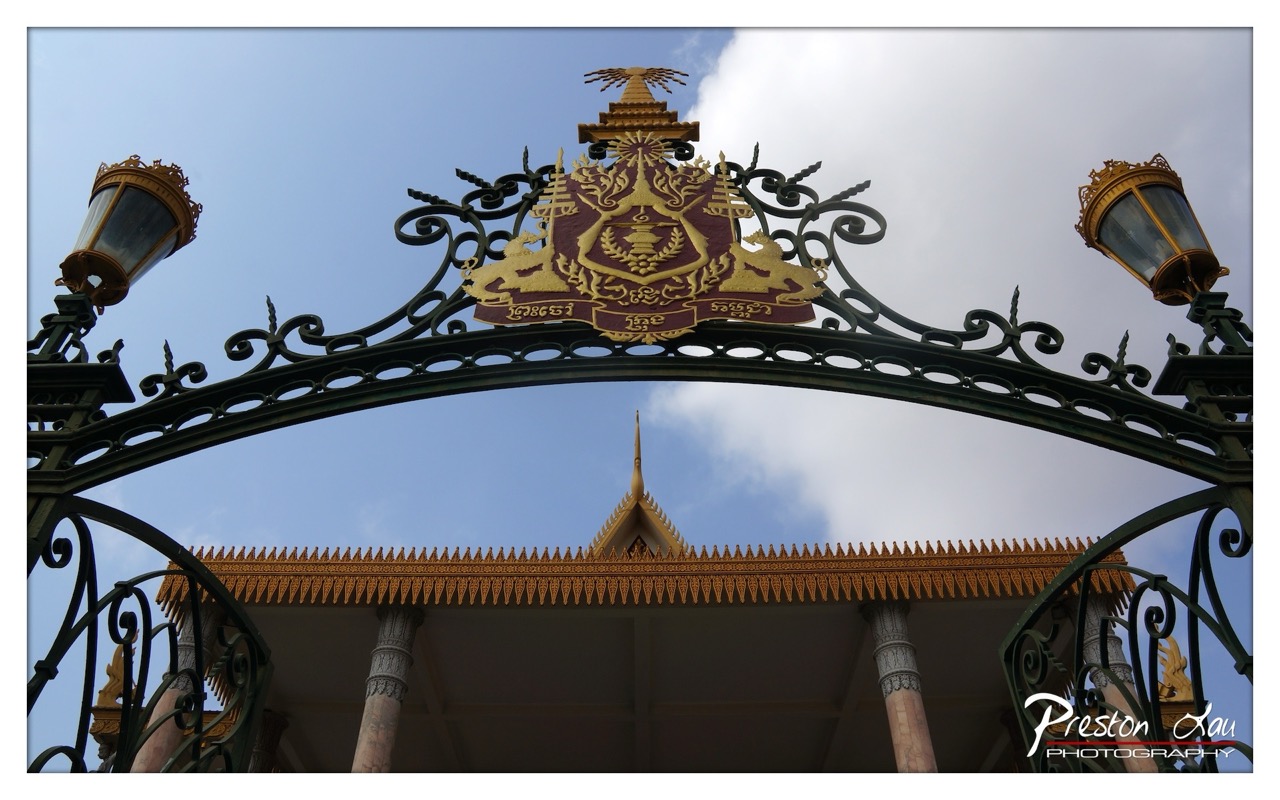

1. Overall Rating (0–10) — 8.0
This photograph captures the grandeur of a traditional Cambodian gateway with striking clarity and reverence, emphasizing both cultural symbolism and architectural detail. The upward angle enhances the monumentality of the structure, while the interplay of gold, black, and blue creates a visually rich and balanced composition. Slight overexposure in the sky and a somewhat busy foreground could be refined to further elevate the image’s elegance.
2. Composition (0–10) — 8.5
The low-angle perspective emphasizes the arch’s verticality and grandeur, with the central crest perfectly framed. The symmetry of the ornate gate and flanking lamps creates a strong sense of balance, while the roofline of the building below provides a grounded counterpoint to the sky.
3. Lighting (0–10) — 7.5
Natural daylight highlights the golden details of the crest and roof, creating a warm contrast against the dark ironwork. The sky is slightly overexposed, losing some cloud texture, but the overall light is even and flattering to the architectural elements.
4. Color & Tone (0–10) — 8.0
The rich golds and deep maroon of the crest stand out boldly against the cool blue sky, while the black iron provides strong contrast. The color palette feels authentic and culturally resonant, with a harmonious balance between warm and cool tones.
5. Creativity (0–10) — 8.0
The choice to frame the shot from beneath the arch adds drama and perspective, transforming a simple gate into a symbol of cultural pride. The integration of traditional elements—such as the royal emblem and temple-style roof—conveys a strong sense of place and identity.
6. Technical Quality (0–10) — 8.5
Sharp focus across the entire frame, clean detail in the metalwork and crest, and accurate exposure in most areas demonstrate strong technical execution. The watermark is subtle and does not detract from the image.
7. Emotional Impact (0–10) — 7.5
The image evokes a sense of awe and reverence, inviting the viewer to contemplate the historical and cultural weight of the structure. The quiet dignity of the scene resonates emotionally, particularly for those familiar with Cambodian heritage.


1. Overall Rating (0–10) — 7.0
This photograph captures the grandeur of a traditional Cambodian temple structure, where cultural richness and everyday life converge. The interplay of ornate architecture and casual visitors creates a compelling narrative of heritage in motion. While the composition is slightly cluttered by foreground elements, the image succeeds in conveying both the majesty of the site and its role as a living space, though it could benefit from tighter framing to enhance focus.
2. Composition (0–10) — 6.5
The framing is anchored by the green wrought-iron gate, which creates a natural vignette and draws the eye toward the central temple structure. However, the inclusion of too many foreground figures and the asymmetrical placement of the gate slightly disrupt the balance, making the scene feel more documentary than deliberate.
3. Lighting (0–10) — 6.0
The daylight is even and bright, illuminating the intricate gold details of the roof and columns without harsh shadows. However, the overcast sky tempers the vibrancy of the colors and softens the overall atmosphere, preventing the image from feeling dynamic.
4. Color & Tone (0–10) — 6.5
The warm golds and rich reds of the temple doors stand out against the pale stone and white balustrades, creating a visually harmonious palette. The green of the gate adds a complementary accent, though the overall tone is slightly muted by the diffused lighting.
5. Creativity (0–10) — 7.0
The photographer captures a moment where tradition and modernity intersect, using the architecture as a stage for everyday life. The choice to include the gate as a framing device adds a layer of visual storytelling, suggesting both access and separation.
6. Technical Quality (0–10) — 8.0
The image is sharp and well-focused, with clear details in both the architectural elements and the people. The exposure is balanced, and the depth of field is sufficient to keep the central structure in focus while softly blurring the foreground and background.
7. Emotional Impact (0–10) — 6.5
The photograph evokes a sense of reverence and curiosity, inviting the viewer to contemplate the intersection of history and present-day experience. While the emotional resonance is moderate due to the lack of a singular focal point, the scene feels authentic and grounded in place.


1. Overall Rating (0–10) — 8.0
This photograph captures the opulent grandeur of a Thai religious shrine, where intricate goldwork and sacred architecture converge in a moment of still reverence. The low-angle perspective emphasizes the towering structure, drawing the eye upward and enhancing its spiritual presence. While the image is rich in detail and texture, the slightly cluttered framing and busy background risk diluting the focus on the central stupa, though the overall atmosphere remains deeply evocative.
2. Composition (0–10) — 7.5
The low-angle shot effectively emphasizes the verticality and scale of the shrine, with the central stupa dominating the frame. The inclusion of the display cases in the foreground adds depth and context, though their placement slightly disrupts the visual flow.
3. Lighting (0–10) — 7.0
The warm, directional lighting highlights the golden embellishments, creating a luminous glow that enhances the richness of the materials. However, some areas in the background remain underexposed, and the ceiling fixtures cast subtle shadows that slightly obscure the architectural details.
4. Color & Tone (0–10) — 8.0
The dominant palette of gold, deep maroon, and muted reds creates a harmonious and regal atmosphere, evoking a sense of tradition and sacredness. The tonal contrast between the bright gold and dark background enhances the visual impact, while the overall warmth supports the image’s spiritual mood.
5. Creativity (0–10) — 8.0
The photographer captures a moment of quiet reverence with a strong sense of cultural authenticity. The choice to include the display cases in the foreground grounds the image in its context, offering a narrative beyond mere ornamentation.
6. Technical Quality (0–10) — 8.5
The image is sharp and detailed, with excellent clarity in the intricate carvings and reflective surfaces. The focus is well-managed, and the exposure is balanced enough to preserve detail in both highlights and shadows.
7. Emotional Impact (0–10) — 8.0
The photograph conveys a deep sense of awe and reverence, inviting the viewer into a sacred space. The interplay of light, texture, and scale evokes contemplation and respect, making the spiritual significance of the scene palpable.
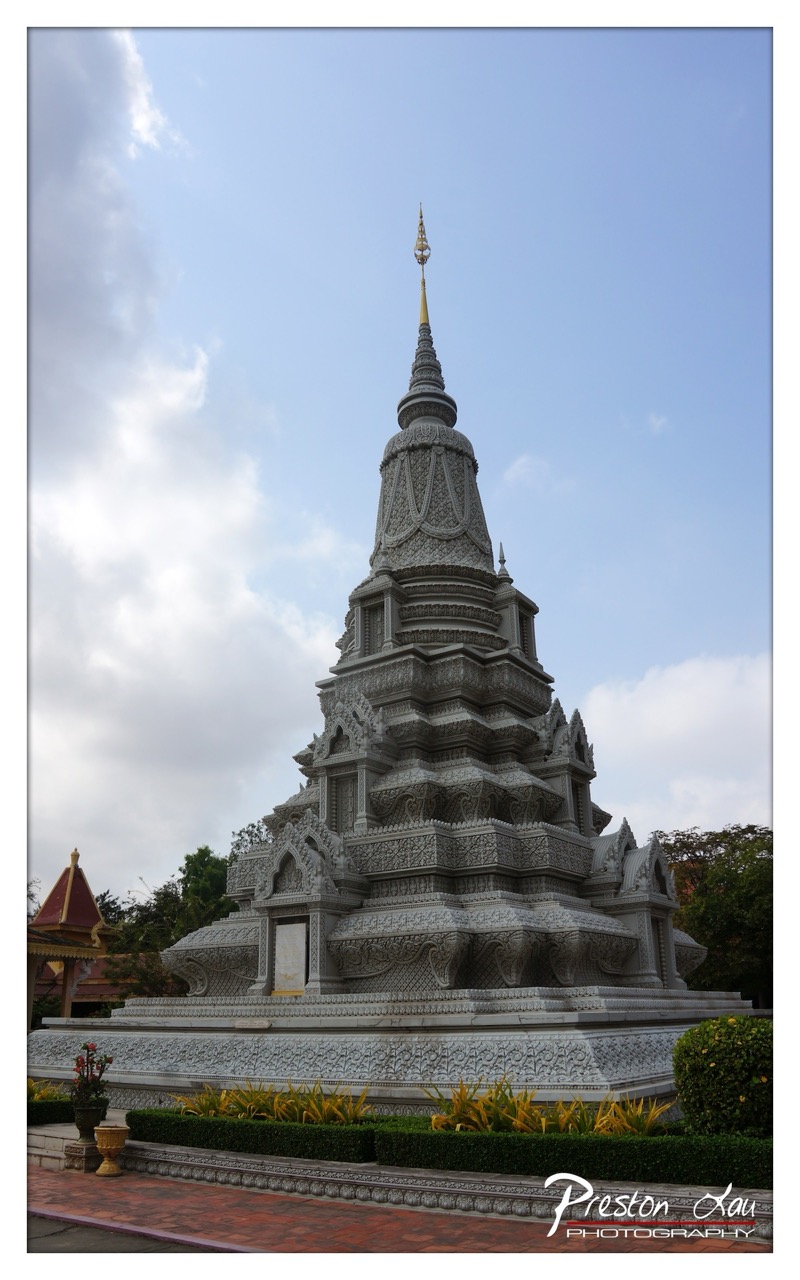

1. Overall Rating (0–10) — 7.0
This photograph captures the serene grandeur of a traditional Cambodian stupa, its intricate carvings and tiered form rising with quiet dignity against a soft blue sky. The low-angle perspective emphasizes the monument’s verticality and spiritual presence, while the natural light enhances the texture and detail of the stone. While the composition is strong and the subject compelling, the slightly overcast sky tempers the image’s visual drama, holding back its full potential for emotional resonance.
2. Composition (0–10) — 7.5
The low-angle framing effectively draws the eye upward, emphasizing the stupa’s height and architectural complexity. The balanced placement of the structure within the frame, with the red-roofed pavilion and greenery anchoring the lower corners, creates a sense of harmony and cultural context.
3. Lighting (0–10) — 6.5
The soft, diffused daylight highlights the stupa’s detailed carvings without harsh shadows, lending a calm and contemplative mood. However, the overcast sky reduces contrast and diminishes the golden accent of the spire, slightly muting the image’s vibrancy.
4. Color & Tone (0–10) — 6.0
The palette is dominated by cool grays and blues, with subtle pops of warm red and yellow from the nearby structures and foliage. While cohesive, the muted tones lend a subdued quality to the image, slightly dampening the richness of the stupa’s cultural significance.
5. Creativity (0–10) — 7.0
The photographer’s choice to capture the stupa from a low angle and include contextual elements like the pavilion and garden enhances the narrative depth. The image feels both reverent and grounded, offering a fresh perspective on a familiar architectural form.
6. Technical Quality (0–10) — 8.0
The image is sharp and detailed, with excellent clarity in the stupa’s intricate carvings. Focus is precise, and the resolution captures fine textures, making the craftsmanship of the structure clearly visible.
7. Emotional Impact (0–10) — 6.5
The photograph evokes a sense of peace and reverence, inviting quiet contemplation. While the emotional pull is restrained by the soft lighting and neutral mood, the subject’s spiritual and cultural weight still resonates with the viewer.
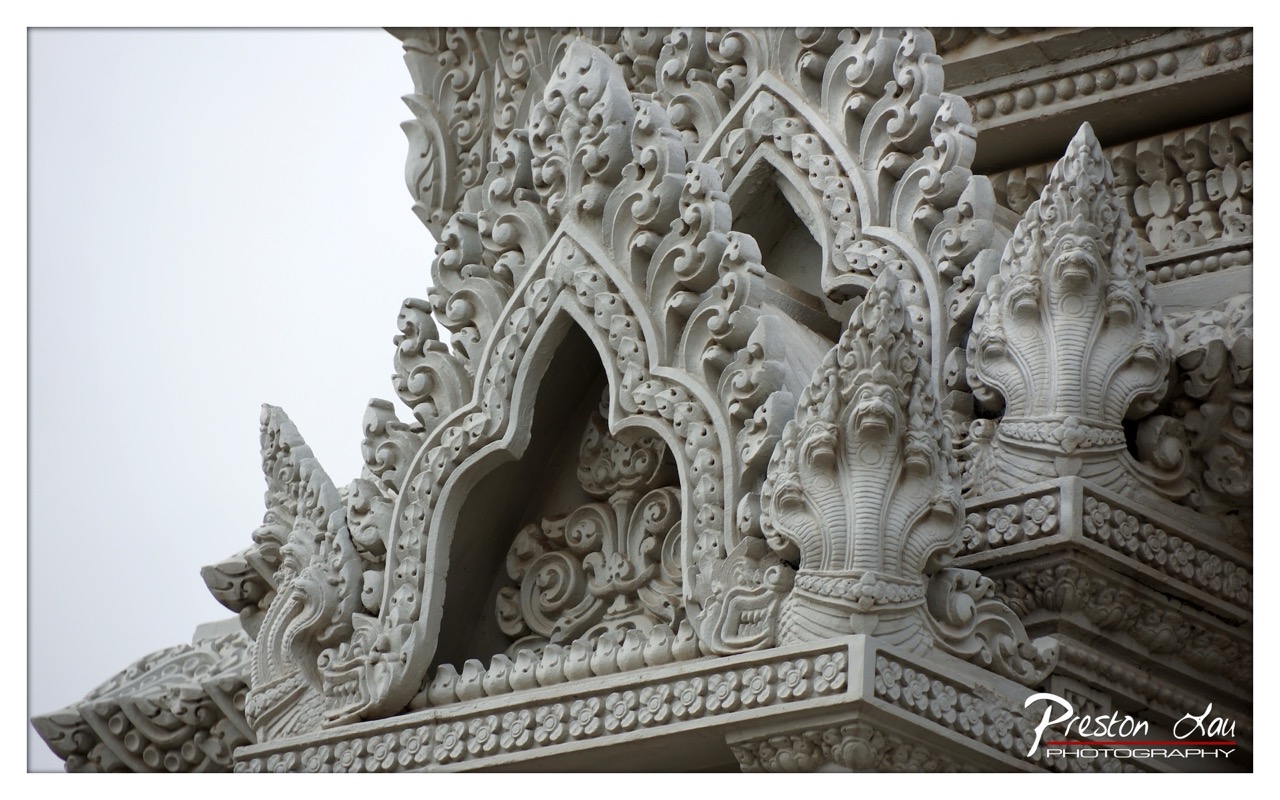

1. Overall Rating (0–10) — 8.0
This photograph captures the intricate artistry of traditional Southeast Asian temple architecture with a striking sense of reverence and detail. The white stone carvings, rich in symbolic motifs and fluid curves, stand out against the soft, overcast sky, creating a quiet yet powerful visual harmony. While the monochromatic palette limits vibrancy, the image excels in showcasing the craftsmanship and spiritual weight of the structure, inviting contemplation through its meticulous composition.
2. Composition (0–10) — 8.0
The diagonal framing emphasizes the verticality and layered complexity of the ornate stonework, guiding the eye through the interplay of arches and naga figures. The placement of the central gable draws focus, while the negative space on the left provides balance and a sense of scale.
3. Lighting (0–10) — 7.5
Diffused, overcast light enhances the texture and depth of the carvings without creating harsh shadows, allowing every detail to be clearly visible. The soft illumination contributes to a serene, almost sacred atmosphere.
4. Color & Tone (0–10) — 6.5
The predominantly monochromatic white and gray tones lend a timeless quality to the image, but the lack of color variation slightly diminishes visual dynamism. The subtle tonal shifts across the stone, however, add depth and realism.
5. Creativity (0–10) — 8.5
The choice to focus on the architectural details rather than the full structure reveals a thoughtful narrative intent—highlighting cultural and spiritual significance through form and ornamentation. The image transforms a religious structure into a meditative study of artistry.
6. Technical Quality (0–10) — 8.5
Sharp focus and high resolution capture the fine textures of the stonework with precision. The image is clean, well-exposed, and free of technical flaws, showcasing strong control in both capture and post-processing.
7. Emotional Impact (0–10) — 8.0
There is a profound sense of stillness and reverence that resonates through the image, evoking awe for both the craftsmanship and the cultural tradition it represents. The viewer is drawn into a moment of quiet contemplation, connecting with the spiritual essence of the space.
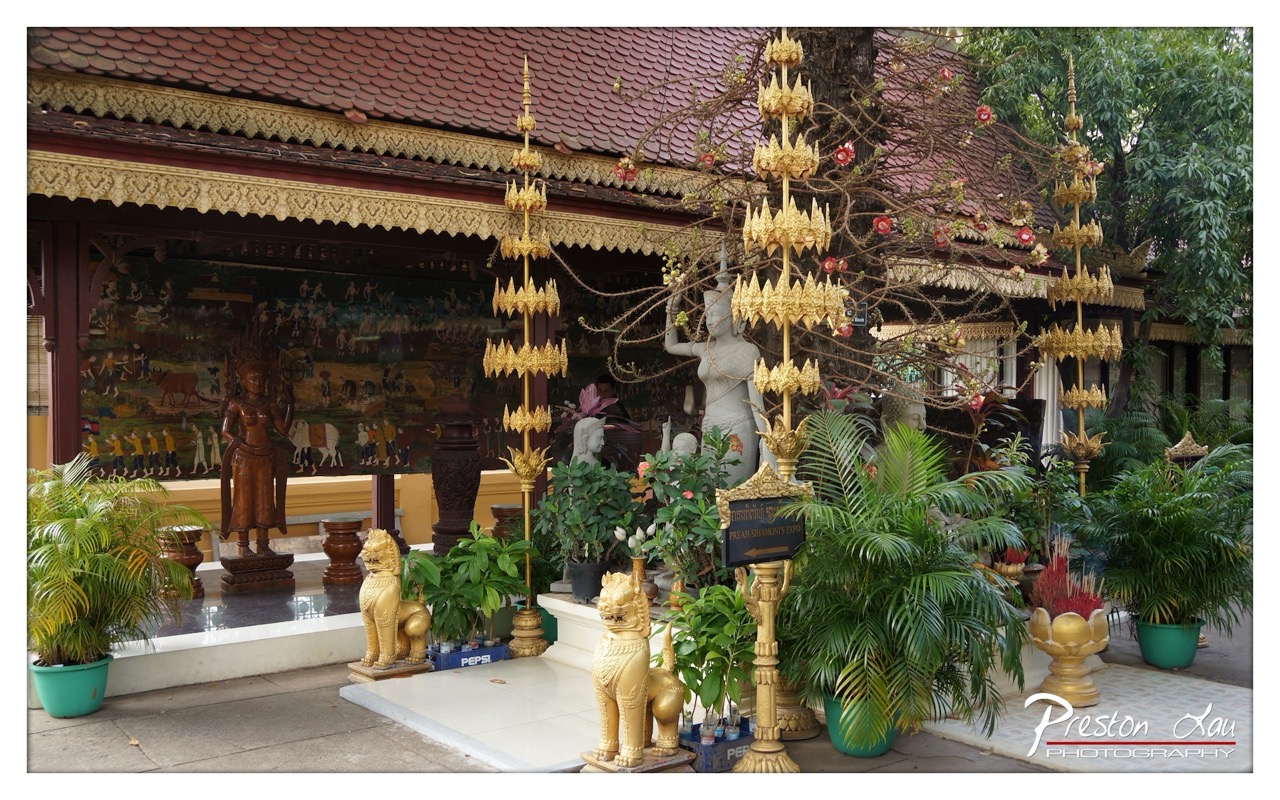

1. Overall Rating (0–10) — 7.0
This photograph captures the vibrant spiritual energy of a Southeast Asian temple courtyard, where ornate golden rituals and lush greenery converge in a rich tapestry of culture and devotion. The composition is dense with symbolic objects—gilded spires, statues, and incense—yet the eye is drawn through a natural balance of color and form. While the visual abundance borders on clutter, the image succeeds in conveying the sacredness and lived-in nature of the space, though it could benefit from more refined framing to elevate its artistic impact.
2. Composition (0–10) — 6.5
The subject is layered and complex, with multiple vertical elements competing for attention. A tighter crop and more intentional use of negative space would improve visual flow and emphasize key details.
3. Lighting (0–10) — 6.0
Natural daylight provides even illumination, highlighting the gold tones and textures of the statues and carvings. However, the flat, overcast quality slightly dulls the vibrancy and reduces the depth of shadows.
4. Color & Tone (0–10) — 7.0
The golden hues of the ceremonial structures contrast beautifully with the deep greens of the foliage and the rich reds of the tiled roof. The color palette is harmonious and culturally resonant, though some areas appear slightly washed out due to exposure.
5. Creativity (0–10) — 7.5
The image effectively captures a moment of cultural authenticity, blending ritual objects with everyday elements like the Pepsi crate. The juxtaposition of sacred and mundane adds a layer of narrative intrigue and reflects the lived reality of the space.
6. Technical Quality (0–10) — 7.5
Sharp focus across the frame allows for clear detail in both foreground and background. The exposure is generally well-balanced, with minimal noise and good clarity.
7. Emotional Impact (0–10) — 7.0
There is a quiet reverence in the scene, evoked by the stillness of the statues and the presence of devotion. The viewer is invited into a space that feels both sacred and accessible, fostering a sense of cultural curiosity and respect.
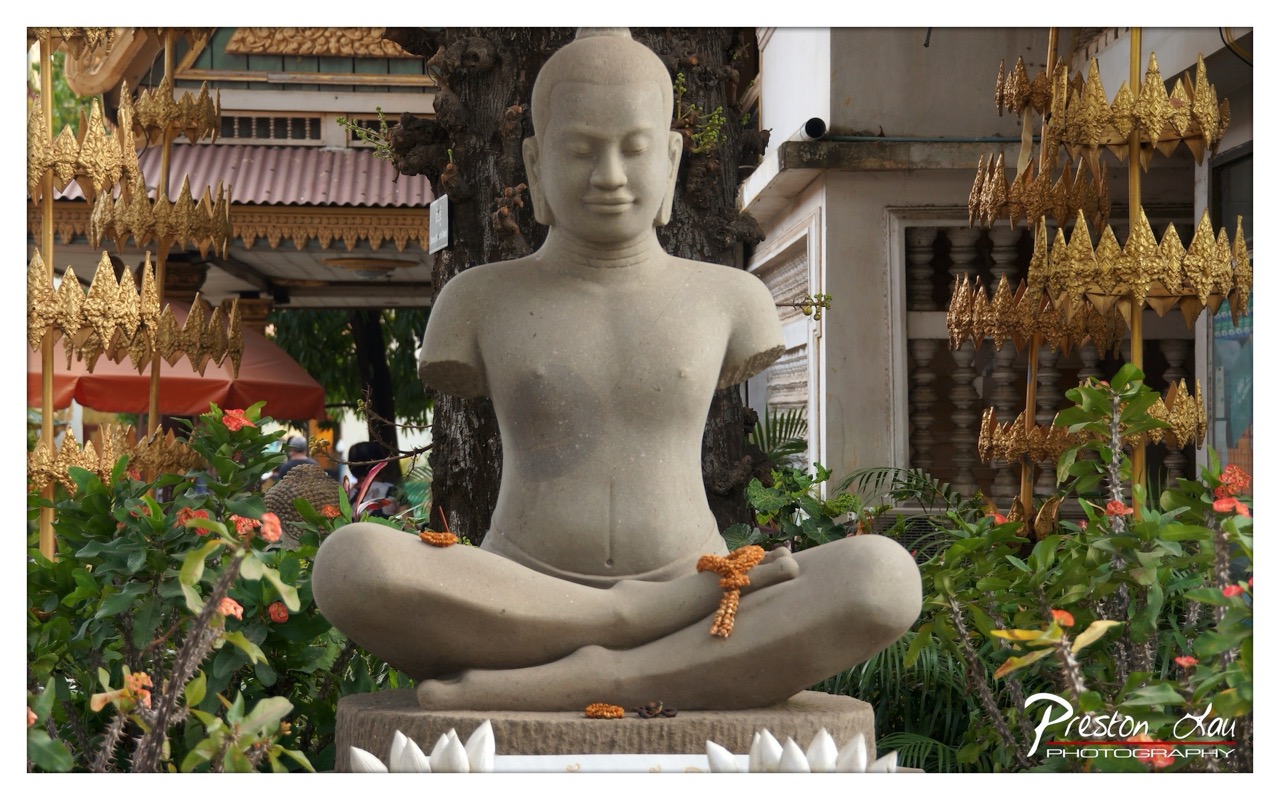

1. Overall Rating (0–10) — 7.0
This photograph captures a serene and culturally rich moment, centered on a meditative stone statue surrounded by vibrant natural and architectural elements. The juxtaposition of the calm, still figure with the bustling temple environment creates a compelling narrative of spiritual presence amid daily life. While the image is visually rich and layered, the composition's slight clutter and flat lighting prevent it from achieving a more refined aesthetic.
2. Composition (0–10) — 6.5
The statue is well-centered, drawing the eye, but the surrounding elements—golden ornaments, foliage, and background structures—create a busy frame that competes for attention. A tighter crop could emphasize the subject and enhance visual harmony.
3. Lighting (0–10) — 6.0
Natural daylight illuminates the scene evenly, preserving detail but lacking dramatic contrast. The flat quality of the light softens textures and reduces the sense of depth in the background.
4. Color & Tone (0–10) — 7.0
The warm gold of the temple ornaments and the vibrant green of the plants create a pleasing contrast with the neutral stone. The color palette feels authentic to the setting, though some areas appear slightly overexposed, dulling the richness.
5. Creativity (0–10) — 7.5
The image successfully blends religious symbolism with everyday context, conveying a quiet reverence. The inclusion of offerings on the statue adds a layer of narrative depth, suggesting active devotion.
6. Technical Quality (0–10) — 7.5
The focus is sharp on the statue, and the details in the stone and surrounding flora are well-defined. The exposure is balanced, though minor post-processing could enhance contrast and vibrance.
7. Emotional Impact (0–10) — 7.0
The stillness of the statue evokes peace and contemplation, while the surrounding life and offerings suggest enduring faith. The viewer is invited to reflect on the intersection of the sacred and the ordinary.


1. Overall Rating (0–10) — 7.0
This photograph captures the vibrant essence of a traditional Cambodian temple, where rich reds and intricate architectural details convey a sense of cultural depth and spiritual presence. The composition balances the building’s grandeur with surrounding greenery and subtle human elements, grounding the scene in a living, active space. While the overcast sky slightly dulls the mood, the image remains compelling for its authenticity and the quiet dignity of the structure.
2. Composition (0–10) — 7.5
The low-angle perspective emphasizes the temple’s height and ornate rooflines, while the inclusion of the vendor tent and foliage adds narrative context. The framing feels intentional, with the building centered and flanked by natural elements, creating visual harmony.
3. Lighting (0–10) — 6.0
Soft, diffused light from the overcast sky evenly illuminates the scene but lacks the warmth and contrast that would highlight the texture of the red wood and tile. The flat lighting reduces depth, though it prevents harsh shadows.
4. Color & Tone (0–10) — 7.5
The dominant red of the temple stands out against the green foliage and pale sky, creating a strong visual contrast. The tones are rich and consistent, with a slightly warm cast that enhances the cultural feel of the image.
5. Creativity (0–10) — 7.0
The inclusion of the modern vendor tent introduces a subtle juxtaposition between tradition and daily life, adding narrative interest. The photographer captures both the architectural beauty and the site’s active role in the community.
6. Technical Quality (0–10) — 8.0
Sharp focus across the frame ensures clarity in the architectural details, and the exposure is well-balanced despite the overcast conditions. The image is clean and free of noticeable technical flaws.
7. Emotional Impact (0–10) — 7.0
The image evokes a sense of reverence and continuity, inviting the viewer to reflect on the enduring presence of cultural heritage. The quiet, lived-in atmosphere lends a contemplative tone, though the lack of dramatic lighting tempers the emotional intensity.
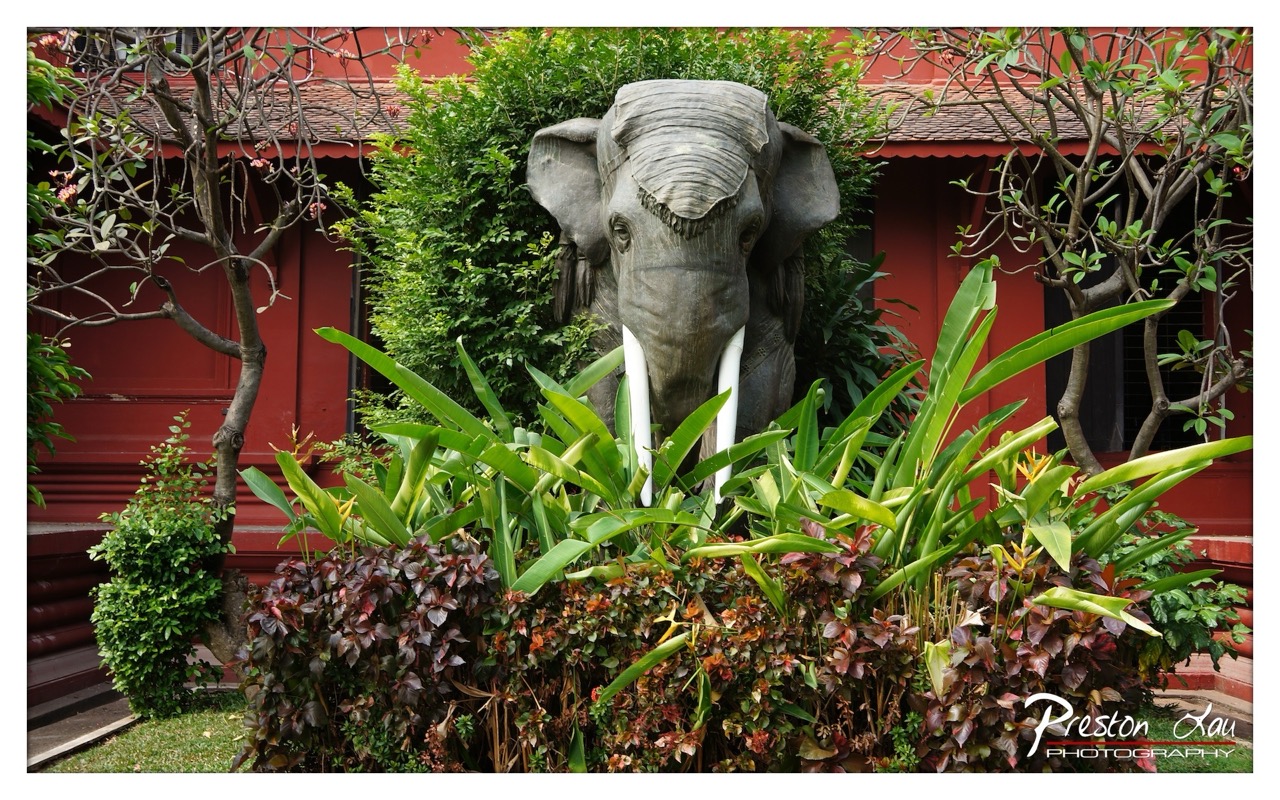

1. Overall Rating (0–10) — 7.5
This photograph captures the serene presence of a stone elephant statue nestled within lush tropical foliage, evoking a sense of cultural reverence and natural harmony. The rich red backdrop of the building contrasts beautifully with the verdant greens and the gray stone, creating a visually layered composition. While the image is strong in mood and subject, the framing feels slightly crowded, and the depth of field could better isolate the statue as the focal point.
2. Composition (0–10) — 7.0
The elephant is centered and dominates the frame, but the surrounding foliage and framing branches create a busy foreground that partially obstructs the view. A tighter crop would enhance focus and visual clarity.
3. Lighting (0–10) — 7.0
Natural daylight illuminates the scene evenly, with soft shadows that accentuate the texture of the stone and leaves. The lighting enhances the depth of the foliage without creating harsh contrasts.
4. Color & Tone (0–10) — 8.0
The palette is rich and harmonious, with deep reds, vibrant greens, and the neutral gray of the elephant creating a balanced and visually pleasing contrast. The warm tones lend an inviting, tropical atmosphere.
5. Creativity (0–10) — 7.5
The juxtaposition of a sacred symbol within a living garden setting suggests a thoughtful narrative about tradition and nature. The image feels both documentary and contemplative, offering a glimpse into cultural landscape.
6. Technical Quality (0–10) — 8.0
The image is sharp and well-focused, with clear detail in the texture of the elephant and surrounding plants. The exposure is balanced, and the watermark is unobtrusive.
7. Emotional Impact (0–10) — 7.0
The photograph conveys calm and reverence, inviting the viewer to pause and reflect on the symbolism of the elephant in this cultural context. While emotionally resonant, the composition's slight clutter keeps the emotional connection from fully unfolding.
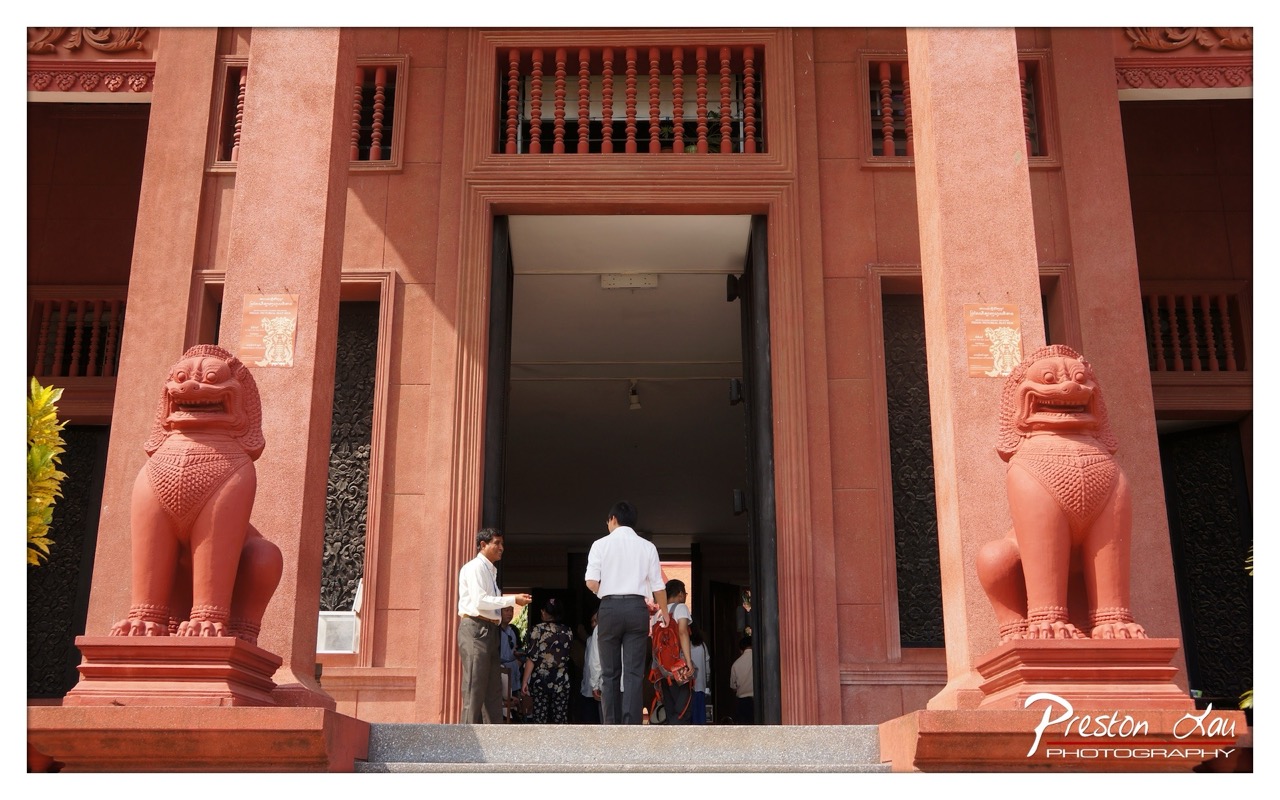

1. Overall Rating (0–10) — 7.0
This photograph captures the grandeur and cultural weight of a traditional Khmer-style building, with its imposing red sandstone façade and guardian lion statues lending a sense of historical gravitas. The symmetry of the entrance and the presence of visitors lend life to the scene, grounding its ceremonial purpose. While the image is strong in composition and cultural resonance, the slightly overexposed highlights and cluttered foreground slightly detract from its visual elegance.
2. Composition (0–10) — 8.0
The symmetrical framing around the central doorway creates a strong focal point, enhanced by the balanced placement of the lion statues. The leading lines of the steps and columns draw the eye inward, while the figures at the threshold add narrative depth without disrupting the formal structure.
3. Lighting (0–10) — 6.5
Bright, direct sunlight illuminates the façade, emphasizing texture and color, but results in harsh highlights on the upper walls and slight loss of detail in the shadows. The strong contrast adds drama but slightly flattens the overall tonal range.
4. Color & Tone (0–10) — 7.5
The warm terracotta tones of the building are rich and consistent, evoking a sense of tradition and place. The contrast between the red stone and the dark interior creates visual depth, while the natural color palette feels authentic and harmonious.
5. Creativity (0–10) — 7.0
The image successfully blends architectural documentation with human presence, creating a narrative of cultural continuity. The choice to capture people entering the building adds a subtle story element, transforming a static scene into one of ongoing tradition.
6. Technical Quality (0–10) — 7.5
Sharp focus across the frame ensures clarity in both the architectural details and the figures. The exposure is generally well-managed, though minor overexposure in the upper facade suggests slight technical imbalance.
7. Emotional Impact (0–10) — 7.0
The photograph evokes a sense of reverence and quiet anticipation, inviting the viewer to imagine the rituals and history contained within. The presence of people suggests continuity, connecting the past with the present in a way that feels both solemn and alive.
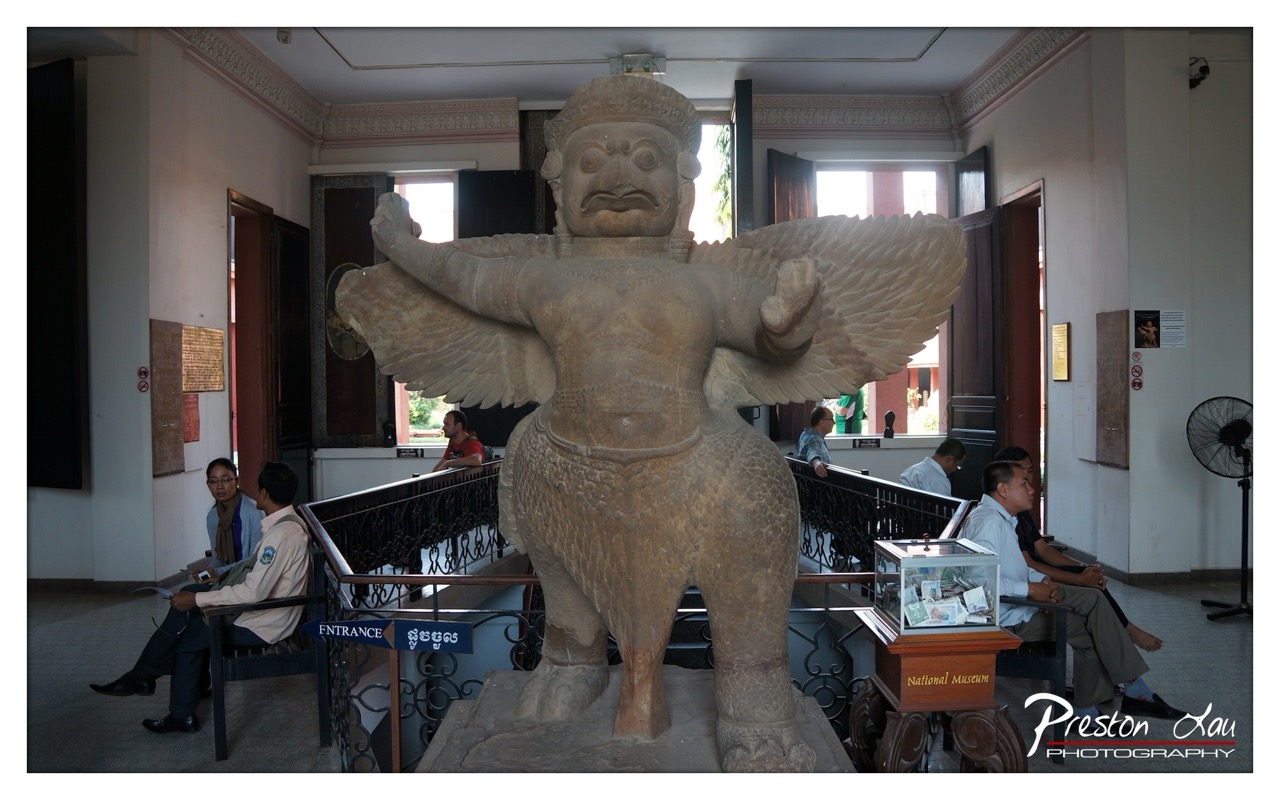

1. Overall Rating (0–10) — 6.8
This photograph captures the imposing presence of a Khmer-style stone sculpture within a museum setting, where history and daily life intersect. The statue’s intricate carvings and mythological form stand as a powerful focal point, while the surrounding visitors and functional elements ground the scene in authenticity. The image balances cultural reverence with documentary realism, though the cluttered environment slightly dilutes the sculpture’s grandeur.
2. Composition (0–10) — 6.5
The central placement of the statue creates a strong focal point, but the surrounding people and railings introduce visual distractions. A tighter crop would enhance focus on the sculpture’s details and symbolic form.
3. Lighting (0–10) — 6.0
Natural light from the windows illuminates the scene evenly, but the overhead artificial lighting creates a flat, slightly sterile quality. The contrast between the bright background and darker interior reduces depth, softening the statue’s three-dimensionality.
4. Color & Tone (0–10) — 6.5
The palette is dominated by earthy stone tones and muted whites, lending a subdued, archival feel. The lack of vibrant color keeps the mood restrained, aligning with the museum’s quiet atmosphere, though more tonal contrast could add visual interest.
5. Creativity (0–10) — 7.0
The image successfully juxtaposes ancient art with contemporary life, capturing a moment where history is not isolated but lived. The inclusion of the donation box and signage adds narrative layers, making the scene feel dynamic and culturally grounded.
6. Technical Quality (0–10) — 7.5
The image is sharp and well-focused, particularly on the statue’s surface details. The exposure is balanced, and the photographer has captured fine textures without overexposure or underexposure.
7. Emotional Impact (0–10) — 6.0
The viewer feels a sense of awe at the sculpture’s scale and craftsmanship, yet the surrounding activity tempers the solemnity. The emotional resonance lies in the quiet dignity of the artifact amid the hum of daily life, suggesting continuity between past and present.
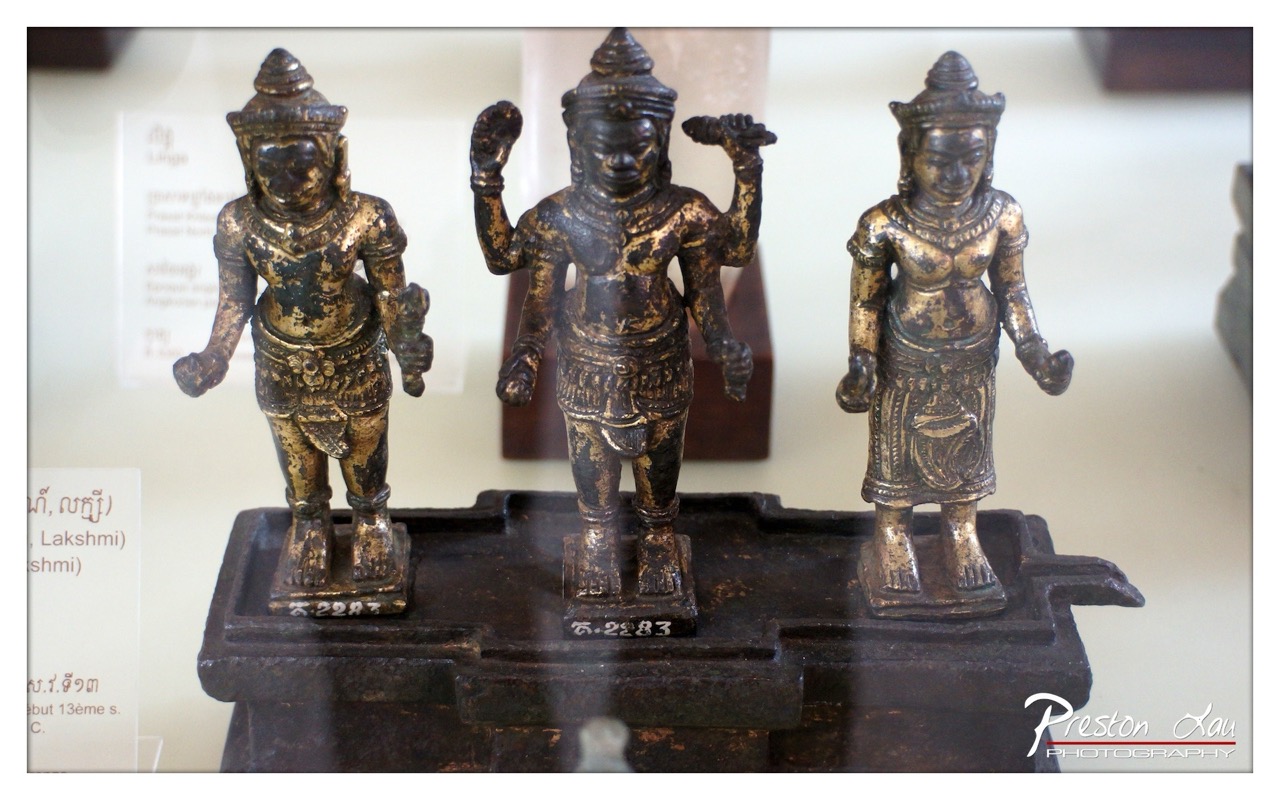

1. Overall Rating (0–10) — 7.0
This photograph captures the intricate detail and spiritual gravity of three ancient bronze figures, their weathered gold leaf and solemn postures conveying centuries of devotion. The display case’s reflective surface introduces a subtle visual tension, but the composition successfully emphasizes the cultural and historical weight of the artifacts. While the image is technically sound, it leans more toward documentation than artistic interpretation, offering a respectful but restrained view of the objects.
2. Composition (0–10) — 7.5
The central figure is well-balanced between the two flanking statues, creating a sense of symmetry and harmony. The slight depth of field isolates the figures from the background, though the glass reflection and signage in the periphery slightly disrupt the visual flow.
3. Lighting (0–10) — 6.5
The light is even and diffused, likely from overhead museum lighting, which highlights the textures and patina of the bronze without creating harsh shadows. However, the cool tone and flatness of the illumination limit the sense of drama or warmth that could enhance the spiritual presence of the figures.
4. Color & Tone (0–10) — 7.0
The palette is dominated by earthy golds, dark bronze, and muted whites, creating a cohesive and historically grounded tone. The contrast between the aged metal and the clean background enhances the visual focus, though the lack of color vibrancy keeps the image from feeling dynamic.
5. Creativity (0–10) — 6.0
The image functions as a clear, respectful documentation of the artifacts, but it lacks a distinctive artistic vision. The framing is straightforward, and the narrative is more about preservation than interpretation.
6. Technical Quality (0–10) — 8.0
Sharp focus on the statues, with clean detail visible in the metalwork and inscriptions. The depth of field is appropriate, and the image is free of technical flaws such as blur or noise.
7. Emotional Impact (0–10) — 6.5
The quiet dignity of the figures evokes a sense of reverence and timelessness, but the sterile museum environment and reflective glass create a barrier to deeper emotional engagement. The viewer is invited to observe, but not to feel.
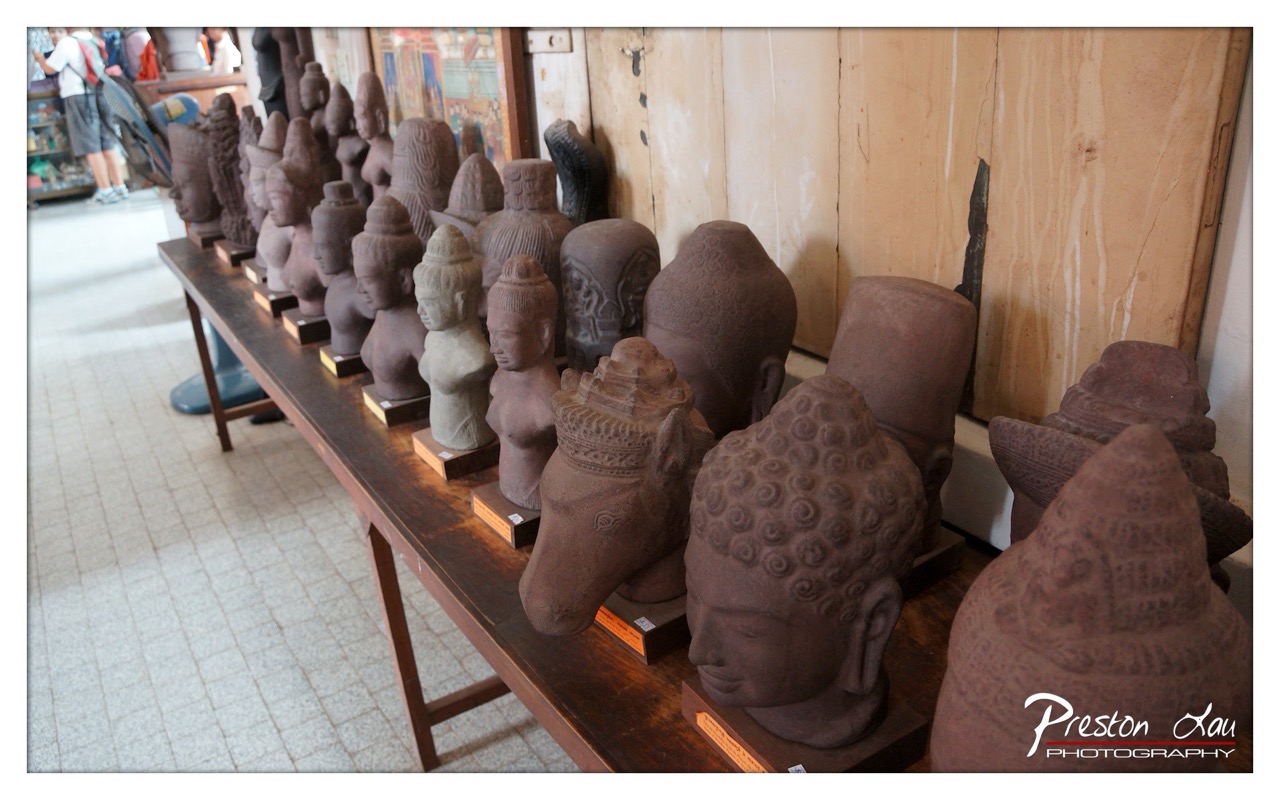

1. Overall Rating (0–10) — 7.0
This photograph captures the quiet reverence of a museum or gallery space dedicated to ancient Southeast Asian art, where rows of stone Buddha and deity heads stand in solemn repose. The diagonal arrangement of the sculptures creates a strong visual rhythm, drawing the eye through the frame, while the soft, ambient light enhances the texture and spiritual stillness of the stone. Though the background activity and slight clutter of the setting detract from the image’s serenity, the composition ultimately conveys a sense of cultural depth and historical continuity.
2. Composition (0–10) — 7.5
The diagonal line of the table and sculptures guides the viewer’s eye from the foreground to the background, creating a sense of depth and continuity. The placement of the heads along the length of the table establishes a strong rhythm, though the slight tilt of the frame introduces a subtle imbalance.
3. Lighting (0–10) — 6.5
The lighting is soft and diffused, likely from overhead fluorescent sources, which evenly illuminates the sculptures without creating harsh shadows. While functional for documentation, the light lacks warmth and fails to accentuate the texture and contours of the stone, slightly diminishing the image’s atmospheric quality.
4. Color & Tone (0–10) — 6.0
The dominant earthy browns and grays of the stone create a cohesive, muted palette that reflects the age and material of the artifacts. However, the overall tone is slightly flat and desaturated, with a subtle color cast that weakens the visual richness of the scene.
5. Creativity (0–10) — 6.5
The image successfully captures a moment of cultural display, emphasizing the repetitive beauty of the sculptural forms. While the concept is straightforward and observational, the diagonal composition and sense of rhythm lend a subtle artistic intention.
6. Technical Quality (0–10) — 7.0
The image is sharp and well-focused, particularly on the foreground sculptures. The depth of field is adequate, keeping the central subjects clear while softly blurring the background. The watermark is discreet and does not detract from the composition.
7. Emotional Impact (0–10) — 7.0
There is a quiet dignity and contemplative mood that arises from the stillness of the stone heads and the hushed environment. The viewer is invited to reflect on the spiritual and historical significance of the artifacts, evoking a sense of reverence and timelessness.
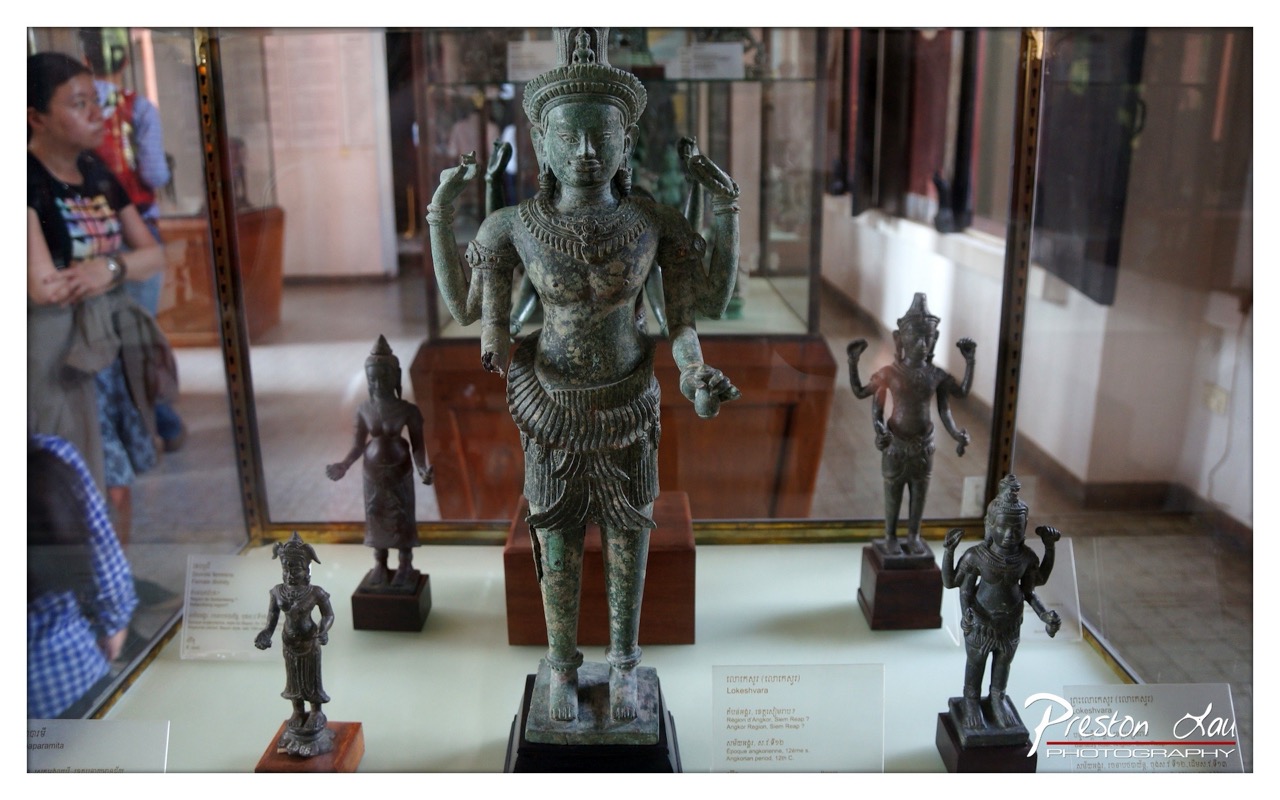

1. Overall Rating (0–10) — 6.8
This photograph captures the quiet reverence of a museum display, where ancient bronze statues stand as silent witnesses to a rich cultural heritage. The central figure, a multi-armed deity with intricate detailing, commands attention through its scale and craftsmanship, while the surrounding smaller sculptures add narrative depth. However, the reflections in the glass and the presence of a visitor in the background slightly disrupt the image’s clarity and cohesion, softening its visual impact.
2. Composition (0–10) — 6.5
The central statue is well-positioned, drawing the eye naturally, but the surrounding elements—especially the reflections and off-center figures—create a sense of visual clutter. A tighter crop and better management of the glass reflections would enhance balance and focus.
3. Lighting (0–10) — 6.0
The lighting is functional and even, typical of a museum environment, but lacks direction or drama. The ambient light is soft and diffuse, which preserves the details of the bronze patina but fails to create depth or highlight the sculpture’s texture.
4. Color & Tone (0–10) — 6.5
The dominant greenish patina of the bronze contrasts subtly with the neutral tones of the display case and the warm wood of the pedestals. While the palette is cohesive, it leans toward muted and desaturated, reducing the vibrancy of the scene.
5. Creativity (0–10) — 6.0
The image documents a cultural artifact with respect, but the approach is observational rather than interpretive. The reflection of the visitor and the cluttered background suggest a candid moment, but the composition could have been more deliberate to elevate the artistic intent.
6. Technical Quality (0–10) — 7.5
Sharp focus on the main sculpture ensures clarity in the details of the bronze work. The depth of field is appropriate, though the reflections and slight glare on the glass indicate minor technical challenges with the display environment.
7. Emotional Impact (0–10) — 6.0
The image evokes a sense of historical continuity and quiet contemplation, but the distractions of the museum setting—particularly the reflections and human presence—limit its ability to fully immerse the viewer in the spiritual or cultural weight of the subject.
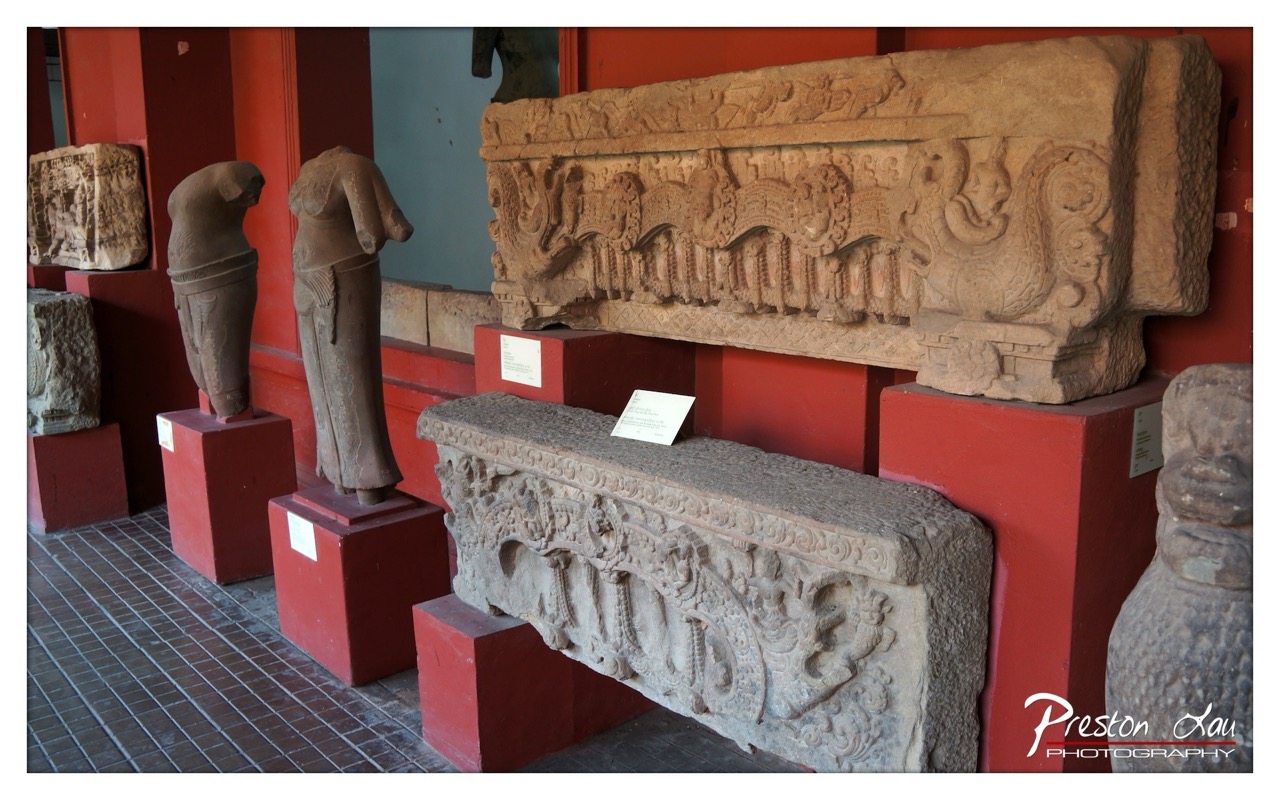

1. Overall Rating (0–10) — 7.0
This photograph captures the quiet grandeur of ancient stone artifacts displayed within a museum setting, where history and craftsmanship resonate through intricate carvings and weathered textures. The deep red backdrop provides a striking contrast to the aged stone, emphasizing the cultural weight of the pieces. While the composition is strong and the details are rich, the slightly cluttered arrangement and flat lighting prevent it from achieving a more evocative or dynamic presence.
2. Composition (0–10) — 6.5
The framing includes multiple objects, creating a sense of depth and narrative, but the placement of the foreground relief and the partial statue on the right disrupt visual flow. A tighter focus on the central carved panels would improve balance.
3. Lighting (0–10) — 5.5
The light is even but harsh, likely from overhead fluorescent sources, flattening textures and reducing the three-dimensionality of the carvings. Subtle shadows would enhance depth and detail.
4. Color & Tone (0–10) — 7.5
The contrast between the warm red pedestals and the cool, weathered tones of the stone creates a visually engaging palette. The muted earthy hues of the artifacts are well-rendered, though a touch more vibrancy in the reds would elevate the overall mood.
5. Creativity (0–10) — 7.0
The photographer captures the essence of a historical space with a documentary eye, highlighting the artistry of the sculptures. The choice to frame multiple pieces together suggests a narrative of cultural continuity, though the approach remains largely conventional.
6. Technical Quality (0–10) — 8.0
Sharp focus across the frame reveals fine details in the carvings, and the exposure is generally well-managed. The watermark is unobtrusive and professional.
7. Emotional Impact (0–10) — 6.5
The image conveys a sense of reverence and timelessness, inviting contemplation of ancient craftsmanship. However, the lack of dramatic lighting and emotional resonance keeps the viewer from fully connecting with the artifacts’ spiritual or historical weight.
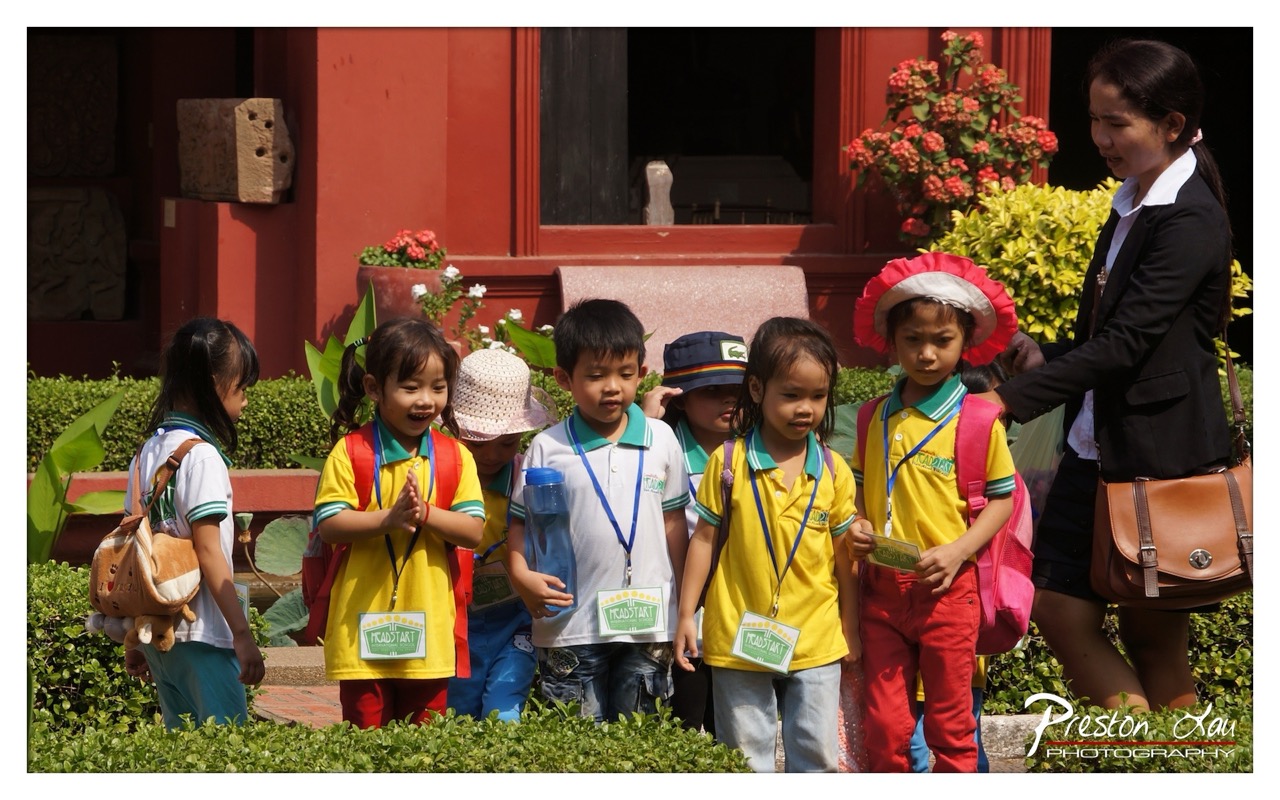

1. Overall Rating (0–10) — 7.0
This photograph captures a vibrant moment of childhood curiosity and guided exploration, with a group of young students on a field trip, their expressions and bright clothing creating an immediate sense of energy and innocence. The warm sunlight and rich red backdrop lend a lively, almost theatrical quality, while the teacher’s presence grounds the scene in a sense of care and structure. Though the composition is slightly busy and the lighting occasionally harsh, the image succeeds in conveying the joy and focus of young learners engaged in discovery.
2. Composition (0–10) — 6.5
The subjects are well-centered, but the overlapping figures and cluttered foreground create visual noise. A tighter framing or slight shift in angle could better highlight the children’s expressions and reduce distractions.
3. Lighting (0–10) — 7.0
Strong, direct sunlight enhances the vividness of the colors and creates sharp contrast, though it also produces some harsh shadows on the faces. The light supports the energetic mood and helps distinguish the subjects from the background.
4. Color & Tone (0–10) — 8.0
The palette is rich and dynamic, with the bright yellows of the uniforms, the deep red of the building, and the lush greenery creating a visually engaging and harmonious contrast. The warm tone enhances the cheerful, daytime atmosphere.
5. Creativity (0–10) — 7.0
The image captures a candid, authentic moment rather than a staged scene, offering a genuine glimpse into a school outing. The combination of cultural elements and youthful energy gives it a unique narrative quality.
6. Technical Quality (0–10) — 7.5
The focus is sharp on the central group, and the image is clear with good detail. The watermark is subtle and does not detract significantly from the composition.
7. Emotional Impact (0–10) — 7.5
The photograph evokes warmth and nostalgia, drawing the viewer into a moment of shared learning and joy. The children’s expressions—ranging from curiosity to delight—create a strong emotional connection, making the scene feel both personal and universally relatable.
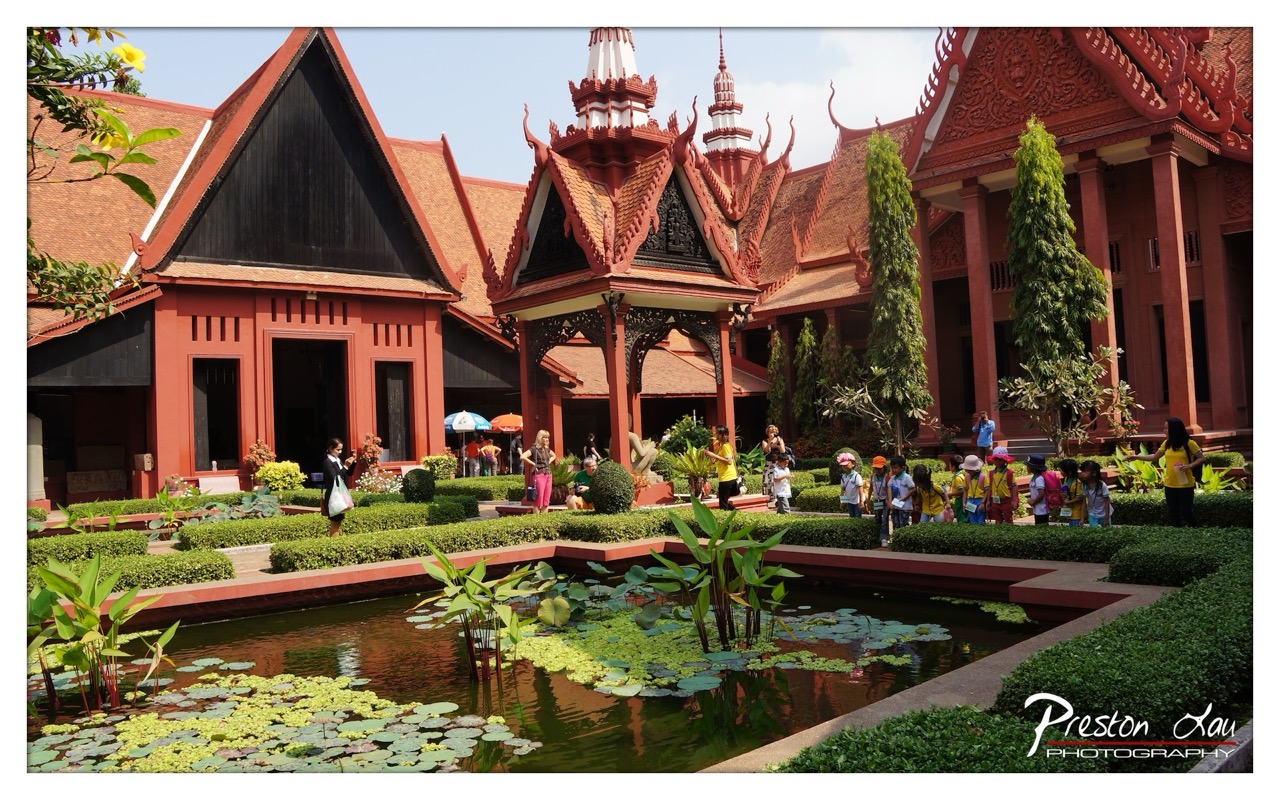

1. Overall Rating (0–10) — 7.5
This photograph captures the vibrant harmony of a traditional Cambodian courtyard, where cultural architecture meets serene garden design. The rich reds of the temple structures contrast beautifully with the lush greenery and tranquil pond, creating a scene that feels both sacred and inviting. While the composition is strong and the cultural context compelling, the presence of tourists slightly disrupts the image’s meditative quality, grounding it in the present rather than the timeless.
2. Composition (0–10) — 7.0
The framing balances the ornate architecture with the natural elements, using the pond and hedges to guide the eye through the scene. The diagonal line of the building on the left creates dynamic tension, while the group of visitors on the right adds life without overwhelming the central pavilion.
3. Lighting (0–10) — 7.5
Bright, natural daylight enhances the vivid colors and intricate details of the temple’s carvings. The sun illuminates the scene evenly, casting soft shadows that give depth without obscuring key features.
4. Color & Tone (0–10) — 8.0
The warm reds of the buildings contrast strikingly with the emerald greens of the plants and the dark, reflective water, creating a rich and balanced palette. The subtle yellow of the lotus leaves adds a delicate touch of brightness.
5. Creativity (0–10) — 7.0
The image successfully merges cultural documentation with aesthetic appeal, capturing both the architectural grandeur and the human presence within the space. While not radically innovative, it offers a thoughtful interpretation of a familiar subject.
6. Technical Quality (0–10) — 8.0
Sharp focus and clear detail throughout, particularly in the foreground and midground. The water’s reflection is crisp, and the depth of field effectively separates the architectural elements from the background.
7. Emotional Impact (0–10) — 7.5
The scene evokes a sense of reverence and tranquility, inviting the viewer to appreciate the beauty of tradition and nature. The presence of children and visitors adds a layer of warmth and continuity, suggesting the living culture of the site.
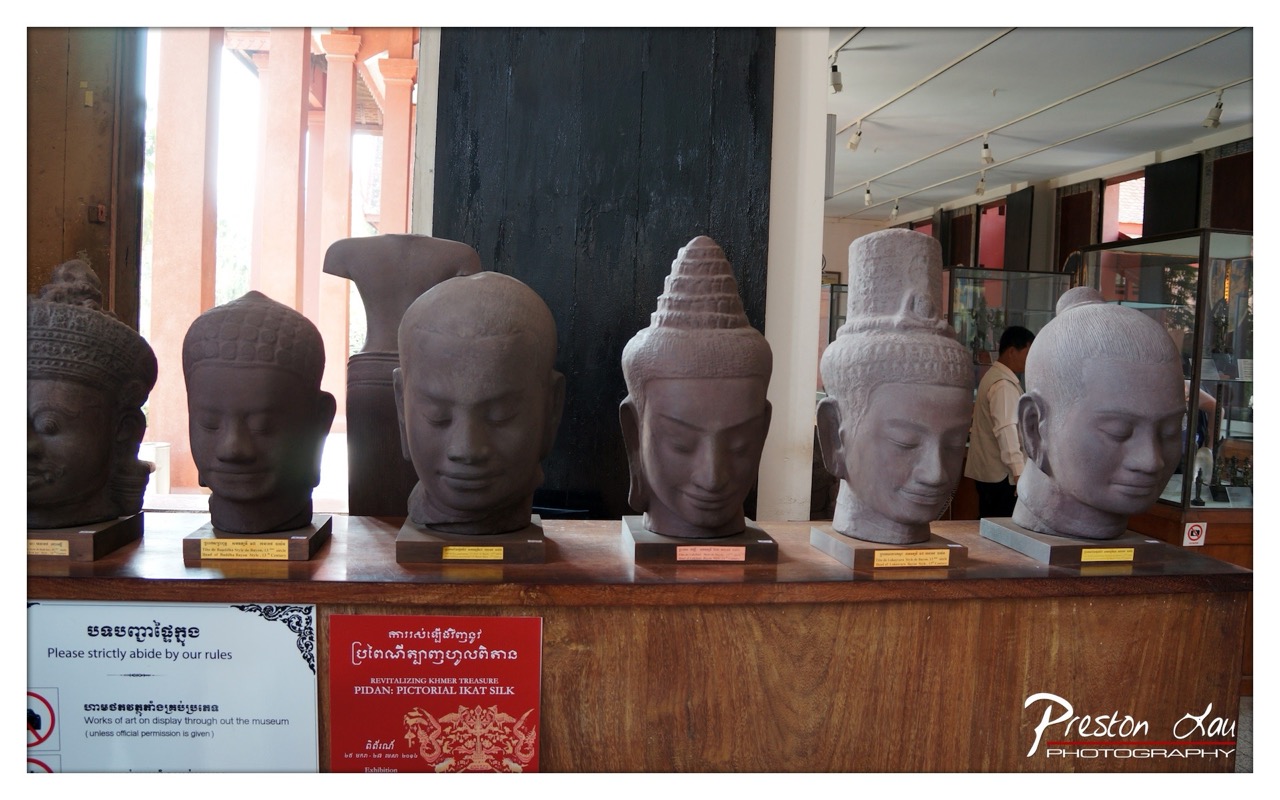

1. Overall Rating (0–10) — 7.0
This photograph captures a serene and culturally rich display of Khmer stone heads, evoking the timeless elegance of Angkorian art. The arrangement of the sculptures, with their calm expressions and intricate headdresses, creates a meditative rhythm across the frame. While the lighting and composition are solid, the image feels slightly restrained by the institutional setting and the distracting presence of signage, which detract from the visual harmony.
2. Composition (0–10) — 7.5
The row of stone heads is arranged in a balanced, horizontal line that guides the eye across the frame. The use of the wooden display case as a leading element adds depth, while the dark wall behind provides a strong contrast that emphasizes the sculptures. The inclusion of a person in the background adds context without disrupting the focus, though the composition is slightly crowded on the right.
3. Lighting (0–10) — 6.5
Natural light streams in from the left, creating soft highlights on the stone heads and enhancing their three-dimensional form. However, the lighting is uneven—some heads are brightly illuminated while others fall into shadow. The overhead fluorescent lights in the background introduce a slightly clinical tone, disrupting the organic warmth of the scene.
4. Color & Tone (0–10) — 6.0
The palette is dominated by earthy tones—muted grays, browns, and dark wood—which support the historical and solemn mood. However, the colors lack vibrancy and depth, particularly in the shadows. The red sign provides a point of contrast but feels visually jarring against the otherwise subdued tones.
5. Creativity (0–10) — 6.5
The image successfully documents a cultural exhibit with a clear sense of place and history. The photographer captures the quiet dignity of the sculptures, but the approach is more documentary than artistic. There is little use of creative angles or experimental techniques, resulting in a straightforward but effective representation.
6. Technical Quality (0–10) — 8.0
The image is sharp and well-focused, with clear details visible on the stone surfaces and the signage. The depth of field is adequate, keeping the primary subjects in focus while softly blurring the background. The exposure is generally well-balanced, though some areas are slightly overexposed due to the bright window light.
7. Emotional Impact (0–10) — 7.0
The photograph conveys a sense of reverence and stillness, inviting the viewer to reflect on the ancient craftsmanship and spiritual significance of the sculptures. The closed eyes and serene expressions of the heads evoke a quiet contemplation, creating a subtle emotional resonance despite the museum environment.
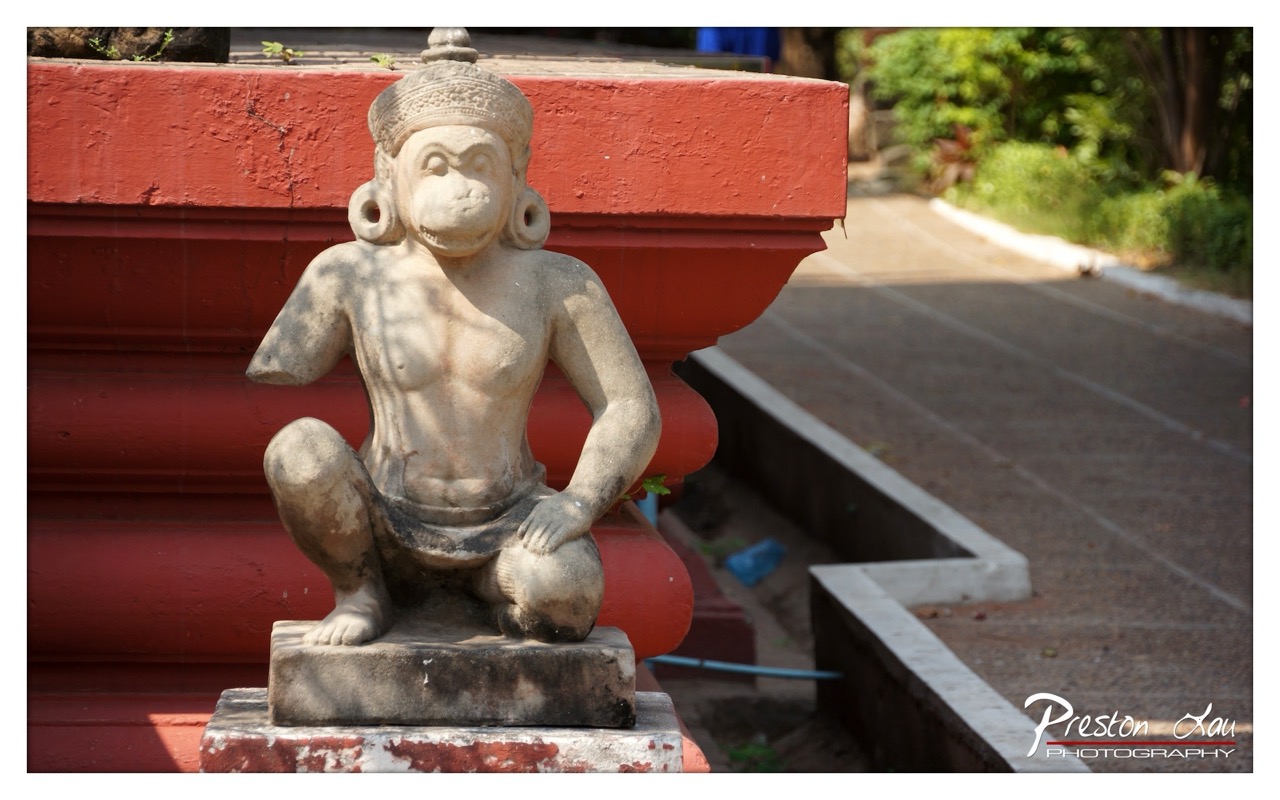

1. Overall Rating (0–10) — 7.0
This photograph captures the quiet dignity of a weathered stone statue, its stoic presence framed by the bold red of a temple structure. The contrast between the aged, textured stone and the vibrant, painted architecture creates a compelling visual tension, while the soft sunlight enhances the sculpture’s contours. Though the background’s slight clutter and shallow depth of field distract momentarily, the image succeeds in evoking a sense of cultural reverence and time-worn endurance.
2. Composition (0–10) — 7.0
The statue is placed slightly off-center, creating a dynamic balance with the strong diagonal of the red architectural element. The leading line of the path in the background draws the eye toward the subject, though the framing could be tighter to eliminate distractions.
3. Lighting (0–10) — 7.5
Natural sunlight casts soft shadows that accentuate the texture and form of the stone, giving the statue a three-dimensional quality. The light is warm and directional, enhancing the mood without creating harsh contrasts.
4. Color & Tone (0–10) — 7.0
The vivid red of the temple wall provides a striking contrast to the muted gray of the stone, creating a visually engaging palette. The overall tone is balanced, with a warm, earthy feel that complements the cultural subject.
5. Creativity (0–10) — 7.5
The juxtaposition of the ancient statue with the brightly painted structure offers a thoughtful visual narrative about tradition and preservation. The photographer’s choice to emphasize texture and color adds a layer of storytelling beyond mere documentation.
6. Technical Quality (0–10) — 8.0
Sharp focus on the statue, with a shallow depth of field that softly blurs the background, enhances subject prominence. The image is clean, with no visible noise or technical flaws.
7. Emotional Impact (0–10) — 7.0
The stillness of the statue and the quiet setting evoke a sense of contemplation and respect. The viewer is invited to reflect on the passage of time and the enduring nature of cultural symbols.
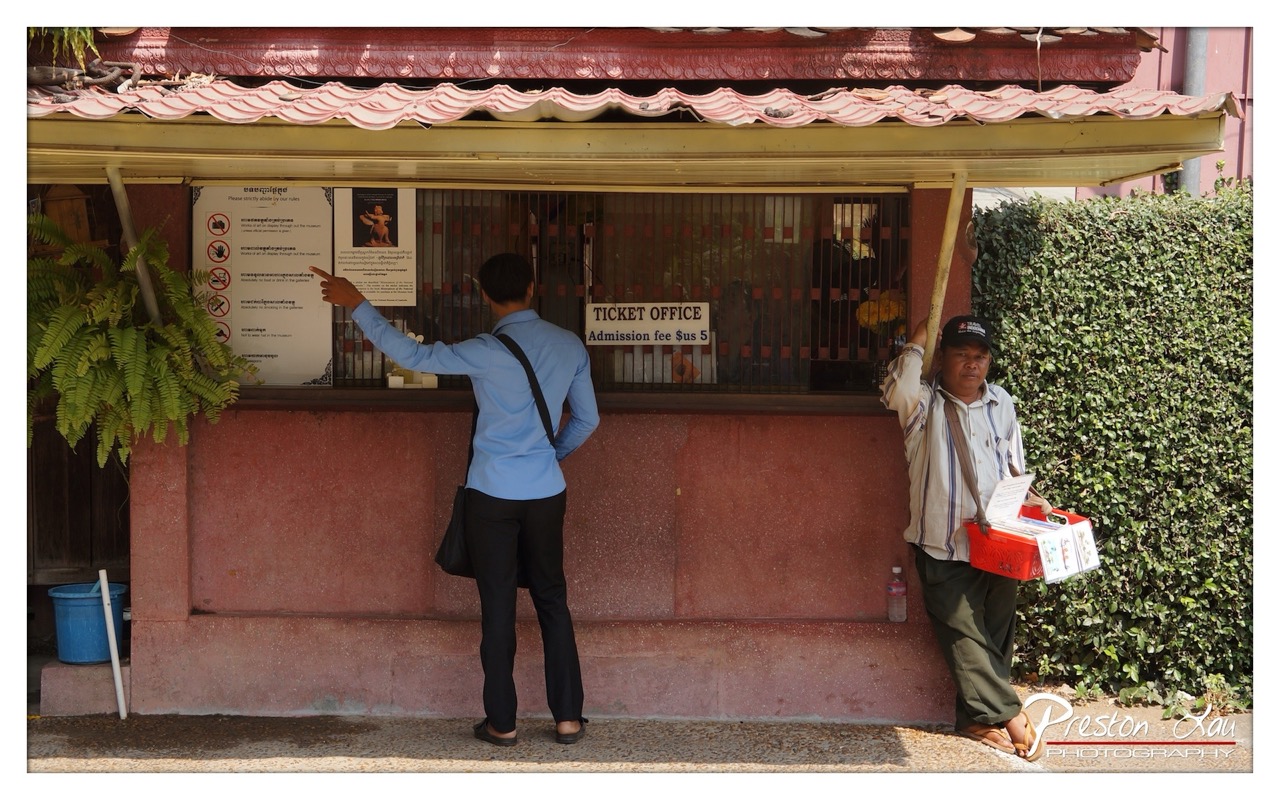

1. Overall Rating (0–10) — 7.0
This photograph captures a candid moment at a ticket office, blending cultural authenticity with quiet human interaction. The contrast between the tourist and the vendor highlights a slice of everyday life in a Southeast Asian setting. While the image feels slightly overexposed and compositionally uneven, its narrative strength lies in its unposed realism and the subtle story of exchange—both monetary and cultural.
2. Composition (0–10) — 6.0
The framing is slightly off-center, with the ticket office dominating the left side and the vendor positioned awkwardly on the right. The man pointing at the sign creates a visual anchor, but the imbalance in weight between the two figures disrupts harmony.
3. Lighting (0–10) — 6.0
Harsh daylight flattens the scene, casting strong shadows and washing out some details. The bright overhead light creates high contrast, particularly on the red wall and the vendor’s face, but it lacks the subtlety needed to evoke mood.
4. Color & Tone (0–10) — 6.5
The dominant red of the ticket booth provides a bold visual anchor, complemented by the green foliage. However, the color palette feels slightly oversaturated, especially in the reds and greens, which detract from naturalism.
5. Creativity (0–10) — 7.0
The image succeeds in capturing a real-life interaction, telling a story of tourism, commerce, and cultural exchange. The juxtaposition of the modern tourist and the traditional vendor adds depth, though the approach is more documentary than artistic.
6. Technical Quality (0–10) — 7.5
The focus is sharp on the central figures, and the details on the signage and clothing are clear. The photographer has managed to capture a complex scene with good resolution, despite the challenging lighting.
7. Emotional Impact (0–10) — 6.5
The image evokes a sense of place and routine, inviting the viewer to consider the quiet intersections of tourism and local life. While not emotionally charged, it carries a quiet dignity in its depiction of everyday work and interaction.
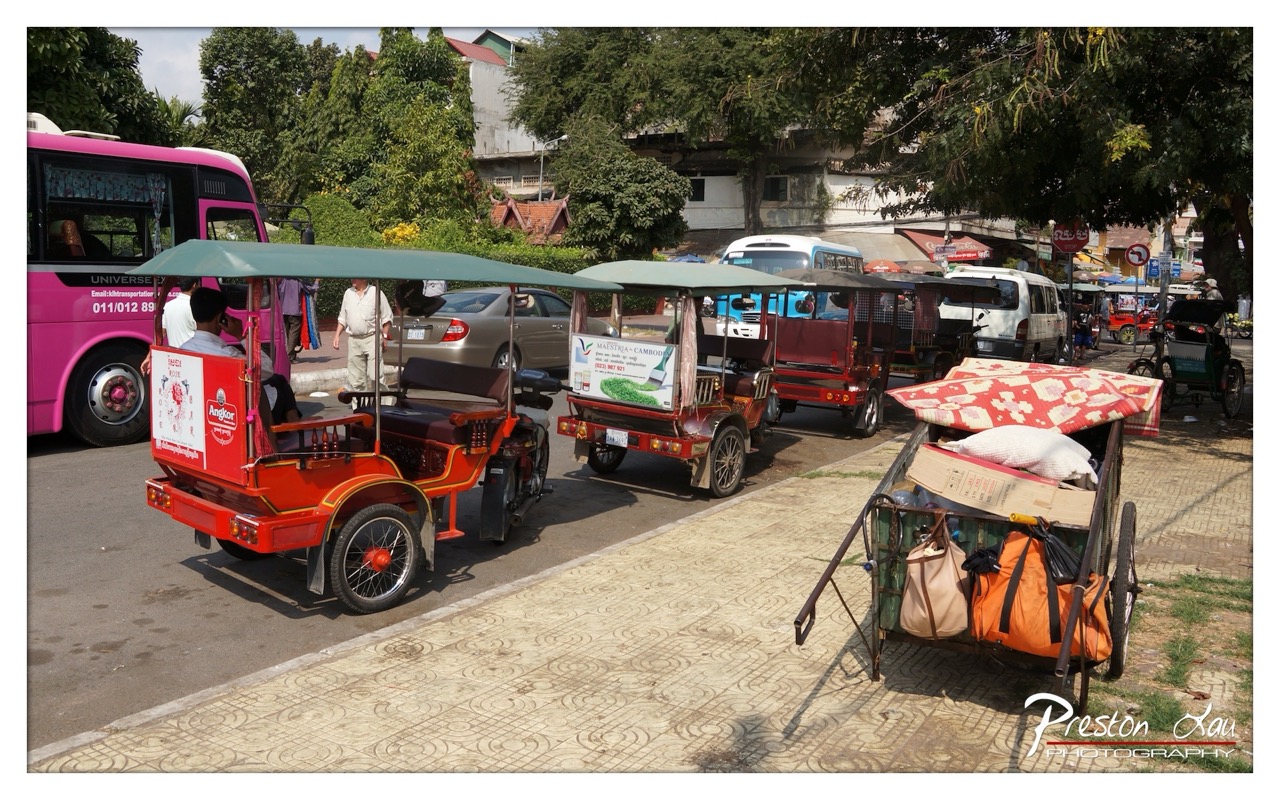

1. Overall Rating (0–10) — 6.8
This photograph captures the vibrant energy of a bustling Southeast Asian street, where traditional rickshaws and modern buses coexist in a dynamic urban tableau. The rich colors and layered activity convey a sense of daily life in motion, though the composition’s density slightly dilutes the focus. While the image successfully documents cultural authenticity, its visual narrative is more documentary than artistic, relying on the scene’s inherent dynamism rather than deliberate staging.
2. Composition (0–10) — 6.0
The frame is filled with overlapping vehicles and pedestrians, creating a sense of congestion that works both as a strength and a weakness. The rickshaws and cart in the foreground guide the eye into the scene, but the lack of clear focal point and the scattered elements result in a composition that feels busy rather than balanced.
3. Lighting (0–10) — 7.0
Bright, natural daylight illuminates the scene evenly, enhancing the vividness of the reds, pinks, and greens. The overhead sun creates soft shadows that add depth without obscuring details, supporting the image’s energetic, sunlit atmosphere.
4. Color & Tone (0–10) — 7.5
The palette is rich and varied, with the striking magenta bus and red rickshaws standing out against the green foliage and neutral pavement. The warm tones lend the scene a lively, almost cinematic quality, though the color saturation feels slightly overdone in the highlights.
5. Creativity (0–10) — 6.5
The image leverages the inherent visual interest of a busy street to tell a story of cultural fusion and urban rhythm. While the concept is grounded in reality, the execution lacks a unique artistic perspective, leaning more toward observational documentation than imaginative storytelling.
6. Technical Quality (0–10) — 7.5
The photograph is sharp and well-focused, with clear details visible in the rickshaws, signage, and surrounding environment. The exposure is balanced, and the lens choice captures the scene effectively, though slight overexposure in the sky and highlights slightly detracts from overall refinement.
7. Emotional Impact (0–10) — 6.0
The image evokes a sense of motion and cultural authenticity, inviting viewers into a moment of everyday life. While the scene is engaging, the emotional resonance remains somewhat distant, as the viewer is an observer rather than a participant in the narrative.


1. Overall Rating (0–10) — 7.5
This photograph captures the intricate elegance of a traditional Southeast Asian temple spire, standing tall against a soft, cloud-dappled sky. The low-angle perspective emphasizes the structure’s grandeur and spiritual ascent, while the weathered textures and ornate carvings add a sense of history and reverence. While the image is visually striking, the muted color palette slightly tempers its emotional resonance, leaving room for greater vibrancy and atmosphere.
2. Composition (0–10) — 8.0
The low-angle framing centers the spire with strong vertical emphasis, creating a sense of ascension and reverence. The symmetrical placement of the roofline and the balanced use of negative space in the sky enhance the image’s formal harmony and focus.
3. Lighting (0–10) — 7.0
Soft, diffused daylight illuminates the temple’s details evenly, avoiding harsh shadows and allowing the intricate carvings to be clearly visible. The gentle light enhances the texture of the stone while maintaining a serene, contemplative mood.
4. Color & Tone (0–10) — 6.5
The palette is dominated by muted blues and grays, with subtle hints of gold in the decorative elements. While the tones are harmonious, the lack of saturation slightly diminishes the visual impact, making the scene feel more documentary than evocative.
5. Creativity (0–10) — 7.5
The choice of a low-angle perspective and focus on architectural detail transforms a simple structural image into a meditation on tradition and spirituality. The photographer’s intent to highlight cultural heritage is effectively realized through thoughtful framing and subject selection.
6. Technical Quality (0–10) — 8.5
Sharp focus and clean detail across the frame highlight the craftsmanship of the temple’s design. The exposure is well-balanced, and the image is free of distracting artifacts or noise.
7. Emotional Impact (0–10) — 7.0
The image evokes a quiet sense of awe and reverence, inviting the viewer to reflect on the enduring legacy of the structure. The combination of architectural beauty and spiritual symbolism creates a contemplative mood, though the subdued colors keep the emotional depth from fully resonating.
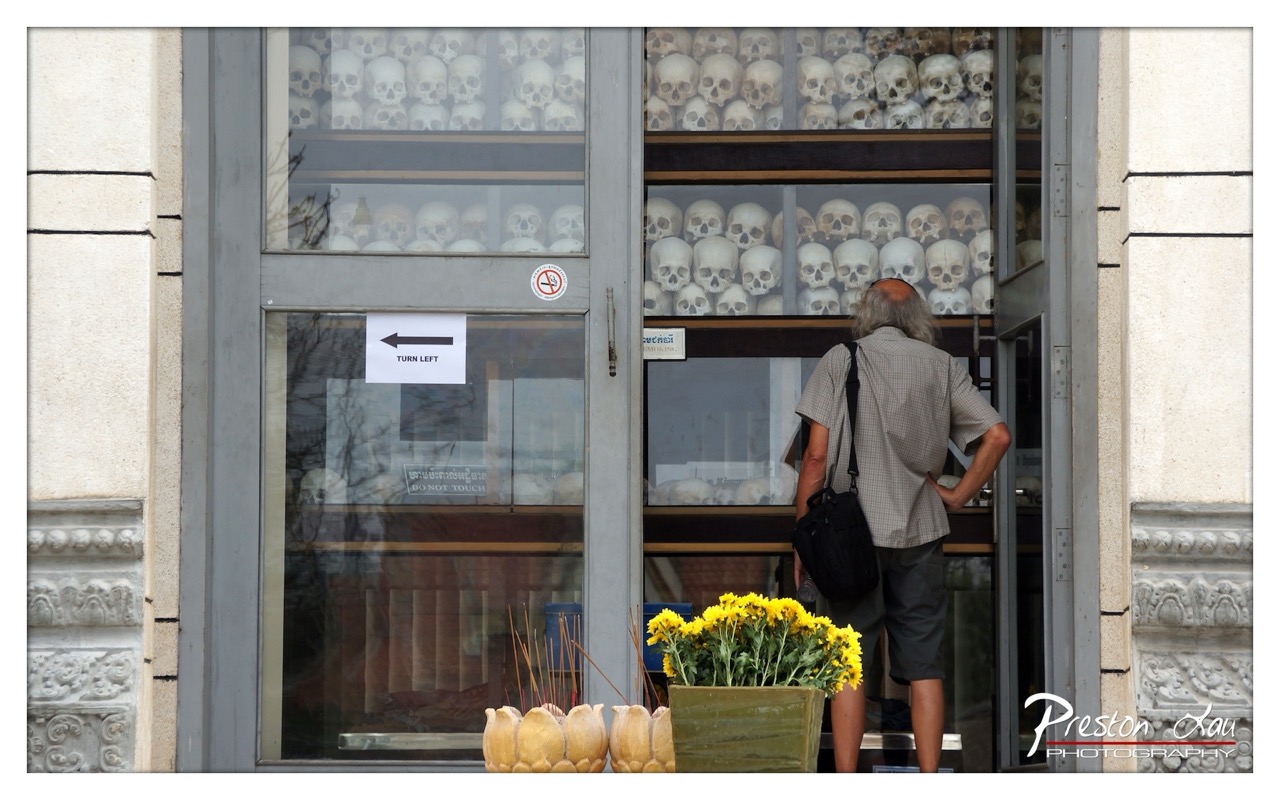

1. Overall Rating (0–10) — 7.0
This photograph captures a solemn and thought-provoking moment at a memorial site, where the juxtaposition of human reverence and mortality creates a powerful visual narrative. The viewer is drawn into the scene by the man’s contemplative stance and the unsettling display of skulls behind glass, evoking both curiosity and unease. While the image succeeds in conveying its somber tone, the composition’s slight imbalance and overexposed highlights temper its overall impact.
2. Composition (0–10) — 6.5
The man’s placement on the right creates visual tension with the left-side sign and flowers, but the strong vertical lines of the doorway help anchor the frame. A tighter crop could enhance focus on the subject and the display.
3. Lighting (0–10) — 6.0
Natural daylight illuminates the scene clearly, but the bright reflection on the glass and overexposed highlights on the skulls reduce detail and depth, detracting from the mood.
4. Color & Tone (0–10) — 6.5
The muted grays and whites of the skulls contrast with the vibrant yellow flowers, creating a striking but slightly jarring palette. The overall tone is somber, yet the color vibrancy feels unevenly distributed.
5. Creativity (0–10) — 7.5
The image is conceptually compelling, using juxtaposition—life (flowers), death (skulls), and human reflection—to tell a layered story. The photographer captures a moment of quiet reverence that invites interpretation.
6. Technical Quality (0–10) — 7.0
The image is sharp and well-focused, particularly on the man and the foreground elements. However, the reflections on the glass and slight overexposure in highlights slightly compromise technical precision.
7. Emotional Impact (0–10) — 7.0
The scene evokes a sense of solemn reflection and cultural significance, prompting the viewer to contemplate mortality and remembrance. The man’s posture and the setting create a poignant, introspective mood.
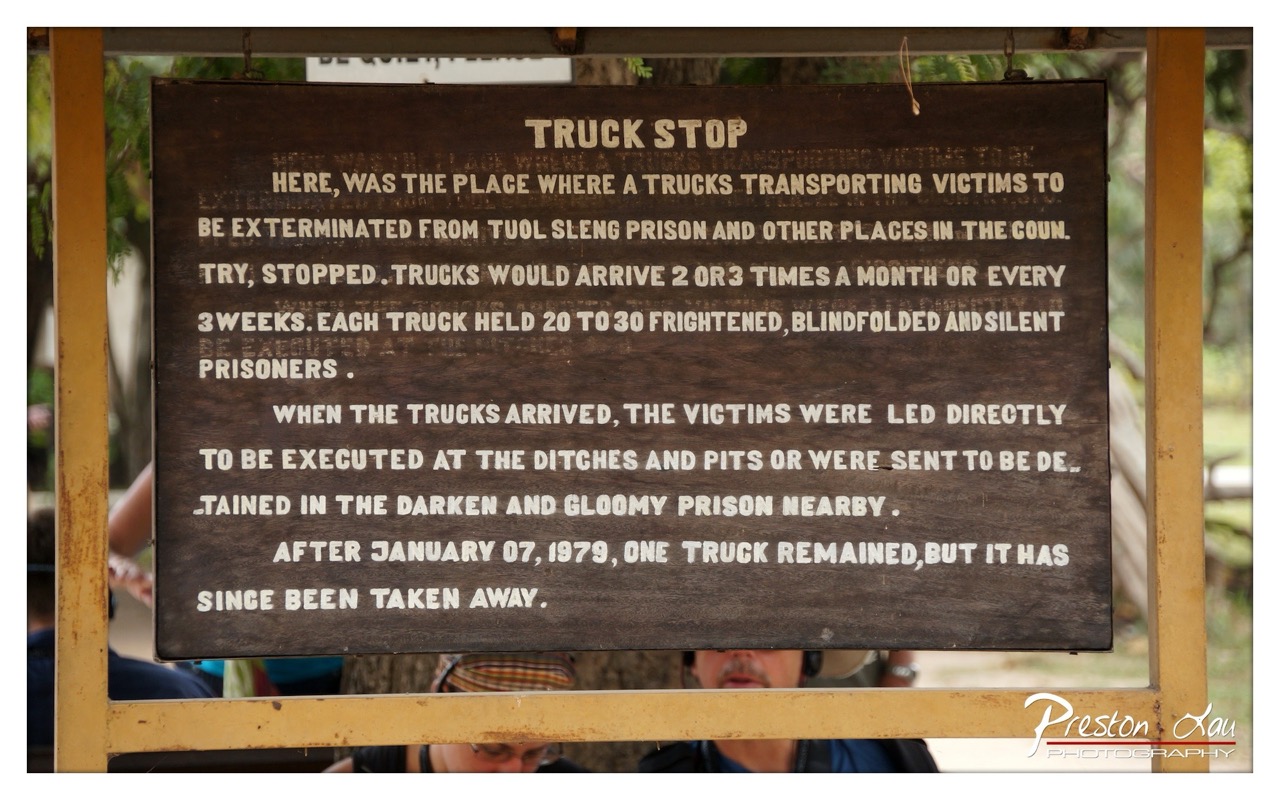

1. Overall Rating (0–10) — 8.0
This photograph powerfully conveys a somber historical memorial, where the weight of memory is etched not only in the text but in the quiet presence of visitors. The sign, with its stark and unflinching narrative, stands as both a historical document and a solemn tribute. While the framing includes a slight distraction in the lower foreground, the emotional gravity of the scene is preserved, creating a compelling and respectful homage to the victims.
2. Composition (0–10) — 7.0
The sign is centrally framed, drawing immediate attention, but the presence of blurred figures in the lower portion slightly disrupts the visual focus, creating a subtle tension between the past and present.
3. Lighting (0–10) — 7.5
Natural daylight illuminates the sign evenly, enhancing readability while preserving the somber mood. The soft shadows add depth without obscuring the text.
4. Color & Tone (0–10) — 7.0
The dark wood of the sign contrasts sharply with the white lettering, creating a strong visual hierarchy. The muted greens and browns in the background support the solemn tone without overpowering the subject.
5. Creativity (0–10) — 8.0
The image captures both the factual and emotional dimensions of the site, using the juxtaposition of the historical sign and the faint presence of visitors to imply continuity between memory and the living present.
6. Technical Quality (0–10) — 8.0
Sharp focus on the sign ensures legibility, and the depth of field effectively isolates the subject while softly blurring the background.
7. Emotional Impact (0–10) — 9.0
The message carries profound weight, evoking a deep sense of reflection and sorrow. The viewer is confronted with a painful history, and the image’s restraint allows the words to speak for themselves.
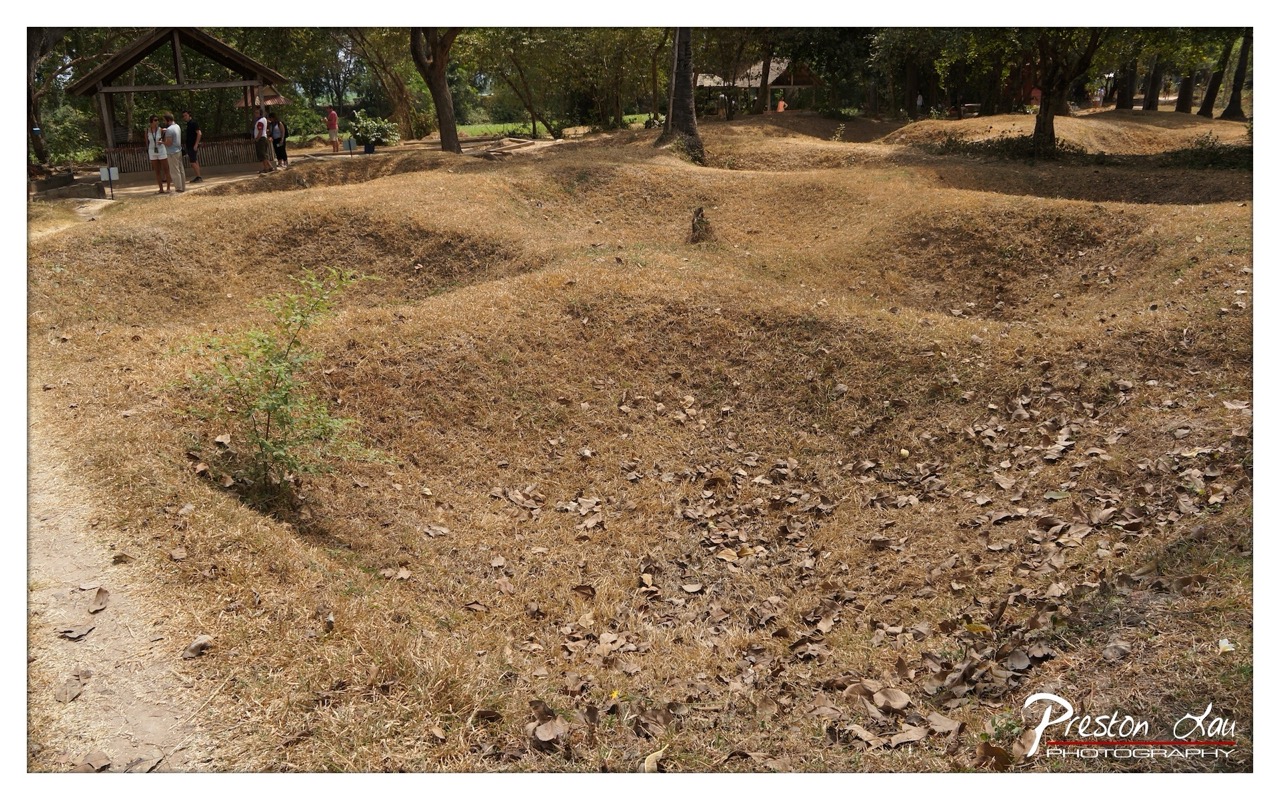

1. Overall Rating (0–10) — 6.0
This photograph captures a quiet, sun-drenched archaeological site, where the undulating mounds of earth evoke a sense of ancient history reclaimed by nature. The dry, golden grass and scattered leaves lend a melancholic stillness to the scene, while the distant figures in the shelter provide a subtle human scale. Though the image is grounded in authenticity and atmosphere, its composition and lighting lack the dynamic tension needed to elevate it beyond a simple documentary record.
2. Composition (0–10) — 5.5
The wide-angle perspective flattens the landscape, and the diagonal path on the left competes with the natural flow of the mounds. The group of people in the background is slightly off-center, drawing attention but not anchoring the frame effectively.
3. Lighting (0–10) — 6.0
Bright, overhead sunlight creates harsh shadows and flattens textures, but the consistent light across the scene ensures clarity and reveals the topography of the mounds.
4. Color & Tone (0–10) — 5.5
The palette is dominated by warm, earthy browns and yellows, which harmonize with the arid environment. However, the lack of tonal contrast and muted saturation gives the image a somewhat washed-out quality.
5. Creativity (0–10) — 6.0
The photograph captures a place of historical resonance, but the approach is conventional. A more deliberate framing or timing could have introduced narrative depth or a stronger emotional arc.
6. Technical Quality (0–10) — 7.0
The image is sharp and detailed, with good focus across the frame. The exposure is balanced, and the camera’s resolution renders the texture of the dry grass and leaves clearly.
7. Emotional Impact (0–10) — 5.5
The scene evokes a quiet contemplation of time and decay, but the emotional distance created by the wide composition and flat lighting limits its ability to fully engage the viewer.
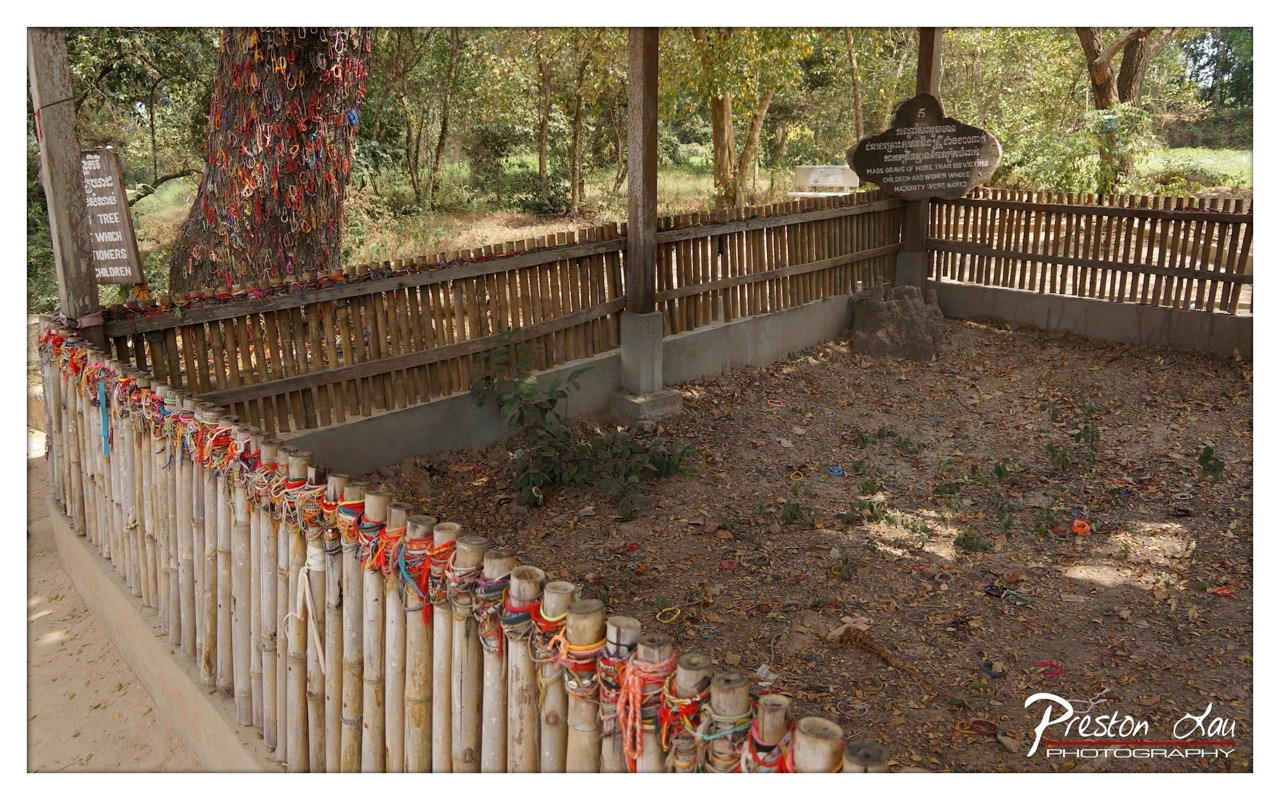

1. Overall Rating (0–10) — 6.8
This photograph captures a solemn, culturally rich site where tradition and memory converge in the form of a sacred tree and offerings. The vibrant ribbons and bracelets adorning the bamboo fence create a striking visual rhythm, contrasting with the earthy tones of the ground and the quiet stillness of the surroundings. While the scene is rich in symbolic meaning and narrative potential, the composition feels slightly unbalanced, and the lighting, though clear, lacks the dramatic depth that might elevate the emotional resonance of the site.
2. Composition (0–10) — 6.0
The frame is dominated by the diagonal sweep of the bamboo fence, which draws the eye toward the tree and signpost, but the placement of the sign on the left edge creates a visual imbalance. The central area feels underutilized, with too much open, empty ground in the foreground.
3. Lighting (0–10) — 6.5
Natural daylight illuminates the scene evenly, preserving details in both the shadows and highlights. The light is soft and diffused, suggesting an overcast sky or late afternoon, which contributes to the contemplative mood without creating harsh contrasts.
4. Color & Tone (0–10) — 7.0
The palette is grounded in earth tones—browns, tans, and muted greens—punctuated by the vivid reds, oranges, and blues of the ribbons. This contrast enhances visual interest and emphasizes the human presence and ritual significance of the site.
5. Creativity (0–10) — 7.5
The image successfully captures a unique cultural practice, using the colorful ribbons as a metaphor for devotion and connection. The juxtaposition of the natural environment with human-made markers and inscriptions offers a layered narrative that invites interpretation.
6. Technical Quality (0–10) — 7.5
The photograph is sharp and well-focused, with fine detail visible in the texture of the bamboo, the bark of the tree, and the text on the signs. The exposure is balanced, and the camera’s dynamic range effectively captures both shadow and highlight areas.
7. Emotional Impact (0–10) — 7.0
The image evokes a sense of reverence and quiet reflection, inviting the viewer to contemplate the stories behind the offerings. The presence of the ribbons suggests personal connections and hopes, creating a subtle emotional pull that lingers beyond the frame.
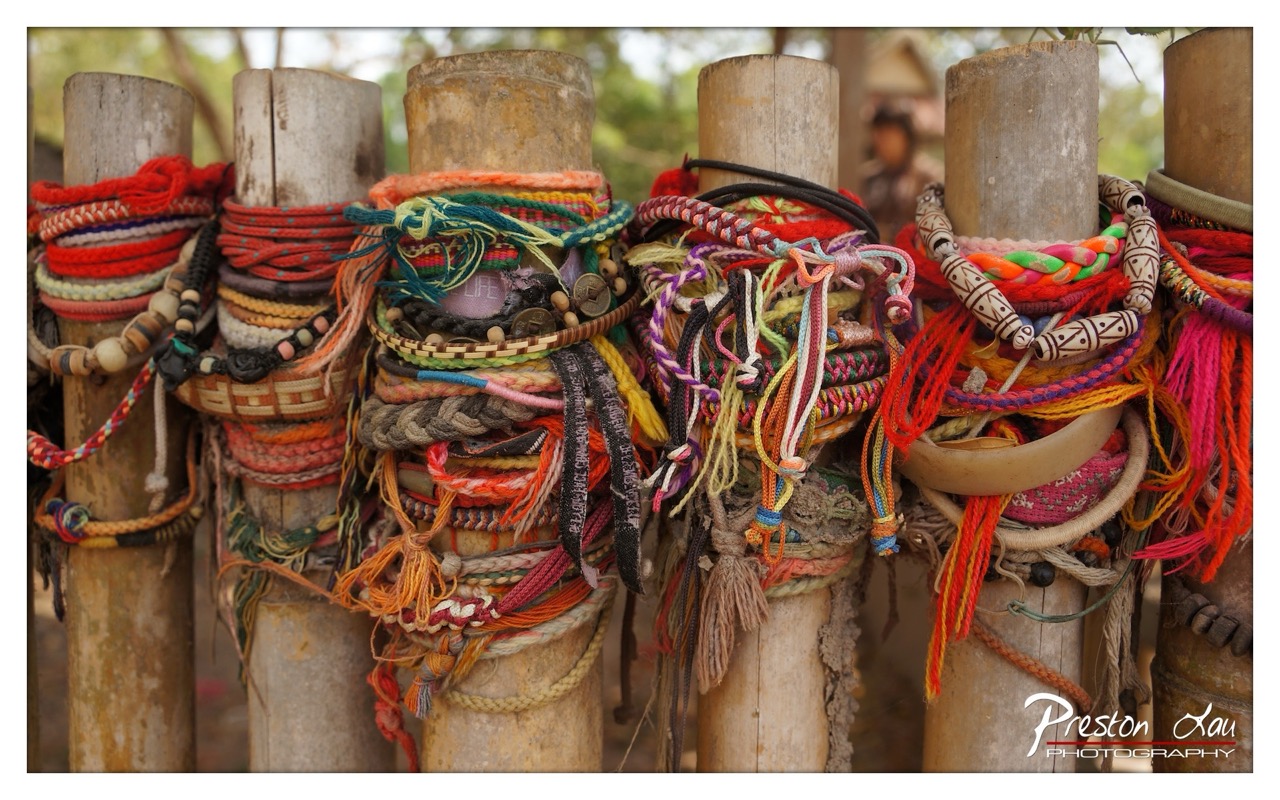

1. Overall Rating (0–10) — 8.0
This photograph bursts with cultural richness, capturing a vibrant tapestry of woven bracelets and offerings tied to weathered wooden posts. The dense layering of color and texture tells a story of tradition, devotion, and community, creating a visually compelling narrative. While the composition is richly detailed, the sheer volume of elements risks visual clutter, slightly diminishing the clarity of the central message.
2. Composition (0–10) — 7.5
The image is tightly framed, emphasizing the texture and density of the offerings. The vertical alignment of the posts creates a rhythmic structure, guiding the eye across the frame. However, the overlapping elements and lack of negative space slightly reduce the visual hierarchy, making the scene feel crowded.
3. Lighting (0–10) — 7.0
Natural daylight illuminates the scene evenly, allowing the vibrant colors of the cords and beads to stand out. The soft, diffused light enhances the textures without creating harsh shadows, contributing to the organic and authentic feel of the image.
4. Color & Tone (0–10) — 9.0
The palette is rich and diverse, with bold reds, oranges, greens, and purples creating a dynamic contrast against the muted tones of the weathered wood. The color saturation enhances the visual energy of the scene, evoking a sense of celebration and cultural vitality.
5. Creativity (0–10) — 8.5
The photograph transcends mere documentation by transforming a cultural artifact into a visual poem of color and texture. The artist captures the spirit of ritual and community through an intimate, detail-oriented lens, offering viewers a glimpse into a living tradition.
6. Technical Quality (0–10) — 8.0
The image is sharp and well-focused, with fine detail visible in the braids, beads, and fibers. The shallow depth of field isolates the central elements while softly blurring the background, enhancing the sense of depth and focus.
7. Emotional Impact (0–10) — 8.5
The image evokes a deep sense of connection and reverence, inviting the viewer to reflect on the personal and communal significance of the offerings. The warmth of the colors and the tactile quality of the materials create a powerful emotional resonance, suggesting stories of hope, healing, and faith.
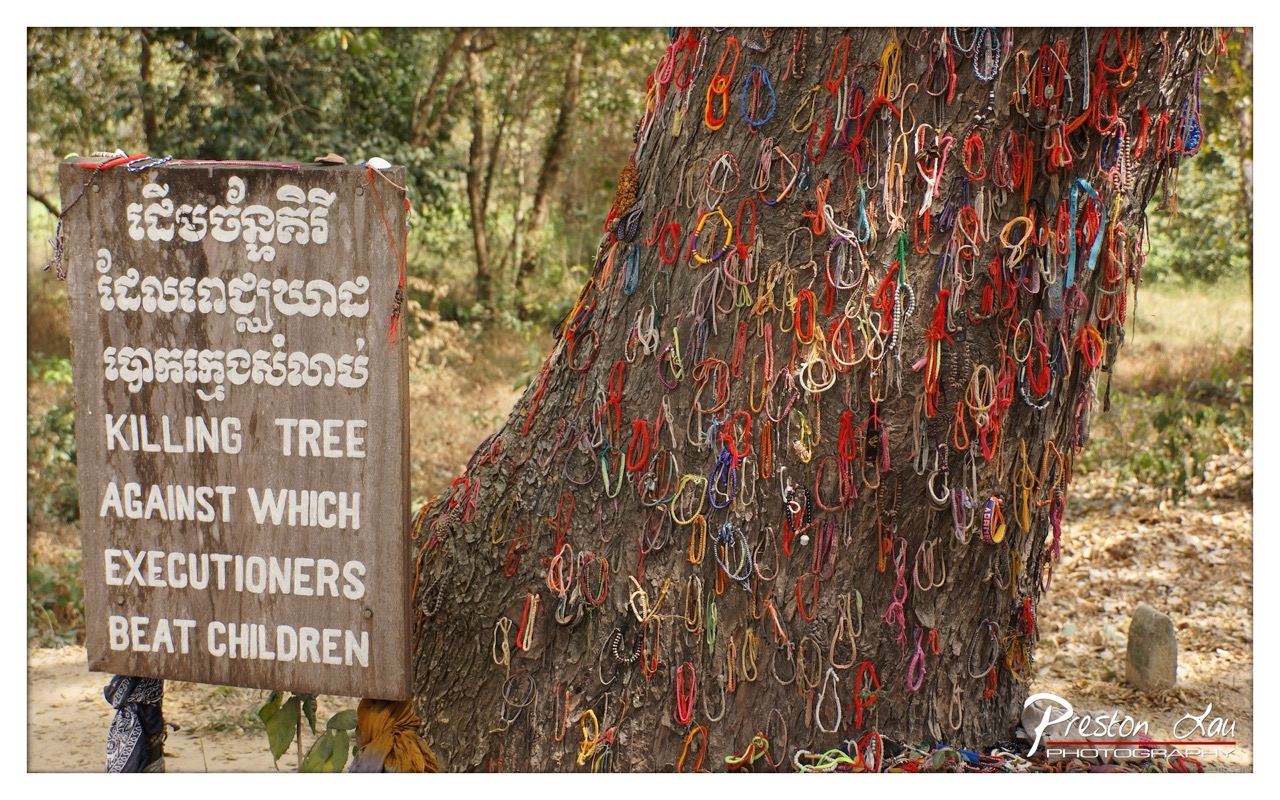

1. Overall Rating (0–10) — 7.5
This photograph powerfully juxtaposes natural beauty with harrowing historical weight, capturing a site of profound tragedy through the lens of reverence and memory. The vibrant ribbons tied to the tree create a striking visual contrast against the somber narrative conveyed by the sign, transforming the scene into both a memorial and a meditation on survival. While the image is emotionally resonant, the slightly cluttered composition and overexposed background temper its visual impact, preventing it from achieving full artistic cohesion.
2. Composition (0–10) — 6.0
The sign is slightly off-center and partially cropped, disrupting visual balance. The tree dominates the right side, creating a strong diagonal that draws the eye, but the uneven framing and foreground elements reduce compositional harmony.
3. Lighting (0–10) — 6.5
Natural daylight provides even illumination, though the background is overexposed, causing loss of detail in the foliage. The light enhances the vividness of the ribbons but flattens the tree’s texture, diminishing depth.
4. Color & Tone (0–10) — 7.0
The bright, varied colors of the ribbons contrast sharply with the muted earth tones of the tree and ground, creating a visually arresting palette. However, the overexposure in the background slightly washes out the overall tonal range.
5. Creativity (0–10) — 8.0
The image is conceptually strong, blending cultural ritual with historical remembrance. The use of the tree as a canvas for symbolic offerings elevates the photograph from mere documentation to a poignant act of collective memory.
6. Technical Quality (0–10) — 7.5
Sharp focus on the sign and tree is clear, with good detail in the ribbons. The exposure is uneven, particularly in the background, but the core elements remain well-defined.
7. Emotional Impact (0–10) — 8.5
The image evokes a deep sense of solemnity and resilience, with the vibrant ribbons serving as a powerful symbol of hope and healing. It compels the viewer to reflect on the past while honoring those affected, creating a lasting emotional resonance.
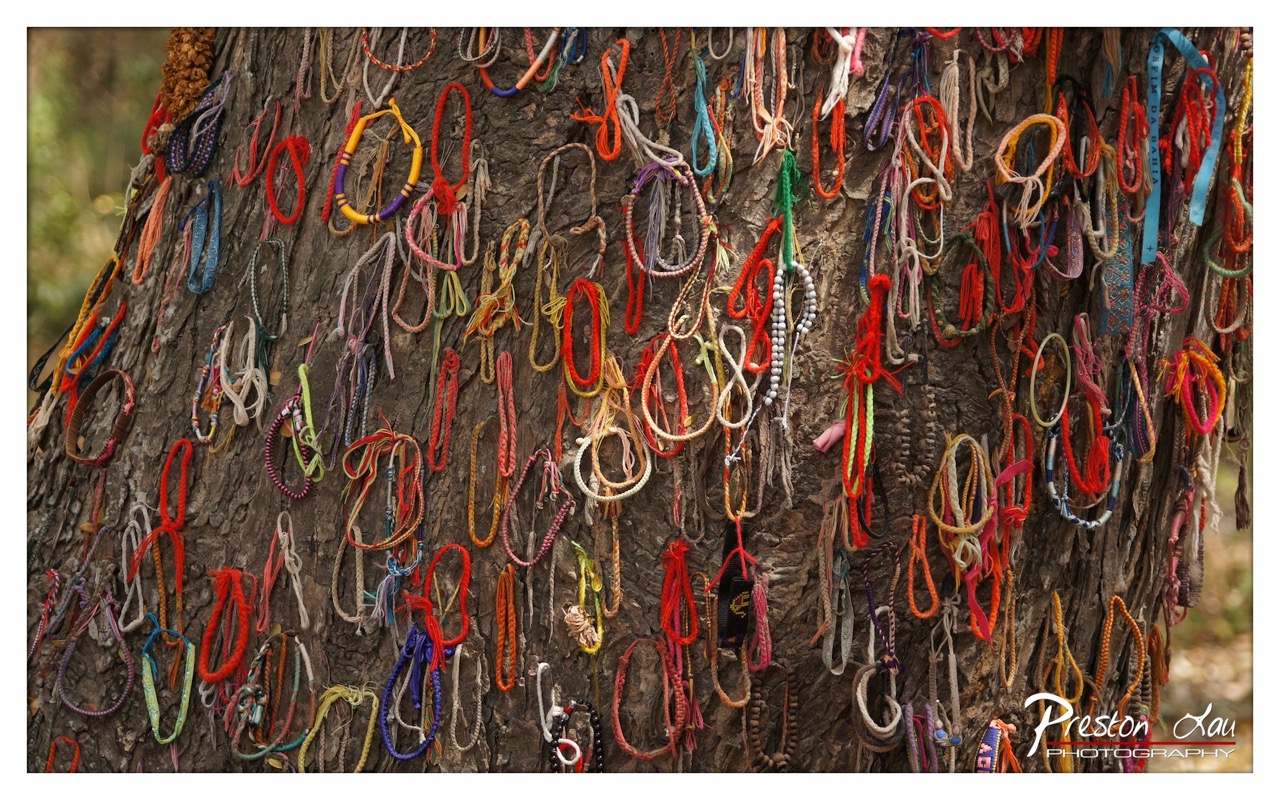

1. Overall Rating (0–10) — 7.5
This photograph captures a rich tapestry of color and texture, where the vibrant, tangled bracelets and cords transform a simple tree trunk into a deeply symbolic and visually compelling narrative. The sheer density of the offerings creates a sense of collective devotion, with the organic grain of the bark providing a grounding contrast to the chaotic beauty of the woven threads. While the composition feels slightly overcrowded, the image succeeds in evoking both cultural significance and emotional resonance, drawing the viewer into a quiet moment of human connection and ritual.
2. Composition (0–10) — 6.5
The frame is tightly packed, emphasizing the abundance of bracelets, but the lack of clear focal point or visual hierarchy makes the image feel visually dense rather than balanced. A slightly tighter crop could enhance focus and guide the eye more deliberately.
3. Lighting (0–10) — 7.0
Natural, diffused light softly illuminates the scene, preserving the vividness of the colors without harsh shadows or overexposure. The light enhances the texture of the bark and the subtle variations in the materials, contributing to the image’s tactile quality.
4. Color & Tone (0–10) — 8.5
A bold and varied palette of reds, blues, yellows, and purples contrasts beautifully with the earthy brown of the tree, creating a dynamic and energetic visual rhythm. The colors feel vibrant yet harmonious, reinforcing the sense of cultural richness and communal expression.
5. Creativity (0–10) — 8.0
The photograph transforms a simple cultural practice into a visually poetic statement. The choice to focus on the accumulation of offerings, rather than the ritual itself, demonstrates originality and a strong sense of storytelling through texture and pattern.
6. Technical Quality (0–10) — 8.0
Sharp focus throughout the frame ensures clarity in both the bark’s texture and the fine details of the bracelets. The image is well-exposed, with no apparent technical flaws in focus, noise, or depth of field.
7. Emotional Impact (0–10) — 8.0
The image evokes a deep sense of reverence and human connection, inviting viewers to contemplate the personal and collective hopes tied to each thread and knot. The visual weight of the offerings suggests a history of devotion, creating a quiet but powerful emotional pull.
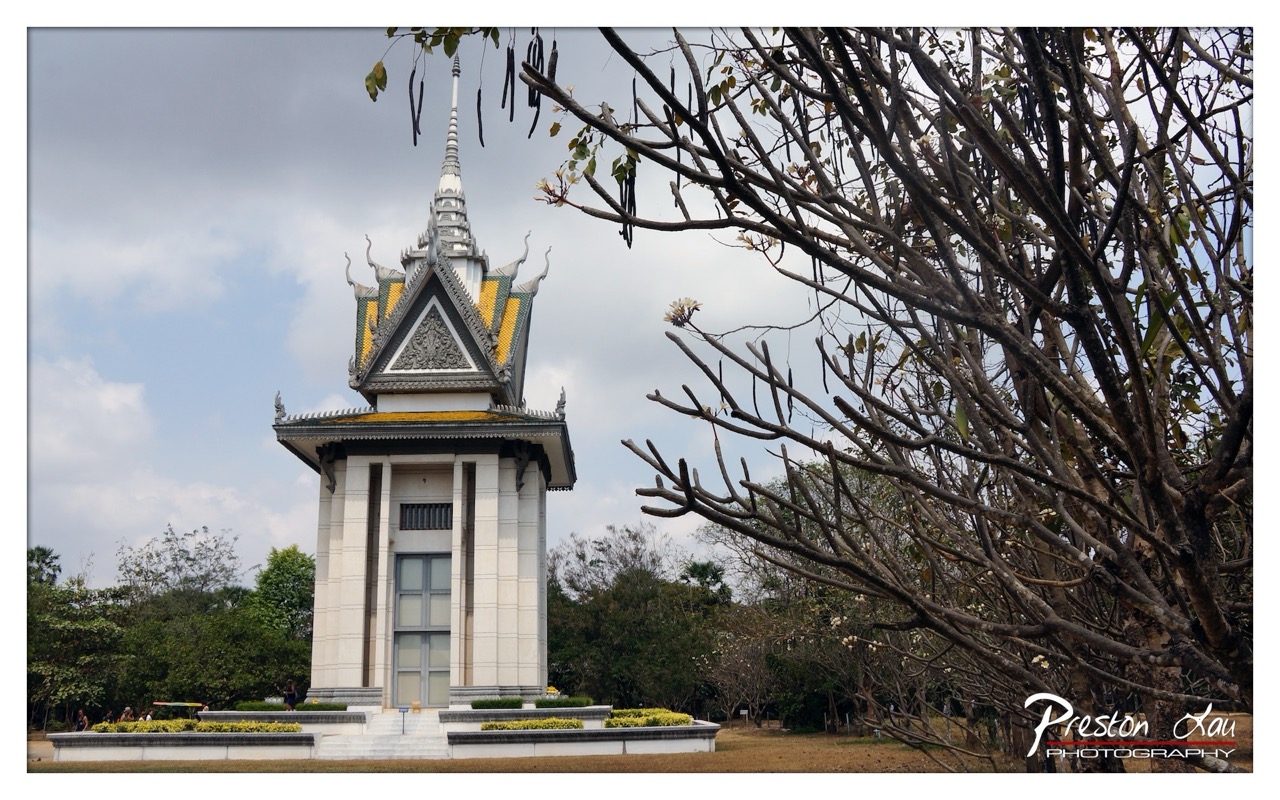

1. Overall Rating (0–10) — 7.0
This photograph captures the serene dignity of a traditional Cambodian stupa, framed by the organic silhouette of tree branches in the foreground. The interplay between the ornate architecture and the natural elements creates a contemplative mood, evoking a sense of cultural reverence and timelessness. While the composition is visually rich, the overcast sky and slightly muted tones temper its emotional intensity, preventing it from achieving a fully immersive presence.
2. Composition (0–10) — 7.5
The stupa is well-centered, drawing the eye with its vertical symmetry, while the framing branches add depth and a natural vignette. The placement of the structure slightly left of center creates a balanced asymmetry that enhances visual interest.
3. Lighting (0–10) — 6.0
Diffused light from the overcast sky softens shadows and evenly illuminates the stupa, preserving detail in the intricate roofwork. However, the lack of direct sunlight diminishes the vibrancy of the yellow and green tiles, slightly flattening the overall mood.
4. Color & Tone (0–10) — 6.5
The color palette is harmonious, with the white stone of the stupa contrasting against the muted greens and grays of the foliage and sky. The yellow accents on the roof provide a subtle pop, but the overall tone is restrained, leaning toward a subdued, almost monochromatic feel.
5. Creativity (0–10) — 7.0
The use of foreground branches as a natural frame adds a layer of visual storytelling, suggesting the viewer is peeking into a sacred space. The fusion of cultural architecture with organic elements offers a thoughtful, layered perspective.
6. Technical Quality (0–10) — 8.0
The image is sharp and detailed, particularly in the architectural elements of the stupa. Focus is consistent across the frame, and the depth of field is well-managed, capturing both the foreground and background with clarity.
7. Emotional Impact (0–10) — 6.5
The photograph conveys a quiet reverence, inviting contemplation of cultural heritage. The subdued lighting and natural framing evoke a sense of peace, though the lack of dramatic contrast or dynamic light limits its emotional resonance.
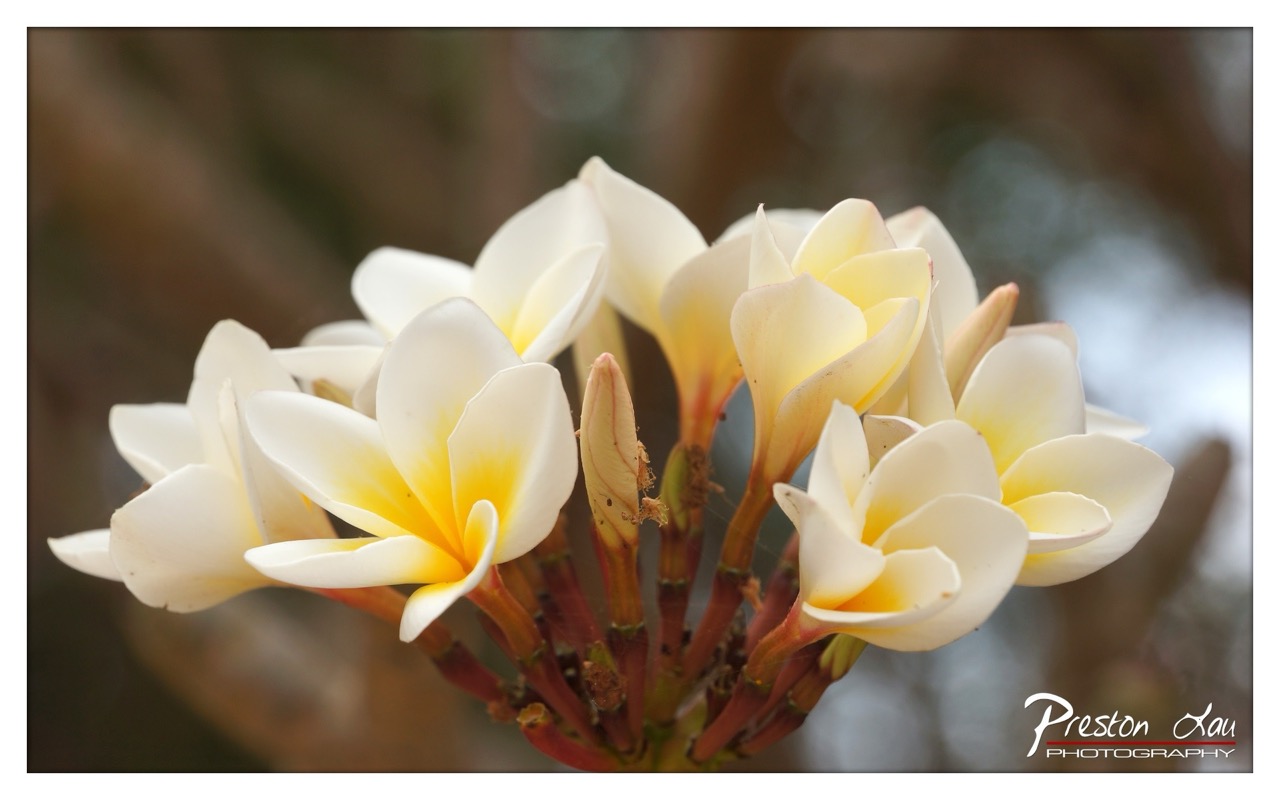

1. Overall Rating (0–10) — 7.5
This image captures the delicate elegance of a cluster of frangipani flowers with a soft, dreamlike quality that draws the eye into its gentle bloom. The shallow depth of field beautifully isolates the subject, emphasizing the natural grace of the petals and their subtle color gradient. While the composition is strong and the mood serene, a slightly more intentional arrangement of the blooms could enhance visual harmony.
2. Composition (0–10) — 7.0
The flowers are centered with a slight asymmetry that adds natural movement, though the inclusion of a few unopened buds on the left edge slightly disrupts the balance. A tighter crop might improve focus and cohesion.
3. Lighting (0–10) — 8.0
Soft, diffused light enhances the texture and translucency of the petals, creating a warm glow without harsh shadows. The light appears to come from the side, adding subtle dimension and depth.
4. Color & Tone (0–10) — 8.5
The creamy white and pale yellow hues of the flowers contrast beautifully with the earthy brown tones of the stems and the muted background. The warm color palette enhances the tranquil, tropical feel of the image.
5. Creativity (0–10) — 7.5
The photographer’s choice to emphasize the natural arrangement of the blossoms, including the subtle imperfections of the buds and stems, adds authenticity. The image feels both serene and alive, capturing a quiet moment in nature with sensitivity.
6. Technical Quality (0–10) — 8.0
Sharp focus on the foreground flowers, with a smooth, pleasing bokeh in the background, demonstrates strong technical control. The image is clean, well-exposed, and free of distracting artifacts.
7. Emotional Impact (0–10) — 8.0
The image evokes a sense of peace and quiet beauty, inviting the viewer to pause and appreciate the delicate intricacy of nature. The soft tones and gentle composition foster a meditative, calming response.
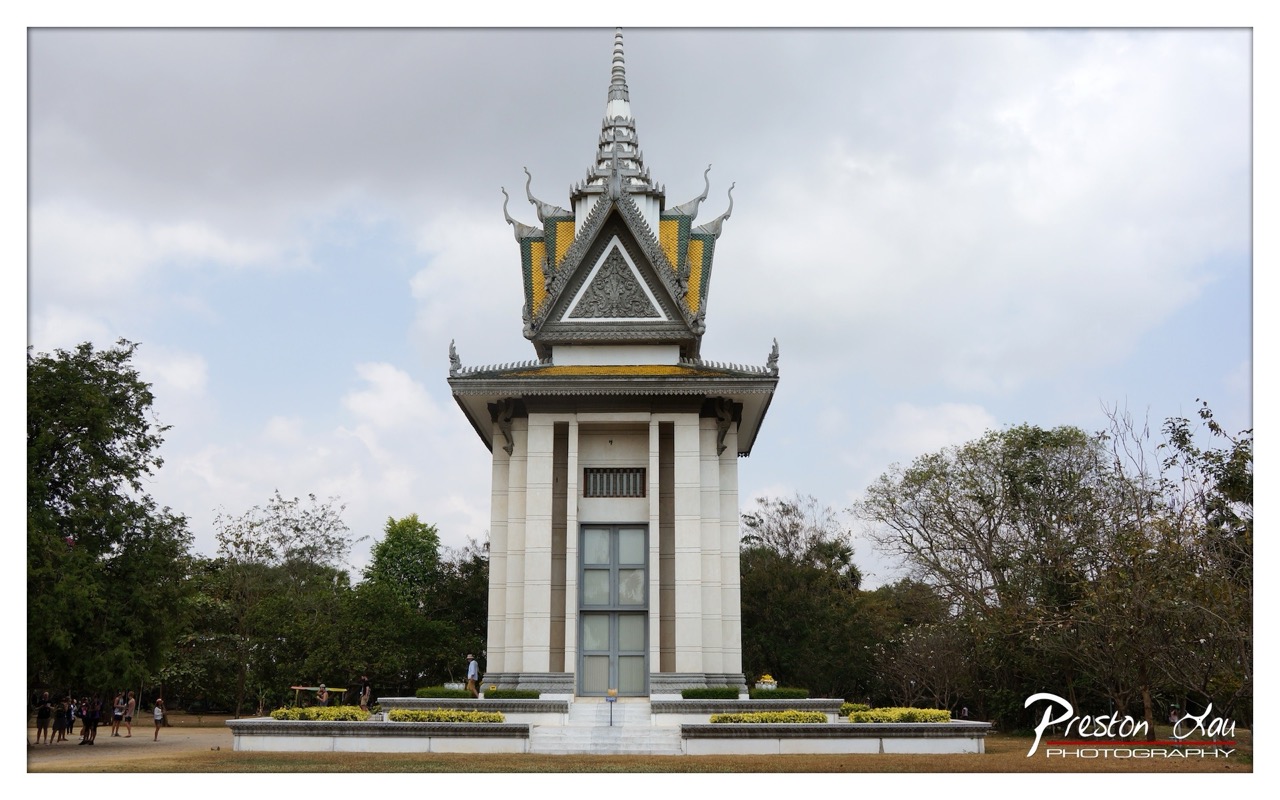

1. Overall Rating (0–10) — 7.0
This photograph captures the serene dignity of a traditional Cambodian stupa under a soft, overcast sky, where architecture and nature coexist in quiet harmony. The structure’s ornate roof and symmetrical form stand out against the muted backdrop, conveying both cultural reverence and structural elegance. While the lighting tempers the vibrancy of the colors, the image successfully balances architectural detail with atmospheric subtlety, offering a contemplative view of heritage.
2. Composition (0–10) — 8.0
Centered framing emphasizes the stupa’s symmetry and verticality, drawing the eye upward. The surrounding trees and pathways create a natural frame, adding depth and context without distracting from the main subject.
3. Lighting (0–10) — 6.5
Diffused light from the overcast sky softens shadows and evenly illuminates the structure, enhancing texture and detail. While the lack of direct sunlight mutes the warmth of the colors, it contributes to the image’s calm, meditative tone.
4. Color & Tone (0–10) — 6.0
The palette is restrained, with soft whites, grays, and earthy greens dominating. The yellow and green accents on the roof add subtle contrast but are subdued by the cloud cover, giving the image a muted, almost monochromatic feel.
5. Creativity (0–10) — 7.0
The photographer emphasizes the stupa’s cultural significance through deliberate composition and a focus on architectural detail. The inclusion of people in the foreground adds scale and narrative, grounding the image in a living context.
6. Technical Quality (0–10) — 8.0
The image is sharp and well-focused, with clear details in both the stupa’s ornamentation and the surrounding foliage. The depth of field is well-managed, ensuring both the structure and the background remain visually coherent.
7. Emotional Impact (0–10) — 7.5
The photograph evokes a sense of peace and reverence, inviting the viewer to reflect on cultural heritage and spiritual space. The quiet atmosphere and restrained color palette foster a contemplative mood, creating a strong emotional connection to the site.
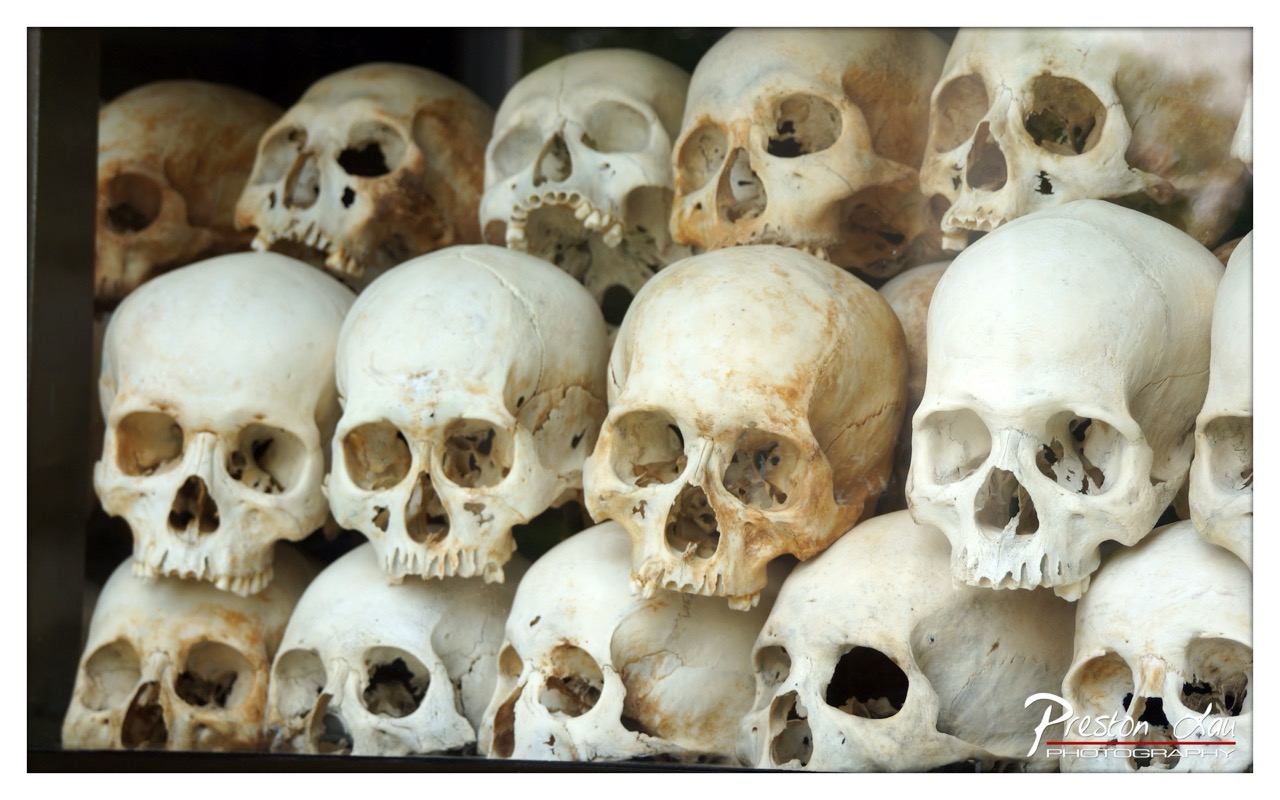

1. Overall Rating (0–10) — 7.0
This photograph confronts the viewer with a haunting, densely packed arrangement of human skulls, evoking a solemn meditation on mortality and memory. The composition’s raw intensity and the stark contrast between light and shadow amplify the somber mood, though the sheer density of the subjects risks overwhelming the eye. While the image is emotionally charged and visually arresting, its power is tempered by a lack of compositional clarity and subtle visual refinement.
2. Composition (0–10) — 6.0
The skulls fill the frame densely, creating a sense of claustrophobia and visual overload. The lack of clear focal point or leading lines diminishes the image’s narrative coherence, making it feel more like a collection than a cohesive composition.
3. Lighting (0–10) — 6.5
The lighting is directional, casting deep shadows that accentuate the texture and contours of the skulls. However, the contrast is uneven, with some areas underexposed, reducing detail in the darker regions and giving the image a slightly flat quality in the highlights.
4. Color & Tone (0–10) — 7.0
The palette is limited to earthy whites and browns, enhancing the aged, skeletal appearance of the skulls. The monochromatic tone supports the solemn atmosphere, though the subtle variations in staining add texture and depth, keeping the image visually engaging.
5. Creativity (0–10) — 7.5
The image is striking in its subject matter and conceptual weight, offering a powerful commentary on death and remembrance. The choice to present the skulls in such close proximity is bold and evocative, transforming a macabre scene into a contemplative visual statement.
6. Technical Quality (0–10) — 7.5
The image is sharp and detailed, with clear focus across the frame. The depth of field is adequate, though slight softness in the background suggests a wide aperture, which may have been used intentionally to emphasize the foreground skulls.
7. Emotional Impact (0–10) — 8.0
The emotional weight of the photograph is profound, evoking awe, unease, and reflection. The sheer number of skulls and their lifeless gaze create an overwhelming sense of loss and history, compelling the viewer to confront the fragility of life and the legacy of human suffering.


1. Overall Rating (0–10) — 6.8
This photograph captures a candid moment of three tourists at a ticket window, offering a glimpse into everyday travel in a foreign locale. The natural posture and interaction of the figures lend authenticity, while the details—like the signage and motorcycle—anchor the scene in a specific cultural context. The image’s strength lies in its documentary realism, though it falls short of visual elegance due to a slightly cluttered frame and underwhelming lighting.
2. Composition (0–10) — 6.0
The subjects are well-placed in the center, drawing attention, but the left side feels underutilized with empty wall space. The motorcycle and large vessel on the right create a visual imbalance, slightly distracting from the main action.
3. Lighting (0–10) — 5.5
The scene is lit by harsh, direct sunlight, creating flat highlights and deep shadows that flatten the image’s depth. While the light is functional, it lacks subtlety and fails to enhance the mood.
4. Color & Tone (0–10) — 6.0
The palette is dominated by muted earth tones, punctuated by the bright red and orange bag. The colors feel somewhat washed out, and the lack of vibrancy reduces the visual appeal despite the contrast.
5. Creativity (0–10) — 6.5
The image captures a genuine, unposed moment, emphasizing cultural observation over artistic manipulation. The inclusion of the “Foreign Visitor 65” sign adds narrative intrigue, though the overall composition is more observational than expressive.
6. Technical Quality (0–10) — 7.5
The focus is sharp on the subjects, and the resolution is clear. The watermark is unobtrusive, and the exposure is mostly balanced, though some highlights are slightly blown out.
7. Emotional Impact (0–10) — 5.8
The image evokes a sense of quiet travel and curiosity, but the lack of emotional depth in the lighting and composition keeps the viewer at a distance, preventing a stronger connection.
Loading map...